
Home » Travel Guides » Romania » 15 Best Things to Do in Cluj-Napoca (Romania)

15 Best Things to Do in Cluj-Napoca (Romania)
A dynamic and youthful university city, the capital of Transylvania is Romania’s second most populous urban centre. True to Transylvania’s Saxon background, Cluj-Napoca is endowed with Gothic wonders like the Stunning St Michael’s Church and the Reformed Church.
Cluj-Napoca also has an exciting historical legacy as the home of Hungarian dukes and the birthplace of the 15th-century Hungarian King Matthias Corvinus, who is remembered with an imposing statue in front of St Michael’s.
For culture you can get acquainted with rural customs and history at the Ethnographic museum, which has a terrific outdoor exhibition with hundreds of reconstructed houses. There’s also a nationally-renowned Botanical garden, elegant parks and an epic gorge waiting for you just outside the city.
Let’s explore the best things to do in Cluj-Napoca :
1. St Michael’s Church

Cluj-Napoca’s heavyweight sight is this stunning 15th-century Gothic church on Unirii Square.
With three equal naves, and measuring 70 metres long and 80 metres high, few churches in Romania can match St Michael’s for power as well as sheer depth of history.
The 15th-century King of Hungary and Croatia Mathias Corvius, was crowned in this building not long after its completion in 1464. Almost 500 years later there was another important moment when the Bishop Áron Márton spoke out openly against the Holocaust at this church, even while Jews were still being kept in the Kolozsvár Ghetto.
After renovations in the 20th century, frescoes going back to the 1400s were revealed in different parts of the church.
The most complete of these can be seen in the southwestern Schleunig Chapel.
In the 18th century the Cluj-born sculptor Johannes Nachtigall carved the highly elaborate pulpit and altar to the Three Kings.
2. Cluj-Napoca Art Museum

On the other side of Strada Iuliu Maniu, the Bánffy Palace is a stately partner to St Michael’s Church.
This 18th-century Baroque residence was designed by the German architect Eberhard Blaumann and was built in the mid-1770s for the Hungarian Duke György Bánffy.
Among a lofty roll-call of guests is the Holy Roman Emperor Francis II who visited with his wife Caroline Augusta in 1817. The museum inside has works by some of Romania’s most celebrated painters like the Impressionist Ion Andreescu and the Post-Impressionist Nicolae Tonitza.
But even more exciting is the Late Gothic Altar of Jimbor, a 16th-century polyptych with sculpted figures of the Madonna and Child at the centre.
3. Botanical Garden

A few minutes on foot from the Old Town is a 14-hectare botanical garden plotted in the 1920s.
There are 11,000 different species here, planted in greenhouses and a host of individual gardens arranged according to geography or applications like medicine and historic trades.
There’s also an area dedicated to ornamentation and design, where you’ll come across the rosarium, Mediterranean garden and an authentic Japanese garden.
As with all botanical attractions the garden is best visited in spring and summer, but at any time of year you can call in at the Botanical Museum and Herbarium, which has 660,000 sheets of dried plants in cabinets.
4. National Museum of Transylvanian History

To wrap your head around the complex and tumultuous history of Transylvania come to this red pastel-painted building on Piaţa Muzeului.
The exhibits start with Prehistory, taking you through the Palaeolithic and Neolithic periods, into the Bronze and Iron Age, displaying tools, bones, jewellery and ceramics.
There are also Roman Dacian coins and glassware, Medieval documents, weapons and Western European furniture from an array of periods.
A standout exhibit is an Egyptian sarcophagus from the 3rd century BC, as well as some 700 stove tiles dating from the 1300s to the 1800s.
At the time of writing the museum was temporarily closed for renovations.
5. Pharmacy History Collection

Casa Hintz hosts the oldest pharmacy in Cluj-Napoca, dating to 1573. In 1954 a museum opened inside, and over time the collection has grown to 1,800 pieces, giving a comprehensive account of pharmacies and medicine in Transylvania from the 1500s to the 1900s.
These historic pots, bottles, copper stills, glass retorts, scales and books go hand-in-hand with the pharmacy’s original fittings, like a beautiful Baroque mural in the main shop from 1766 and a cabinet with a painting depicting the human lifecycle.
You can also browse some of the bizarre substances that passed for medicine centuries ago, like lobster eyes, Venetian theriac (poison antidote), or mummia (powdered human mummies).
6. Parcul Central

Now more than 190 years old, Cluj’s main park was one of the first public spaces for recreation in Eastern Europe.
Parcul Central is an official historic monument and is bounded by the sleek Cluj Arena to the east and the Someșul Mic river to the north.
Even on freezing days in winter you could head here to walk the graceful alleys, embellished with a magnificent marble fountain, pond, bandstand and the striking old casino building, which is traced by a colonnade.
But of course, summer is when the park comes into its own, when you can dine on the terrace at the island pavilion and rent a pedal boat or rowboat from the jetty.
7. Orthodox Metropolitan Cathedral

Built in ten years up to 1933, Cluj-Napoca’s Orthodox Cathedral is a revival of the Brâncovenesc style, which first appeared at the end of the 17th century and mixed Byzantine and Renaissance architecture.
The main dome has shades of the Hagia Sophia in Istanbul, and is watched by four towers, each with semicircular arches.
Inside, that central dome is held up by 18 hefty columns.
The spectacular interior mosaics date to 2001 and were produced with Murano glass by the artist Virgil Morariu.
These complement the original murals painted at the turn of the 1930s by two professors at Cluj-Napoca’s art academy.
8. Piarists’ Church

Dating from the beginning of the 1720s, this monument is a spot with real historical significance.
It was the first Baroque church in Transylvania, as well as the first Roman Catholic place of worship after the Reformation in the 16th century.
The church was founded by the Jesuits, and then handed to the Piarists when the Jesuit order was suppressed in 1773. The facade is brightly painted in orange and yellow, and has pilasters, scrolls, a bas-relief of the Holy Trinity above the portal and niches with sculptures.
The interior is even richer, with an altar that rises from the floor to the ceiling and has silver statues of the Jesuit saints Francis Xavier and Ignatius of Loyola.
These are Austrian in origin, while another Austrian, Anton Schuchbauer, carved the exuberant 18th-century pulpit and canopy.
9. Romulus Vuia Ethnographic Park

On the western outskirts is an outdoor museum for a deep insight into Transylvanian rural life.
Established on a hillside in 1929, the park has 200 historic buildings that have been brought here in pieces and rebuilt.
The most beautiful of these are two 18th-century Saxon churches with murals inside, while more than 30 are open and shed light on traditional livelihoods like metalworking, pottery, animal husbandry, stonemasonry, peasant mining and many more.
The houses and workshops have been sourced from across Transylvania and Central Romania, from the Apuseni Mountains in the Western Carpathians to the Székely Land in the Eastern Carpathians.
Follow up with a visit to the Transylvanian Ethnographic Museum in the centre of the Old Town.
10. Reformed Church

On Strada Lupului, this Gothic church has been the main place of worship for Cluj-Napoca’s Calvinist community for almost half a millennium.
It is also the seat of the Transylvanian Reformed Church District, which had 500,000 members at the last count.
The building started out as a Minorite monastery church in the 15th century, and has the style of a German hall church, with a single nave and no transept.
Take a peek inside at the rib vaults, the richly ornamented Transylvanian Renaissance pulpit from 1646 and the organ in the gallery on the west side.
Try to find out when the next concert is scheduled, as the church’s acoustics are first-rate.
11. Casa Matia (Matthias Corvinus House)

At no. 6 on Strada Matei Corvin you’ll be at the birthplace of Matthias Corvinus, King of Hungary and Croatia from 1458 to 1490. Among the most celebrated monarchs of the period, he was born here in 1443 and was the son of the Voivode (like a general or prince) of Transylvania, John Hunyadi.
The house isn’t open to the public as it is used by the Design and Fine Arts University of Cluj-Napoca.
But there are two plaques to mark the importance of the building, which has contained a jail, hospital and museum in its time.
The Gothic ogival portal and mullioned windows give a hint of the age of the house.
12. Matthias Corvinus Monument

Fronting St Michael’s Church on Union Square(Piața Unirii) is a solemn, larger than life-sized statue of the 15th-century king.
The work of the leading Hungarian sculptor, János Fadrusz, the monument was unveiled in 1902 and shows Matthias Corvinus on horseback.
Standing 12 metres tall, it depicts Corvinus’ horse with all four hooves on the ground, and this is believed to show that the king died of natural causes and not in combat.
At the base of the pedestal are four more statues depicting eminent figures from his reign like the Viceroy of Hungary and the Prince of Transylvania, who are both positioned to his right.
13. Lake Tarnița

An outdoor excursion of choice in summer for Cluj-Napoca residents, Lake Tarnița is a water reservoir created by the Tarnița Dam in 1974. An easy 20 minutes west of the city, the reservoir is 215 hectares in size and twists between tall hills that have a mantle of forest.
You can enquire locally about activities on the lake, which include boating, jet-skiing and fishing, or you could just pack a picnic and spend a carefree few hours on the shore on a warm day, taking a occasional dip in the cool water.
The shoreline is also a treat for walkers who don’t mind going off track for the best vantage points of the lake.
14. Turda Gorge

If you have a few hours to spare, drive down to this limestone canyon about 30 kilometres south of Cluj-Napoca.
One of Romania’s favourite climbing destinations, the Turda Gorge is almost three kilometres long, with walls that reach 300 metres.
The surfaces are riddled with around 60 caves, most of which are no more than a few metres deep, while the largest burrows into the rock for 120 metres.
These cavities were inhabited during the Neolithic period.
Walkers can choose to stay low by the river or battle up the gradient to view the gorge from above, which is difficult but merits the effort.
15. Kürtőskalács

Whenever there’s a public event in Transylvania you’ll catch the inviting scent of this “spit cake” on the air.
Kürtőskalács originated with the Hungarian population in the Székely Land to the east and is a simple cake made in a rather complicated way.
A dough made with flour, milk, sugar and yeast is poured onto a cylindrical mould and then turned over a glowing charcoal and basted with butter until golden brown.
When the mould is removed you get a hollow cake that is then normally coated with sugar and chopped walnuts and goes perfectly with coffee.
15 Best Things to Do in Cluj-Napoca (Romania):
- St Michael's Church
- Cluj-Napoca Art Museum
- Botanical Garden
- National Museum of Transylvanian History
- Pharmacy History Collection
- Parcul Central
- Orthodox Metropolitan Cathedral
- Piarists' Church
- Romulus Vuia Ethnographic Park
- Reformed Church
- Casa Matia (Matthias Corvinus House)
- Matthias Corvinus Monument
- Lake Tarnița
- Turda Gorge
- Kürtőskalács
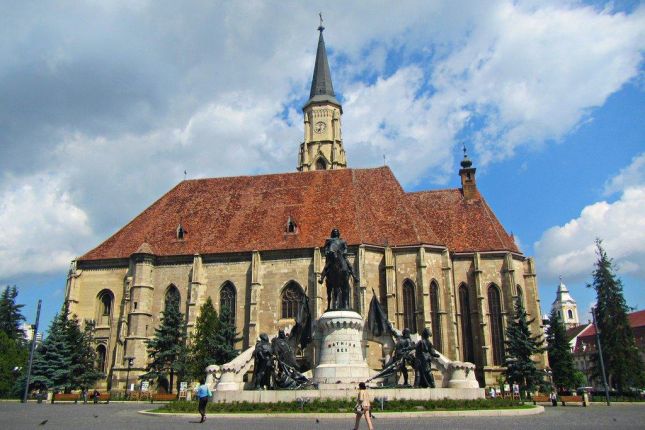
35+ Best Things to Do in Cluj-Napoca & Places to Visit
Cluj-Napoca (or simply Cluj) is Romania's second-largest city with a vibrant personality: young-hearted and always up to something, a major cultural and university hub full of creative energy and good vibes!
With a mix of medieval landmarks, historical sites, architectural jewels, trendy urban hotspots, cobblestone streets, and numerous events, Cluj is a laid-back city where people live unrushed - despite its fantastic growth since Romania joined the European Union in 2007.
La Cluj - as locals say in Cluj - everything is slower.
It's also one of the most visited cities by tourists since it's ideally located in Central Romania which makes it a good base to explore the famous regions of Transylvania, Maramures, and Bucovina. And you'll find lots of low-cost flights from all over Europe to get here!
- check our practical travel guide on how to visit Romania for the first time to make planning your trip easier
In this Cluj-Napoca travel guide we listed over 35 of the best things to do in Cluj, popular attractions for day trips in Cluj county, local favorites as well as lesser known sights and activities you should consider.
Table of contents
What makes Cluj Napoca worth visiting?
How to discover the best places to visit in cluj napoca, 1. start exploring cluj from avram iancu square, 2. admire the architectural mix of cluj-napoca, 3. take a stroll on the main street, eroilor boulevard, 4. visit union square and its landmarks, 5. enjoy nature in central park, 6. discover the interwar architecture of cluj and enjoy somes river, 7. admire the city from cetatuia hill, thirsty for culture, 8. taste the rural life at the romulus vuia ethnographic park, 9. check romanian aesthetics at the ethnographic museum of transylvania, 10. visit the national museum of transylvanian history, 11. admire the art at the cluj national art museum, 12. discover the oldest building in cluj: matthias corvinus house, 13. take your time to visit small art galleries, 14. go to the artisan fares to meet local craftsmen, 15. visit cluj during cultural events, 16. visit one of oldest still-in-service churches: the franciscan church, 17. admire byzantine architecture at the assumption cathedral, 18. go to a concert at the reformed church, 19. visit the charming face-to-face greek-catholic cathedral, 20. smell the beauty at the botanical garden, day trips from cluj-napoca to visit transylvania, 21. see the #1 underground attraction in the country: turda salt mine, 22. visit the most authentic medieval castle in transylvania: corvin castle, 23. make a stop at the alba iulia citadel, 24. visit unesco-listed sites: sighisoara citadel and fortified saxon villages, 25. go deeper, and discover traditional regions of romania, 26. go on a hike in the apuseni mountains, 27. visit a traditional region in apuseni mts, 28. admire a natural reserve: turda gorges, 29. go to the charming village of rimetea and hike to piatra secuiului, 30. enter a space of mysteries at the hoia baciu forest, 31. visit the popular banffy castle, 32. go horse riding in the hills of transylvania, where to go out in cluj-napoca. best restaurants in cluj, 33. enjoy a tasty blend of fancy and classic flavours, 34. taste traditional romanian food, 35. discover the specialty coffee culture in cluj, 36. go out for drinks in museum square, 36. mingle with students on piezisa street, how to get to cluj-napoca, public transportation in cluj-napoca. from airport to city center, where to stay in cluj-napoca.
View this post on Instagram A post shared by We Are Cluj (@wearecluj)
Why do locals all over Romania talk about the friendly people and easy-going vibe of Cluj-Napoca?
Simple: it's a bustling university city with a creative spirit, a down-to-earth attitude about work, and a 'chill' vibe - in contrast with the hustle and bustle, 'always in a rush' people in Bucharest.
Locals here are very friendly and it will be easy to interact with them – on a walk through the city, in a coffee shop serving specialty Ethiopian single origin or at one of the famous Romanian festivals taking place in Cluj like the massive Untold festival, the alternative Electric Castle or Transyilvania International Film Festival where some of the best Romanian movies have premiered.
There are many things to do in Cluj because the city is the unofficial capital of Transylvania. Historically, Cluj has always been a cultural and political center in Romania.
Romanians, Hungarians, Germans, and other minorities, with all their customs, faiths, ways of life, and typical dishes have peacefully coexisted here for centuries. So learning about local culture is one of the best things you can do here.
Then there's also Central Park, a hotspot for local life, the Botanical Garden, the best in Romania, and Cetatuia Hill with its great view of the city, to satisfy your needs for 'nature in the city.'
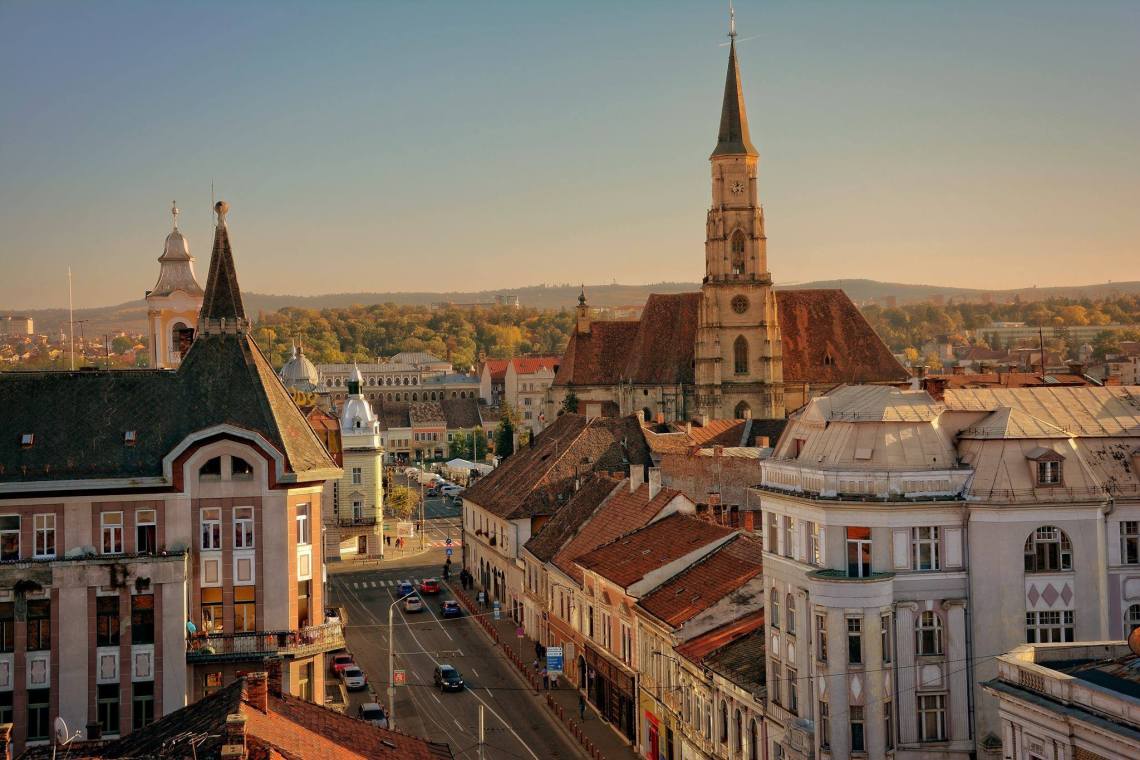
The best way to do some sightseeing and explore Cluj is on foot because the city's landmarks and best places to see are located close to each other in the city centre. In fact, the city’s layout is a huge East-West axis so I suggest you start your walk either from Central University Library or Avram Iancu Square.
If you decide to start exploring Cluj starting from Avram Iancu Square, you will notice the Orthodox Cathedral which you can visit, and the statue of Avram Iancu, a major figure in the history of Transylvania.
View this post on Instagram A post shared by Yolozsvár (@yolozsvaros)
Continue your walking tour on the wide and busy Eroilor Boulevard the main street in Cluj where locals love to go for a walk and hang out. You'll also pass by some of the city's oldest buildings, like the Old Town Hall. Many of them date back to the 16th century when Cluj experienced an economic and cultural awakening and they are top attractions for tourists due to their unique architecture.
- Local tip: while here, take your pick from some of the most popular cafes and bistros which make for a great place to experience the city's local life: Olivo, Koffer, DOT, A la Tarte, Meron or Eggcetera
If you are into architecture then you'll notice how the style changed from constructions that survived from the Renaissance period to the more elegant 19th-century buildings found in the city center and around major squares. Great spots for those passionate about aesthetics, history, and photography!
Continue your walking tour until you reach Union Square (Piața Unirii), a lovely place characterised by 18th century and 19th-century buildings, with its massive St. Michael's Church, an impressive Gothic landmark and one of Cluj's most popular tourist attractions, and the imposing Matthias Corvinus monument in the center.
Union Square is a place full of history. Here, you can also find the Continental Hotel, the place that housed German troops during the Second World War.
Lots of local events and festivals take place in the main square but if not - enjoy the open space and take a look around: no one here is in a rush, locals smile, go slow, and like to grab their coffee and enjoy it in the sun.
And so should you!
- Local tip: notice the details of the imposing statue of Matthias Corvinus, a famous Hungarian king born in Cluj Napoca (then Kolozsvár) in the 15th century.
The history of Hungary and Romania is intertwined beyond administrative borders or nationalist rhetoric. If you want to learn more about the history of Cluj-Napoca and Transylvania, one of our guides has a degree in history and is eager to show you around and tell you more:
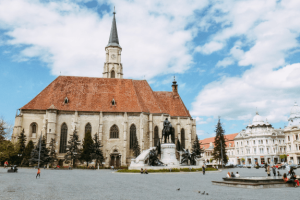
Short Walk & Talk about Cluj-Napoca with a Local
Start from: Cluj-Napoca
Next on your walk should be Central Park (Parcul Central) where you'll see people laying on the grass, hanging hammocks and enjoying life. Go for a walk around Chios Lake too. If there are no local fares in Union Square, maybe they're here, especially during the Summer months.
The park is closed during the Untold festival and I generally don't recommend you visit Cluj Napoca during that time since it's super crowded and expensive.
- Pro tip: at the end of Central Park towards Cluj Arena you'll find local stalls that sell typical Romanian street food: langos (fried dough topped with sour cream, cheese, and garlic sauce), kurtos kalac (sweet bread with topping), cotton candy (a staple of Romanian childhood) and machine-made instant icecream, my favorite :)
Across the road, near the Mill Canal, you'll find lots of well-preserved houses, with beautiful architecture, built between the Two World Wars. If you continue your walk you'll eventually reach the Somes River promenade, another local life hotspot.
If you want a great view over this beautiful city you should cross the river and go up to Cetatuia Hill the perfect place for a panoramic view of the entire city and surrounding hills! You can get there on a short hike going through Cetatuia Park but also by grabbing a taxi. And sunsets here are spectacular and you can enjoy them with a drink at Pergola Cafe.
Then you're in the right place. Thanks to its rich multicultural and humanistic history, Cluj-Napoca was always a place renowned for its culture, and interest in humanities and arts. You'll often visit places including restaurants and cafes where you'll get a sense of how important culture is for one of Romania's biggest cities.
View this post on Instagram A post shared by E Fain La Cluj (@efainlacluj)
The Romulus Vuia Ethnographic Park is the first open-air museum in the country where you will get a taste of rural Transylvania: traditional houses, rural technical installations and wooden churches, and lots of green spaces where you can even chill or have a picnic (closed November - April).
The Ethnographic Museum of Transylvania is the in-door brother of the above, where you'll discover clothing, household and decorative items, lots of pictures, and literature from the past times.
The National Museum of Transylvanian History has a focus on history and archeology, with objects and artefacts dating back to our ancestors, the Dacians. This is one of the best museums in Romania to visit if you want to understand more about the complex history of Transylvania.
Cluj is also known for its artsy vibe where, besides classical arts, contemporary and modernist artists are also featured. Also, photo exhibitions are regularly on display in the main squares or even in cafes. Here is a list of the best places for art lovers.
Cluj-Napoca Art Museum, located next to the University of Arts, hosts various art exhibitions all year long. Explore a diverse collection of over 12,000 paintings, sculptures, graphic arts, and decorative pieces spanning from the 16th to the 21st centuries.
View this post on Instagram A post shared by Discover Cluj | Romania (@discovercluj)
The Matthias Corvinus House (Casa Matias) stands as the birthplace of Matthias Corvinus, the King of Hungary, and ranks among Cluj-Napoca's oldest structures.
Built in the 15th century with Gothic influences, this historic house has served various roles throughout its existence, evolving from a residence to a prison, hospital, and museum. From Union Square go for a walk towards Museum Square and you can't miss it.
Cluj also has its list of small art galleries, such as Iaga Contemporary Art, which hosts about six exhibitions a year. Other small galleries you can visit are Plan B, Bazis Gallery, or Lateral ArtSpace. These galleries exclusively focus on contemporary art, providing art enthusiasts with distinctive perspectives and immersive experiences.
View this post on Instagram A post shared by TIFF Romania (@tiffromania)
Cluj hosts many cultural events, such as the Transylvania International Film Festival (TIFF), Jazz in the Park and others. On the official tourism website of Cluj-Napoca, Visit Cluj , you can find a list of events scheduled for the next period. And since we can't separate Transylvanian culture from its multi-faith background, there are some religious sights worth visiting besides the Orthodox Cathedral and Saint Michael's Church. All of them are located in the city center.
Built between 1260 and 1290, the Franciscan Church stands on the grounds of an earlier Catholic church, destroyed during the Tatar invasions in 1241. Nestled in Museum Square, formerly known as Little Square to distinguish it from Market Square, this location revealed remnants of the Roman city during archaeological excavations. Inside the church, intricate sculptures and an ornate altarpiece grace the interior. The building is classified as a historical monument.
The Assumption Cathedral, also known as the Dormition of the Theotokos Cathedral, is a great example of Byzantine architecture adapted to 20th-century construction exigences. Completed in 1933, it stands as the largest Romanian Orthodox church in Cluj.
Its architectural marvel unfolds in the Romanian Brâncovenesc style, seamlessly blending Renaissance and Byzantine influences. Nestled in Avram Iancu Square, it shares the cultural landscape with the Cluj-Napoca National Theater and the Avram Iancu Statue.
View this post on Instagram A post shared by clujinimagini (@clujinimagini)
The Face-to-face Greek-Catholic Cathedral stands as one of the most beautiful churches in Cluj, and it is my favorite, since I got married here :)
Constructed in the Baroque style, the church is adorned in yellow and features a tall tower, reaching a height of 28 meters, which imparts an ancient charm along Eroilor Boulevard.
You should also consider visiting the Botanical Garden in Cluj-Napoca, the largest and, according to some, most beautiful in Romania. Besides the Rosarium in front of the building, a rose garden with many species, it has many unique sights like the Japanese garden and the Roman garden, both exquisite, which make this an interesting place to visit.
Springtime is the best time to visit it since over 40.000 tulips are on display, making it one of the biggest tourist attractions in Cluj. Find out more about visiting hours on the official website .
Thanks to its location and well-connected public transport, the city is a very good base for the many things to do in Transylvania and for visiting places harder to get to from Bucharest or other parts of the country. So going on short trips to discover Romania's main attractions is one of the best things you can do while in Cluj!
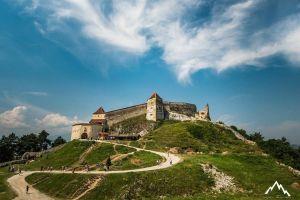
3-Day Transylvania Tour: Cities, Sights & Local Life
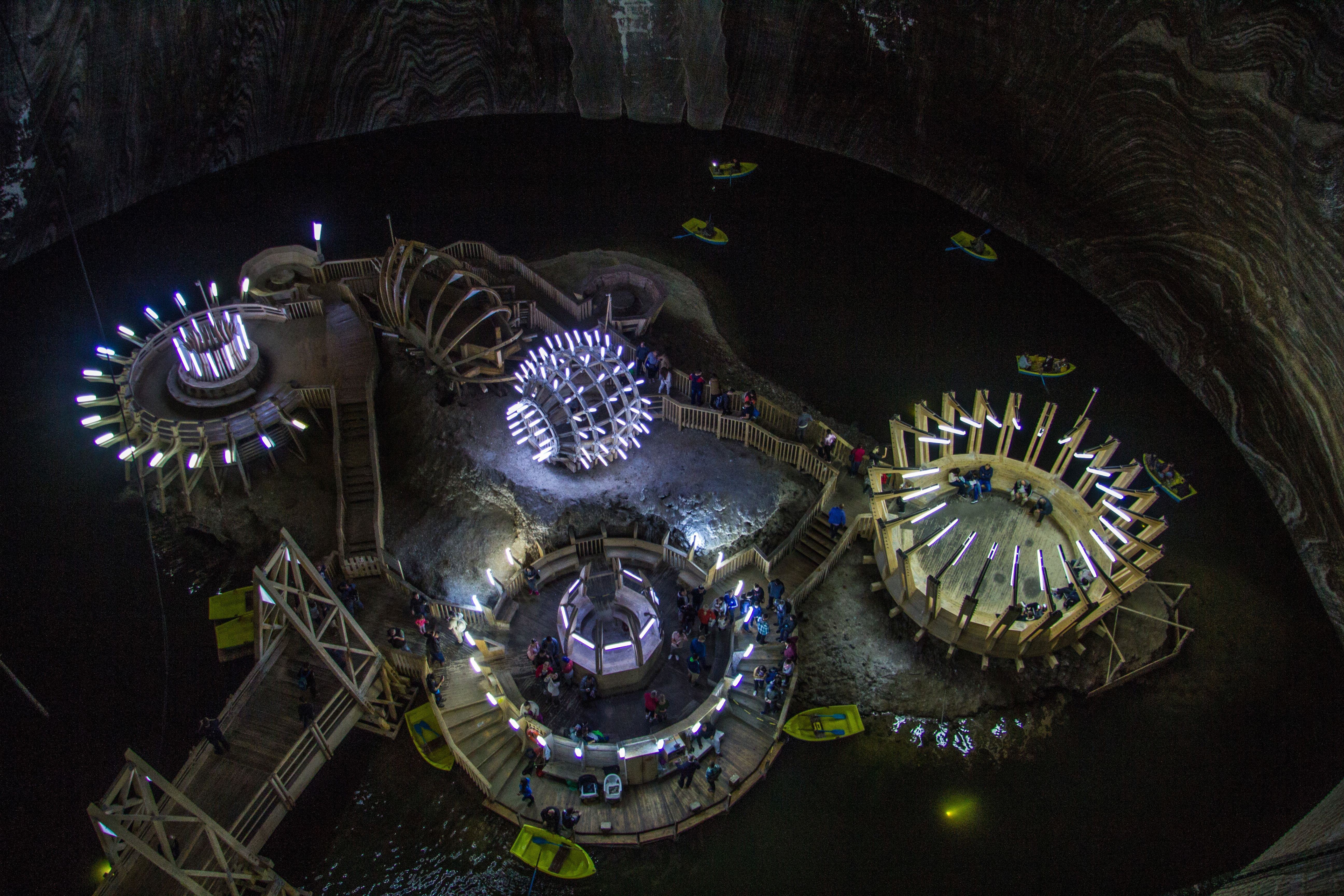
Turda Salt Mine is one of the best attractions you can visit near Cluj-Napoca
Undoubtedly the main attraction near Cluj-Napoca is Turda Salt Mine. Business Insider named Salina Turda as the #1 underground location to visit with beautiful scenery thanks to artfully placed lighting installations. And with a lot of activities for visitors, such as table tennis or mini golf.
Besides breathing salty air which is good for your lungs, there are some awesome things you can do down there too: imagine a 2,000-year-old mine dating back to Roman Empire times with caverns so huge an underground Ferris wheel could be installed! Or boat rides on an underground lake. Wait... what?
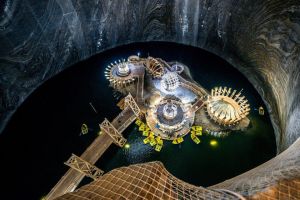
Turda Salt Mine Tours
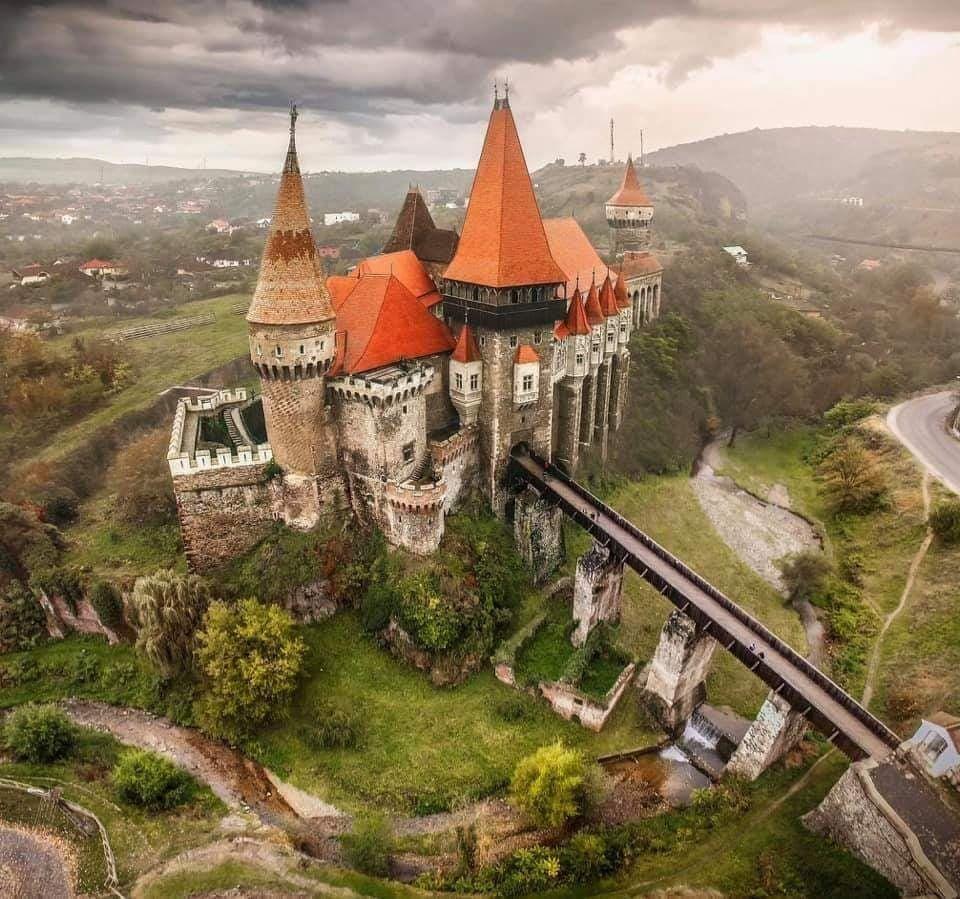
Corvin Castle, the best preserved medieval castle in Eastern Europe
Corvin Castle , a 600-year old Gothic castle may not be the most famous castle in Transylvania. It's hard to compete with Bran Castle aka Dracula's Castle close to Brasov! But in our opinion, it's the most interesting and authentic medieval castle in Transylvania, with real stories and fascinating legends. Unlike Bran Castle (4h away), Corvin Castle can be easily visited on a day trip from Cluj-Napoca .
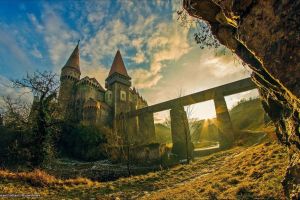
History Day Trip: Corvin Castle & Alba Iulia Citadel
On your way to Corvin Castle, you can stop at Alba Iulia Citadel . The spiritual capital of Romania where the Great Union of 1918 took place when Transylvania joined Wallachia and Moldova, this five-point citadel dating back to the Roman Empire is worth a short trip.
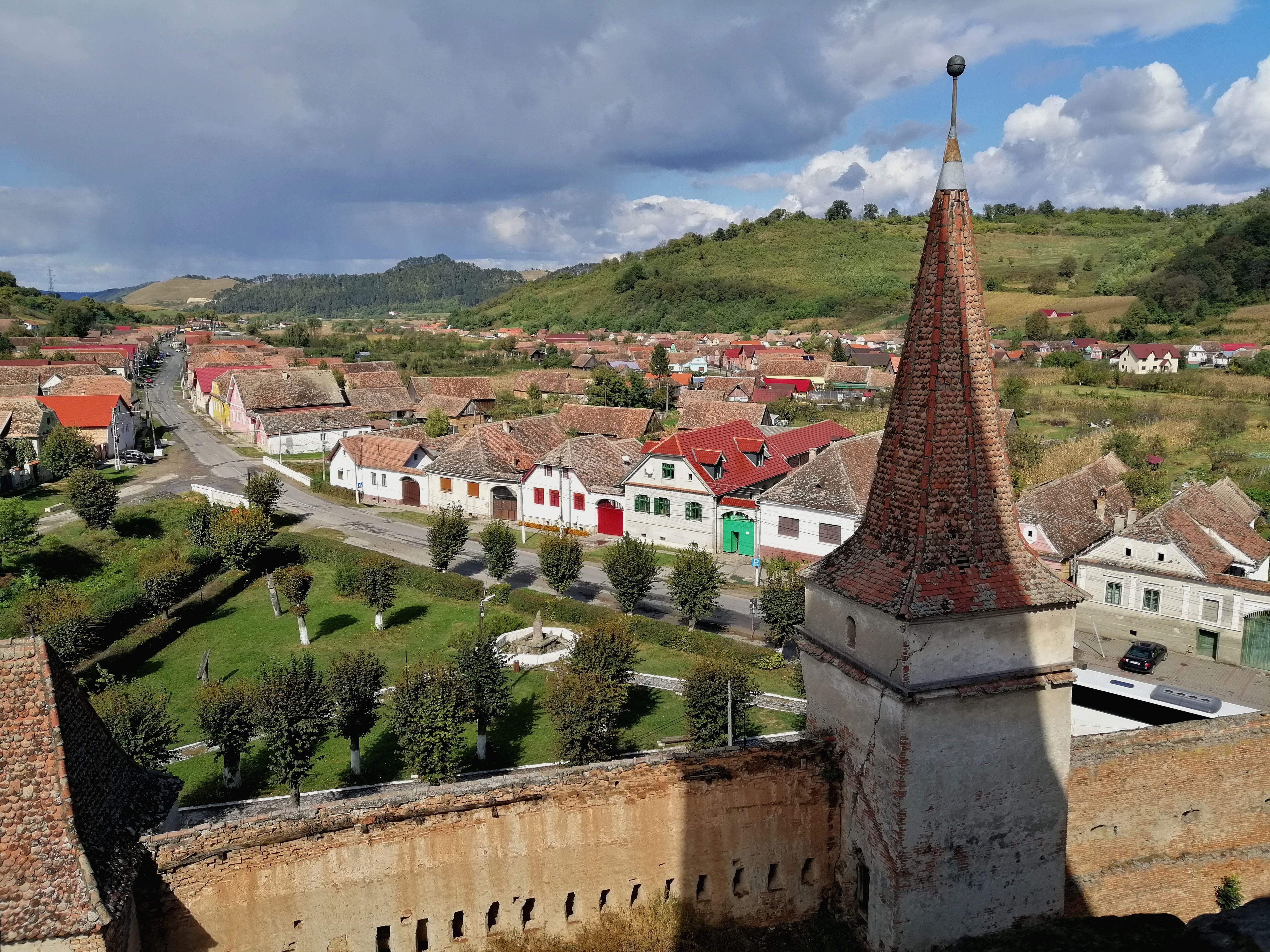
A typical Saxon village in Transylvania
Among the other most popular places for tourists to visit Transylvania are the famous Sighisoara Citadel and the Saxon villages with fortified churches all part UNESCO heritage. On a day trip to these sights, it will be easier to understand the complex Transylvanian history and culture, while admiring the beautiful views of the region, famous for its mellow hills and picturesque village life.
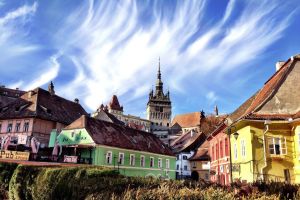
Tour of Transylvania's Countryside: Sighisoara Citadel & Fortified Villages
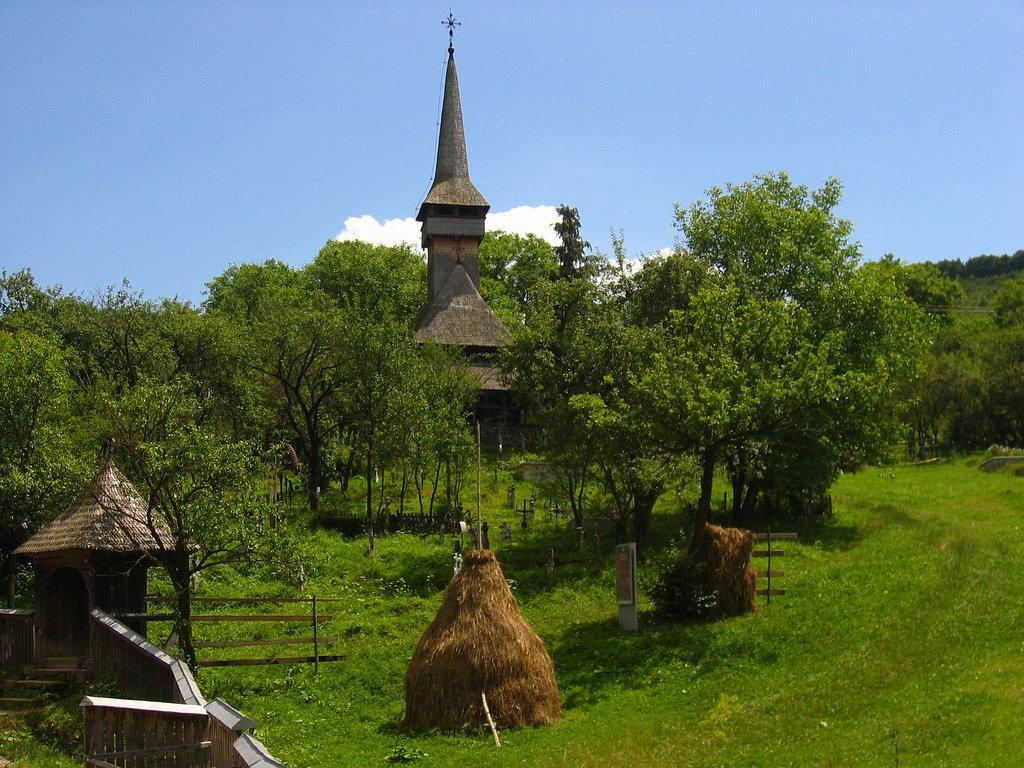
If you're interested in authentic Romanian culture and want to experience the traditional rural life for which our country is so famous for, then Cluj-Napoca is the perfect place to go on trips to discover the traditional regions of Maramures (N-W) or Bucovina (N-E).
Both are equally considered the most authentic and ethnographically representative regions of Romania. They're famous for their local crafts (wood caving, egg painting), and for their many customs and traditions kept alive by locals, including how they dress up in folk costumes to go to church on Sunday.
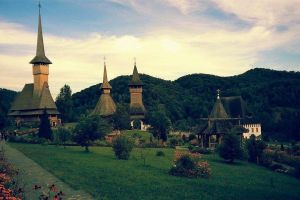
2 or 3 Days in Maramures: Wooden Churches, Traditions & Village Life
Besides the jaw-dropping sceneries and homegrown delicious food, each region has many tourist attractions spread across villages in the region. In Maramures you can visit the UNESCO Wooden Churches , while in Bucovina the famous UNESCO Painted Monasteries . Whatever you choose - both regions are fascinating and perfect for slow travel meaning you'll need min 2-3 full days for each one.
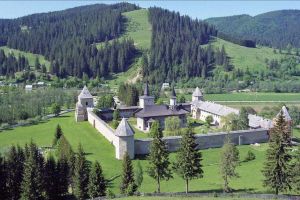
5-Day Complete Tour of Traditional Maramures & Bucovina
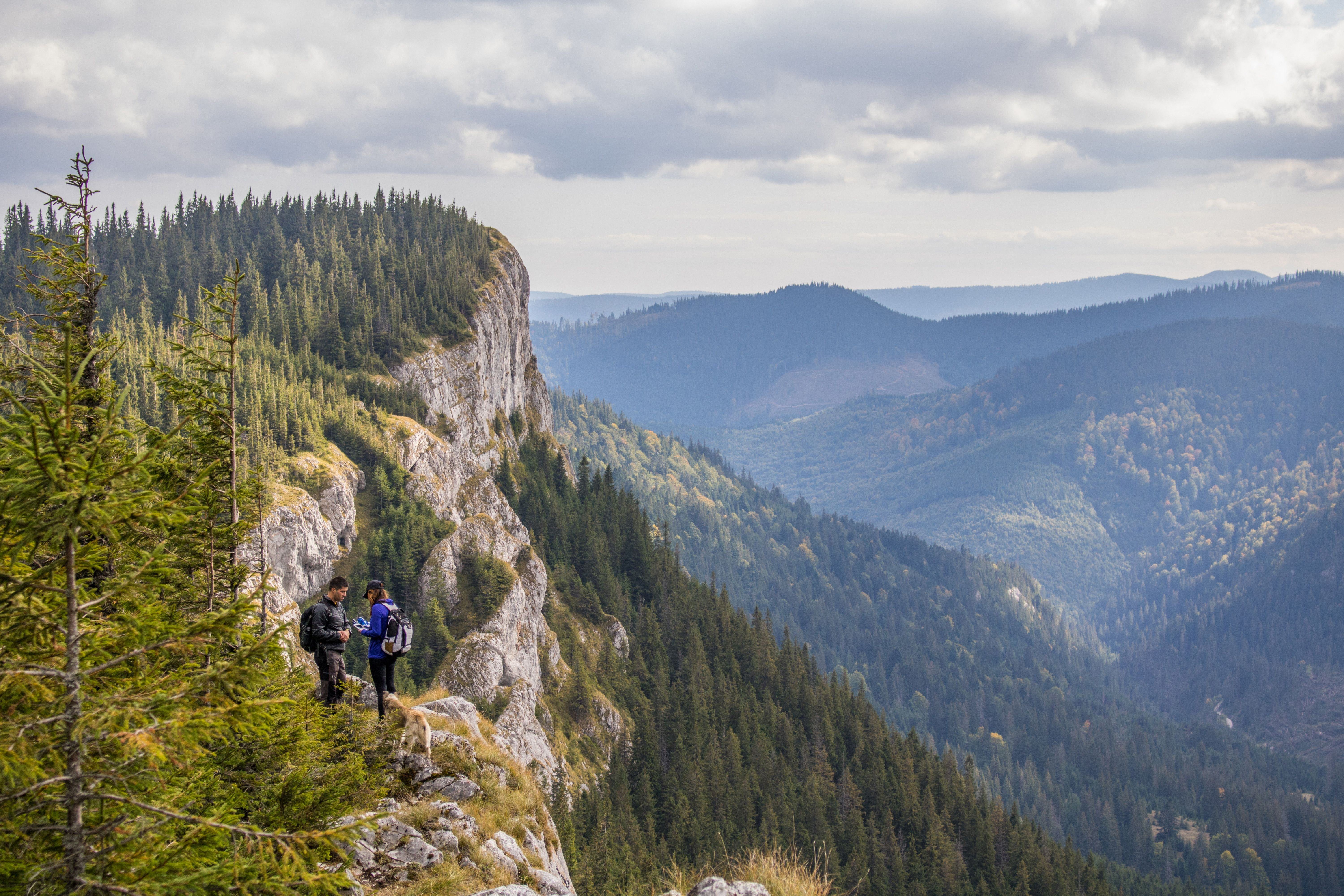
Amazing views in Apuseni Natural Park close to Cluj
One of our favorite things to do from Cluj-Napoca - that few people know about - is to go hiking in Transylvania. Our article will tell you more about Romania's huge and underrated outdoor potential.
Cluj Napoca is close to the Western Carpathian Mountains, locally known as the Apuseni Mountains. Generally considered as medium difficulty mountains, the highest peaks are Curcubata Mare at 1,849m and Vladeasa Peak at 1,836m which can be summited in a one-day hiking trip from Cluj with our experienced mountain guide.
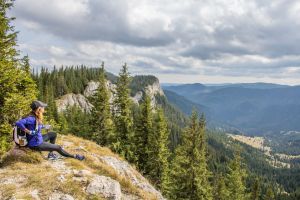
1 or 2-day Hiking Tour from Cluj: Wild Trails in Apuseni Natural Park
Besides the numerous hiking trails for all difficulty and experience levels, there are lots of natural attractions too such as Scarisoara Ice Cave, Rusty Ravine, Bride's Veil Waterfall, White Cliffs (Pietrele Doamnei) and Scarita Belioara Reserve.
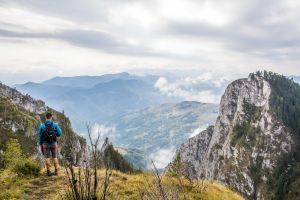
Hike to a Unique Natural Reserve in Apuseni Mountains
These can be seen on hiking day trips or multi-day trips that will also take you through picturesque villages. And there are over 150 caves most of which you can visit and some perfect for caving speleological exploration!
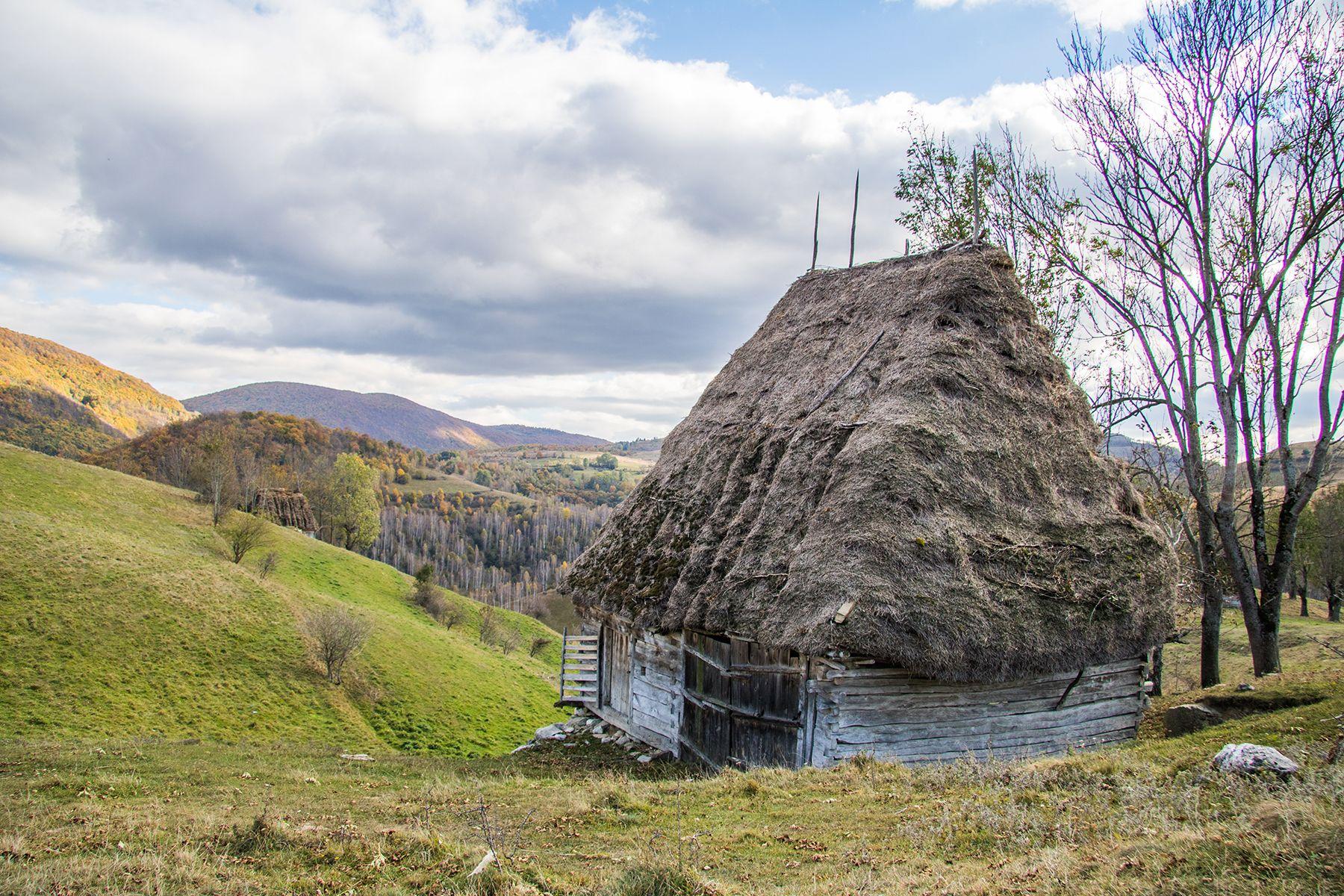
And in Apuseni Mountains specifically in Apuseni Natural Park there is another ethnographically representative region known as Țara Moților where locals live as they used to decades ago, undisturbed by modern civilisation. So besides hiking and visiting natural attractions, this is the best place to experience life in rural Transylvania authentically.
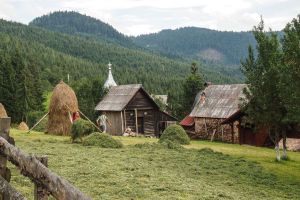
2 Day Hiking in Apuseni Natural Park: Culture & Local Life
Start from: Cluj-Napoca or Sibiu
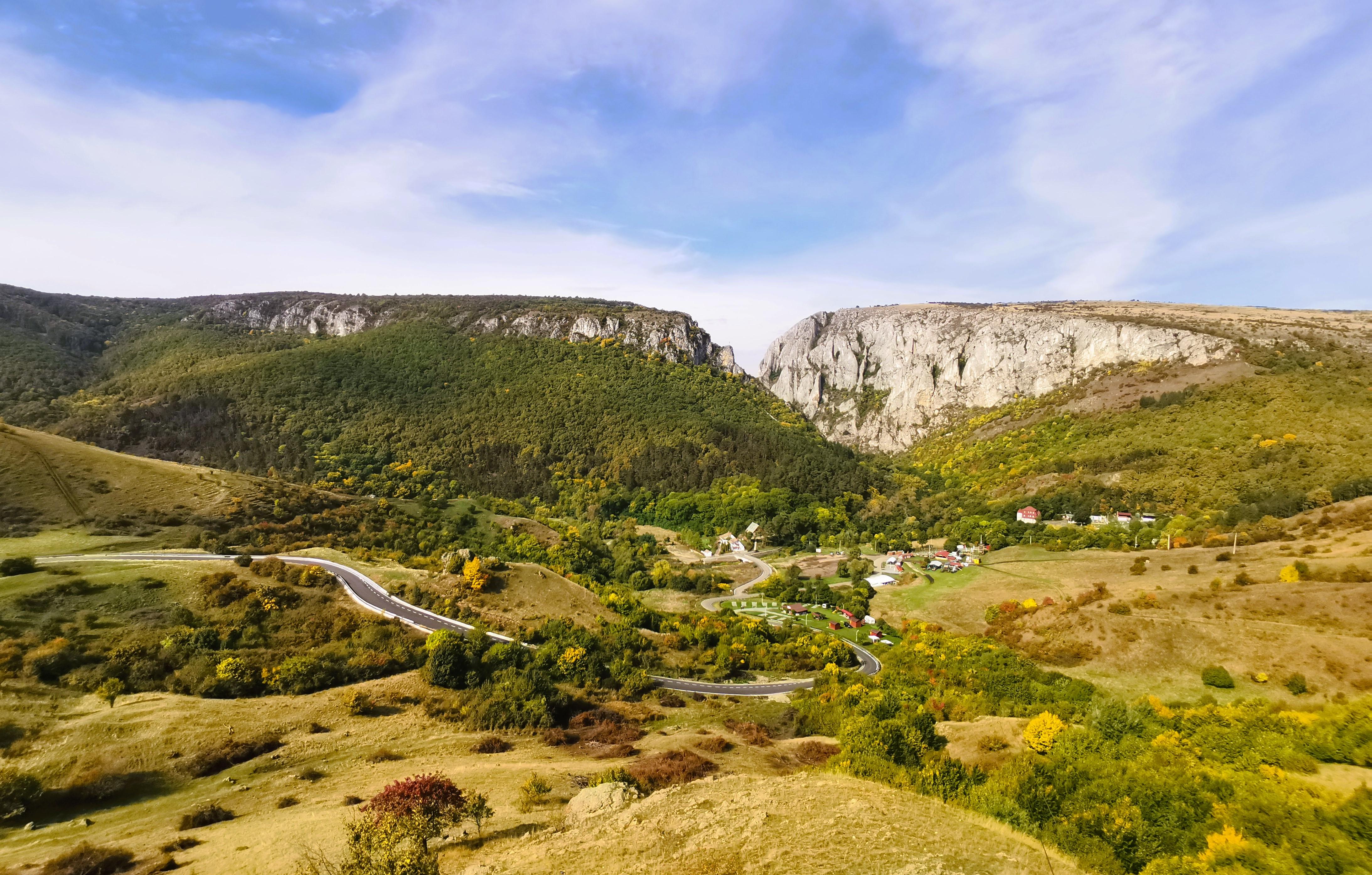
Other popular natural attractions near Cluj are Turda Gorges (Cheile Turzii) a superb area that will close you off from civilisation with fresh air and lots of vegetation. A hiking trip in Turda Gorges to the top will last about 4h but you can also learn via ferrata with our specialist guide if you're up for it.
For a nature lover, this is the perfect place to be.
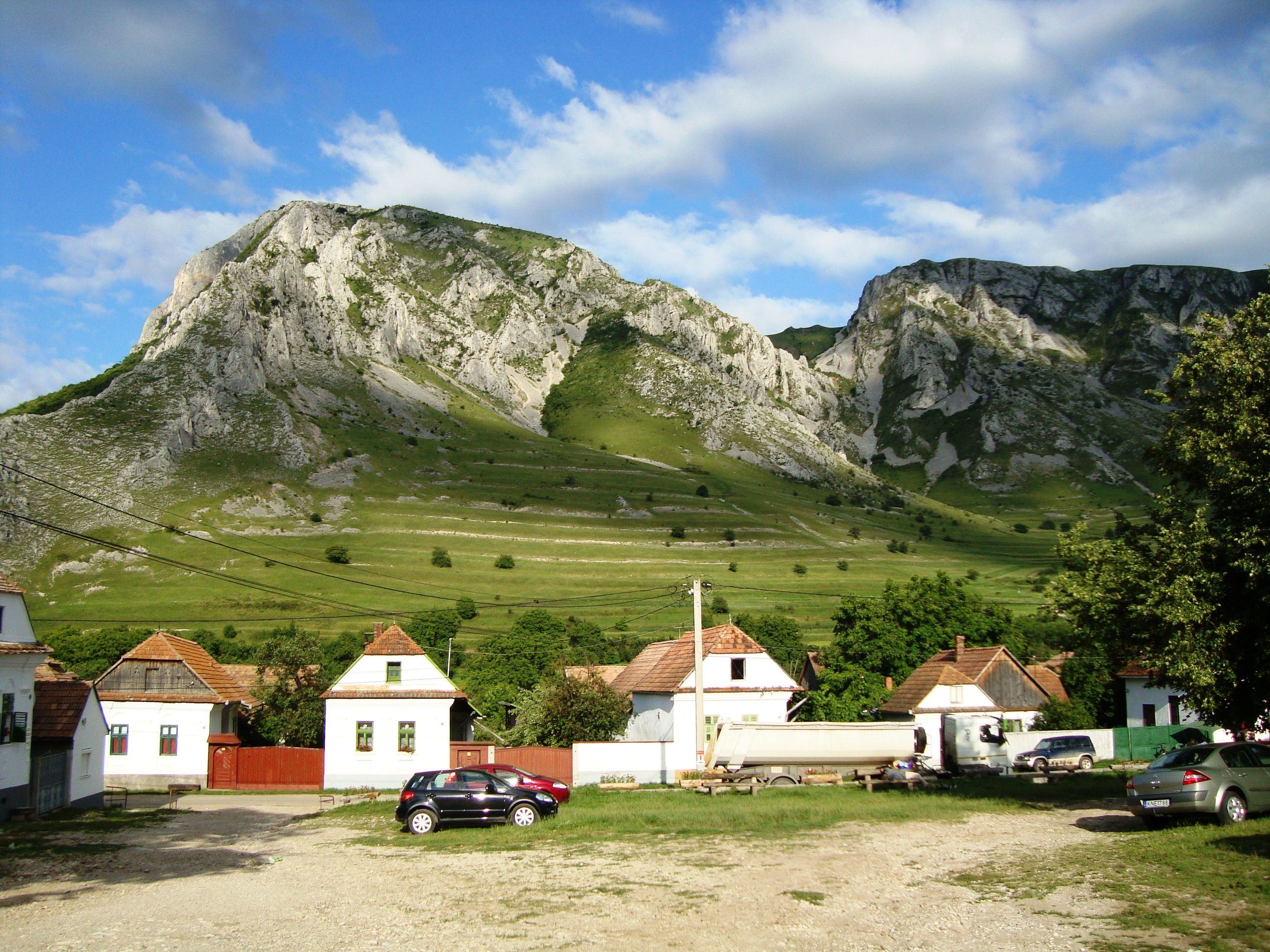
Another popular route - though more difficult - is Szekler's Stone (Piatra Secuiului) in the charming ethnic-Hungarian village of Rimetea. Towering and imposing, this hiking day trip will be rewarding for sure.
- Local tip: you may read about Tarnita Lake outside of Cluj; but other than private houses, there's no real infrastructure for tourists to enjoy the area - so I wouldn't recommend you bother going there.
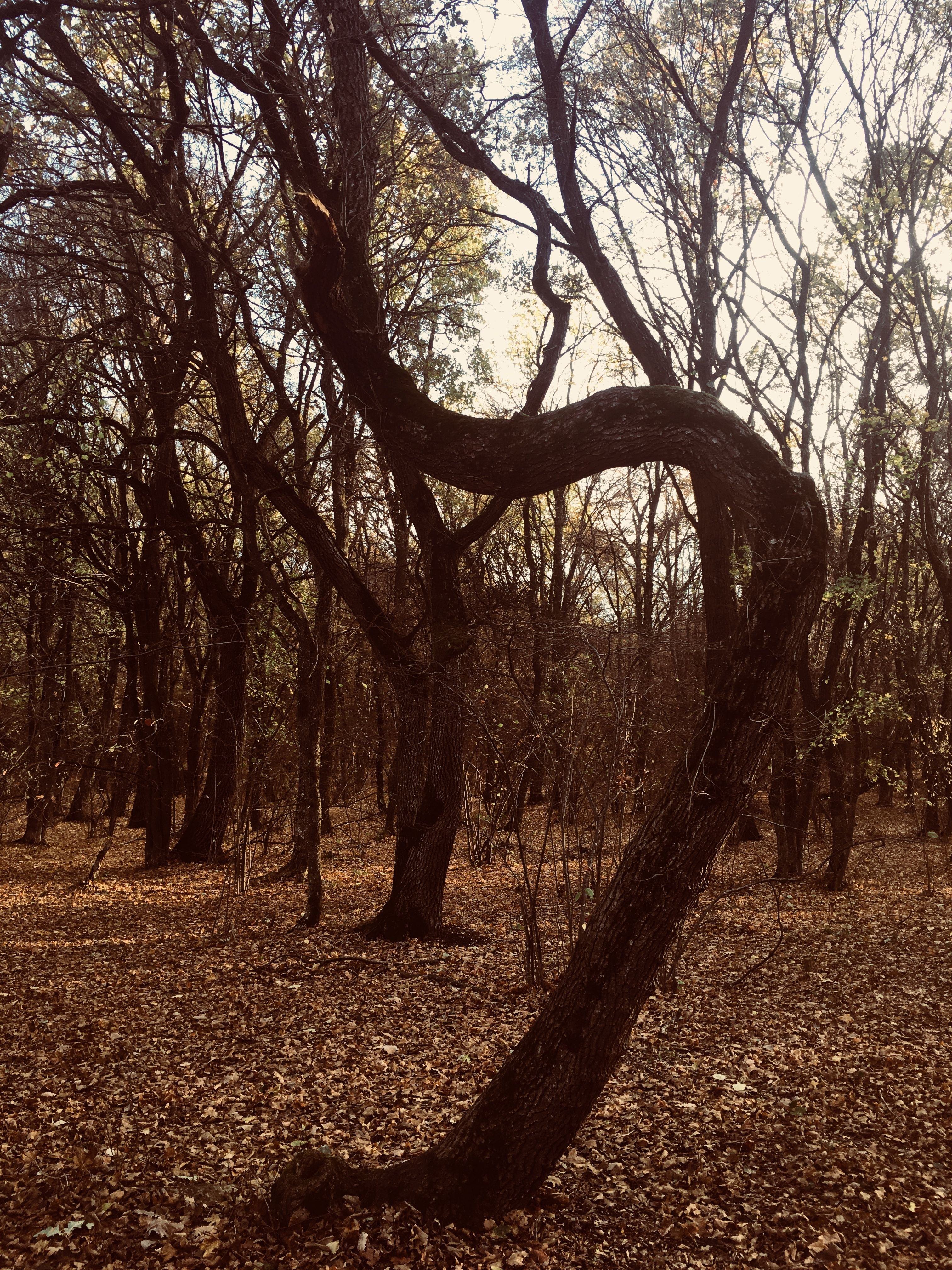
The haunted forest of Romania: Hoia Baciu
Now time for something completely different - did you know there is a forest near Cluj-Napoca said to be haunted?
It's called Hoia Baciu after a shepherd disappeared here without a trace with his entire flock. It's also where UFO sightings were photographed 50 years ago, with strange readings recorded ever since. And the vegetation in the forest is... weird. Like, there's a perfectly round huge clearing where grass doesn't grow above a certain level. And, obviously, no one mows it!
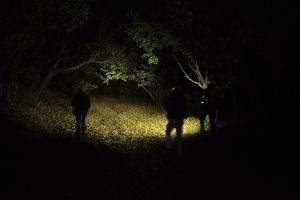
A Night Tour of Haunted Hoia Baciu Forest
Start from: Cluj - Napoca
I know what you're thinking - hard to believe! Same for me until I went with our guide who is super passionate about this attraction on a tour in Hoia Baciu forest with special measuring equipment. I like mysteries and this is by far a unique thing to do and an unusual place in Cluj-Napoca!
Near Hoia Baciu Forest, you can also find the oldest human settlement near Cluj and the oldest in Transylvania, dating from the Neolithic Period, Gura Baciului.
Bánffy Castle, located in Bonţida near Cluj-Napoca, stands as an architectural marvel with influences spanning Renaissance, Baroque, Neoclassical, and Neogothic styles. Owned by the Hungarian Bánffy family, the castle has been repurposed, housing an Art Cafe since 2001, while the Trust has established an educational center in the Miklós building. Various parts of the castle, including the former chapel, stables, and main building, serve as venues for cultural events and programs.
In recent years, Banffy Castle has emerged as a host for music festivals, which turned it into a popular spot near Cluj. If you're thinking of going to Electric Castle , one of Romania's most popular events - don't think twice!
Taking place on the Banffy domain, this festival showcases a dynamic blend of electronic music and artists spanning various genres, such as electronic, punk-rock, alternative, D'n'B, trap, funky disco and more.

If you're a fan of the saddle - you'll love this experience! Close to Cluj one of our guides - passionate about horses - knows a family who breeds Huluc horses, an authentic Romanian mountain breed.
Back when Transylvania was under Austrian or Hungarian domination, Romanian outlaws on horseback called haiduci would be famous for their disruptive incursions on foreign officials.
So wether you want to learn more stories about them, or just explore picturesque hills and typical villages on horseback, you'll love this.
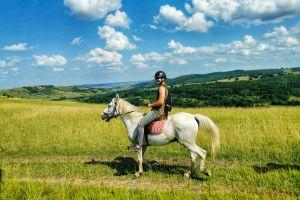
2-Day Horse Riding Trip in Transylvania
View this post on Instagram A post shared by Romanian Friend (@romanian_friend)
Ok, back to normal! :)
After so much sightseeing in Cluj and on day trips, you're probably starving! The best places for that in Cluj-Napoca are Museum Square (Piata Muzeului), Union Square (though a little too touristy for our taste), and Potaissa Street. This is where you'll find the best restaurants in the city, with lots of bars, cafes, and inspiring terraces.
Blend in with locals and make some new friends. If you're looking for places to go out in Cluj-Napoca, try the fancy menu at Via Restaurant, reinterpreted traditional food at Zama, or delicious pasta at Tortelli. You can also try Casa Boema for Romanian tapas or Baracca for gourmet delicacies. Bulgakov and Casa TIFF are local favorites too.
If you're looking to try Romanian food beyond the typical sarmale (stuffed cabbage rolls), polenta with shepherd's cheese, papanasi (huge desert) and mititei most travel bloggers talk about - one of our guides is also a foodie.
He'll take you to the best places in Cluj to try authentic Romanian food, including a farmers' market to taste local produce and tell you what local specialties to try. We love these walk, talk & eat local experiences when visiting other cities around the world so we created one for Cluj too:
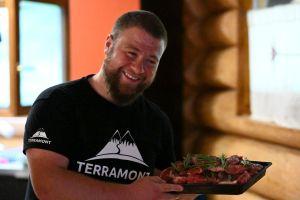
Cluj-Napoca Food Tour: Food Markets, Regional Dishes and Coffee Culture
Coffee lover? You're in for a treat! For almost a decade now, Cluj has been famous in the entire country for its specialty coffee culture. Popular places to try: Meron, Narcoffee, Olivo, Let’s Coffee, and Frasca - a small and cozy place that will make you feel at home and serve gentle low acid coffee .
- Pro tip: Romanians love good coffee and we wrote an article with the best coffee shops in Romania covering every major tourist city
Museum Square is a perfect place to end up for drinks after dinner. For good wines try Crush Wine Bar although most hip bars will serve the best Romanian wines. Try Londoner's Pub or Hemingway's for cocktails and other great things to surprise your taste buds.
Piezisa Street is full of bars, clubs, and street food eateries since there’s a large student campus nearby – so prepare for a long night of music, dancing, shots, and a great time! For proper clubbing, check out /Form Space and Euphoria Music Hall which usually have live concerts followed by DJ sets.
The best time to visit Cluj-Napoca is generally April - September when there are lots of events going on in the city. A city break of 4-5 days is enough especially if you leave 1-2 full days for day trips.
Cluj has Romania's second-largest airport which is very well connected to European cities, mostly with flights from Wizz Air. Check our guide on traveling to Romania for more info on that.
From Bucharest to Cluj-Napoca the best way is to catch an internal flight. By car it may take 7-8h and we don't recommend it (unless you break for one night in Brasov or Sibiu) because driving in Romania long distances is very tiring. There is an overnight train too which takes 10h.
Unfortunately, public transportation in Romania is not very well developed so take that into account when planning your trip.
From Cluj-Napoca International Airport to the city center or Old Town area there are 2 options:
- public bus line A1E that runs every 10 min daily or 20 min during weekends between 04:30 – 24:00; as you exit the arrivals building it will be on your right; it will take you to the city center in about 26 min and finish in Piata Mihai Viteazul; you can buy ticketss from the ticket machine in the airport;
- just outside the arrivals building you'll find the official taxis waiting, all safe and scam-free; you can even pay by card (just tell the driver before getting in); from Cluj airport to the city center it will cost about 10 Euro and take 15-25 min, depending on destination and traffic (for convenience and speed, this is what we recommend)
The best way to navigate Cluj-Napoca is by foot: the main landmarks and squares are all within walking distance. For anything else, take a taxi (Daniel, Nova, City) for 3,11 Lei/ km. You can also use the ride-hailing apps Uber or Bolt and pay cash or by card.
For more info on public transportation in Cluj-Napoca check the official website here. Bus and tram tickets cost 6 Lei for two rides but I doubt you'll need to use them. Renting public bikes is, unfortunately, not available for tourists (yet).
There are plenty of places to stay in Cluj around the Old Town area and main boulevards. Check on Booking.com or Airbnb to see options and you'll find everything from hostels to high-end hotels. Prices start as low as 20 Euro/ night.
Generally, I don't recommend you go further than Piata Operei or Parcul Central since you want to be within walking distance of the city center.
So - that's it! All my tips on how to visit Cluj-Napoca like a local with the best things to do in the city, must-see attractions, and day trips from here.
I hope it will inspire you to come over for a quick visit – we can even grab a drink in some of the spots I mentioned and I'll tell you more about the best things to do in Romania since I'm so passionate about my job!
Your Romanian Friend
Places to visit
- City Travel Guides (5)
- All Tourist Attractions (22)
- Tourist Regions (5)
Check our tours
- By category

4 times a year we prepare a newsletter with local stories, places and our special insights about Romanian culture and local life that will inspire you to visit our country and have an authentic local experience. Would you like to get it?
Follow Romanian Friend on:
#romanianfriend.
Must-see attractions in Cluj-Napoca
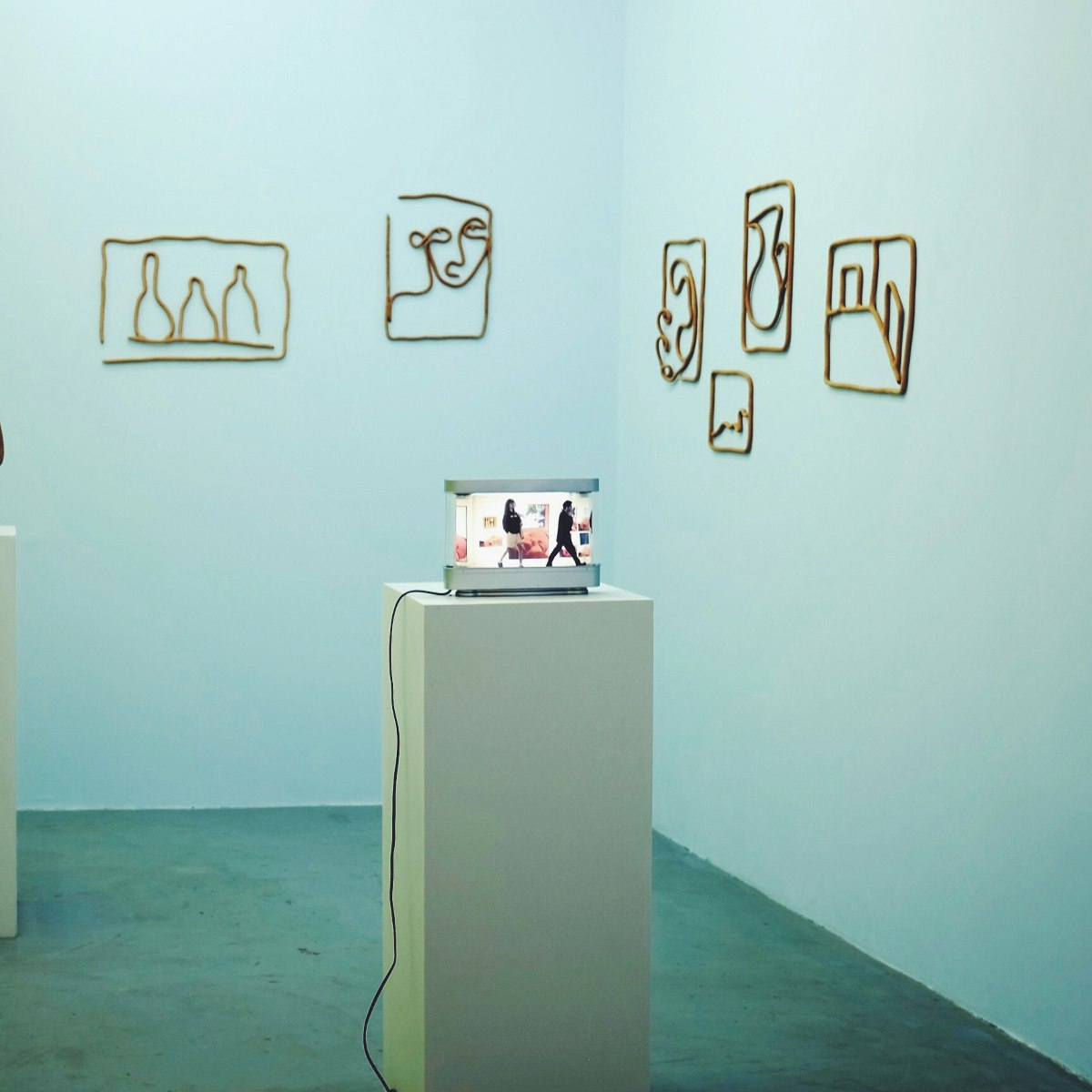
Fabrica de Pensule
Cluj-Napoca
More of a living, breathing creative space than a gallery, Fabrica de Pensule teems with just-made artwork by local and foreign creators who use this…
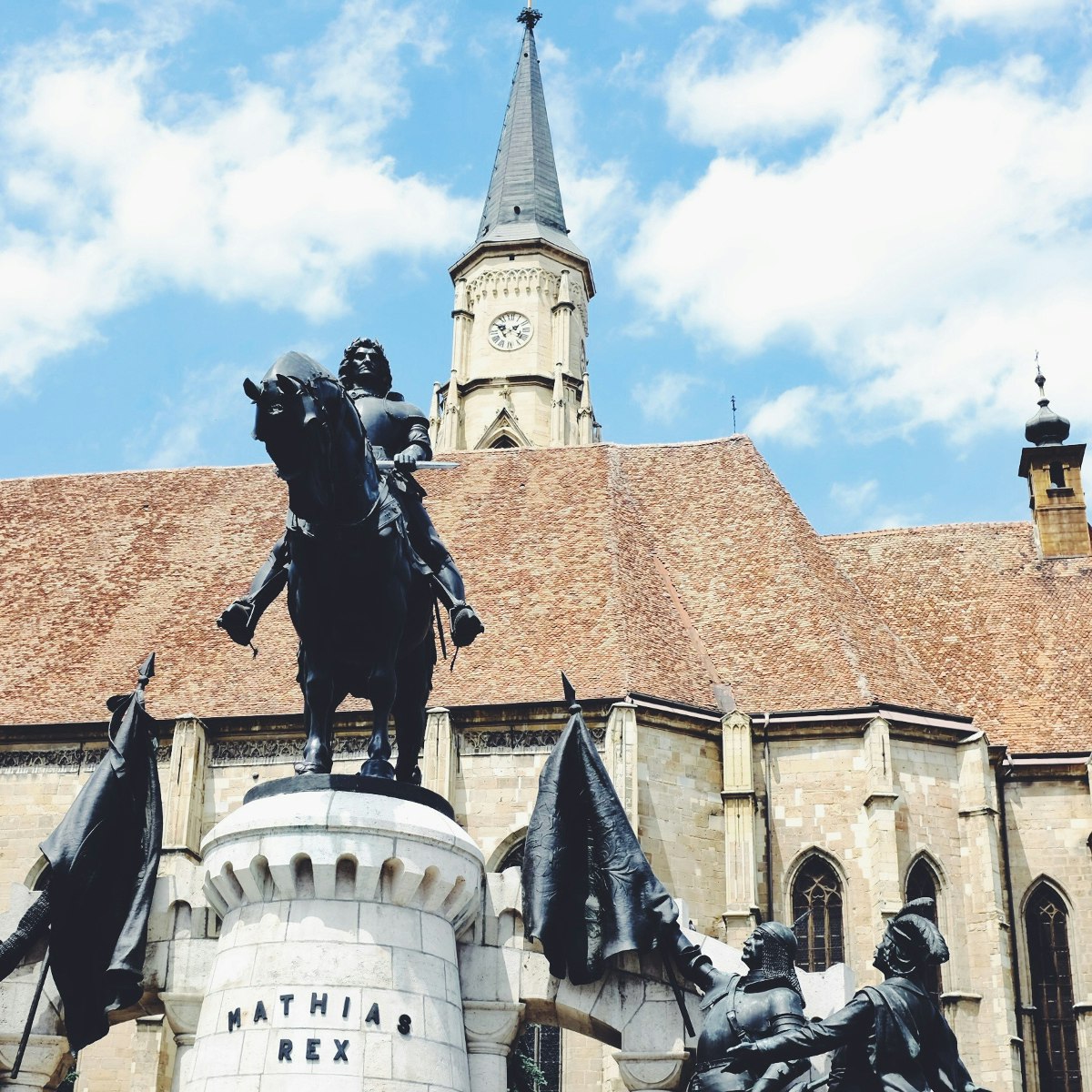
St Michael's Church
The showpiece of Piaţa Unirii is 14th- and 15th-century St Michael’s, the second-biggest Gothic church in Romania (after Braşov’s Black Church). Its neo…

Parcul Etnografic Romulus Vuia
Traditional architecture from around Romania has been faithfully reassembled at this open-air museum, 5km northwest of central Cluj. Most impressive is…
Pharmacy History Collection
Cluj-Napoca’s oldest pharmacy building holds an intriguing collection of medical miscellany. ‘Crab eyes’, skulls and powdered mummy are just a few of the…
Alexandru Borza Botanic Gardens
These wonderfully relaxing gardens comprise rockeries, neoclassical statues peeping from tangles of rose, and a Japanese-style garden with a crimson…
Statue of Matthias Corvinus
Hogging the limelight in front of St Michael’s Church is a bulky 1902 statue of horseback Matthias Corvinus, the famous 15th-century Hungarian king.
Hungarian Cemetery
Founded in the 16th century, this stately cemetery is a memorable place to stroll among elegant tombs and mausoleums of Transylvanian poets and composers,…
National Art Museum
The permanent collection of this sizeable gallery has creaky rooms featuring 18th- and 19th-century art, mostly portraits of nobles and their bewigged…
National History Museum of Transylvania
Within this museum of regional history you’ll discover Dacian artefacts, mostly from Sarmizegetusa’s archaeological sites, including glass blow pipes,…
Hungarian Reformed Church
Commissioned by the king of Hungary, Matthias Corvinus, in 1486, this church took more than 20 years to complete. Its interior seems spare at first glance…
Franciscan Church
On the eastern side of Piaţa Muzeului, the rosy, gilt-edged decor within this sanctuary is worth a peep; look up for trompe l’oeil frescoes.
Tailor's Tower
Rotating exhibitions of local art within this stone tower can be somewhat threadbare. But it’s still worth wandering inside this pointy-roofed former…
Ethnographic Museum of Transylvania
On the upper floor of a renovated neo-Gothic building, dating to the 16th century, find well-tended exhibitions on Romanian peasant life throughout the…
Matthias Corvinus House
A block south of the National History Museum is the birthplace of Matthias Corvinus, a 15th-century Hungarian king. This Gothic building is now the…
Metropolitan Museum
Housed beneath a gleaming white cathedral, this museum exhibits religious icons and other artwork.
Synagogue of Deportees
The late-19th-century synagogue on this spot was rebuilt and restored after WWII. Topped with silver onion domes, the Moorish-style building (closed to…
Statue of Baba Novac
A statue of Serbian revolutionary Baba Novac, who plotted against the Ottomans, stands outside the 15th-century Tailor's Tower.
Museum of Zoology
An encyclopedic collection of bottled, jarred and taxidermied specimens from butterflies to waterfowl.

- Living In Croatia
- Croatian Recipes
- Balkan Recipes

Home > Discover The 14 Best Things To Do in Cluj-Napoca City In Romania
Discover The 14 Best Things To Do in Cluj-Napoca City In Romania

Written by our local expert Guru
Written by a local specialist we know and trust to bring you the most up-to-date travel information.
Here, we have a list of the best things to do and what to see on your trip to Cluj-Napoca. We’ve got suggestions for what to see when you are wandering around the city center as well as those who want to venture out to the forest.
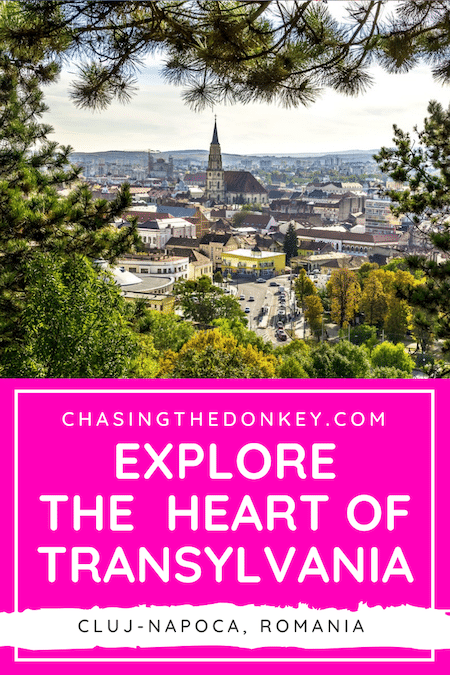
Skip Ahead To My Advice Here!
Visiting Cluj-Napoca
Cluj-Napoca is the unofficial capital of Transylvania, a region known for its spooky Dracula legends , beautiful landscapes, and rich heritage . As the second-biggest city in Romania, visiting Cluj-Napoca is an essential part of any Romania itinerary .
Once the heart of the Transylvania region, Cluj-Napoca has now transformed itself into a charming city with vibrant nightlife (partly thanks to the several universities in town). However, dotting the idyllic streets are still many historic buildings that tell the tales of its long history.
That is why we have written this post to showcase some of the best things to do in Cluj-Napoca so that you can discover the best of Cluj on your visit !
Best Things To Do In Cluj-Napoca: Top Attraction Ideas
We’ve made a list of the top attractions in Cluj-Napoca, Romania, for you!
1. Explore Hoia-Baciu, One Of The Most Haunted Forests In The World

Hoia-Baciu is one of the biggest attractions in Cluj-Napoca, but it has nothing to do with Cluj’s history. Hoia-Baciu earned its fame by being one of the most haunted forests in the world. Paranormal activities are rumored to occur there regularly, and many documentaries feature Hoia-Baciu.
Some call it the “Bermuda Triangle of Transylvania” or “Romania’s Most Haunted Forest.” Others refer to it as a mysterious natural wonder.
Many features of the Hoia-Baciu forest make it so strange. First of all, none of the trees grow straight inside, but rather in a peculiar twisted shape. To this day, scientists don’t know why they grow in this shape and pattern.
Secondly, the Hoai-Baciu is a dense forest, except for one oval-shaped area known as “The Circle” or “The Clearing,” where no vegetation grows. Scientists have researched the soil here and found no discrepancy between the soil quality from The Circle from the rest of the forest.
There are rumors of people disappearing from Hoia-Baciu, unexplained lights, UFO sightings and mysterious shadows. However, this doesn’t stop tourists from visiting this forest, and interested visitors can find daytime and nighttime tours to Hoia-Baciu from Cluj.
If you’re planning to visit Hoia Baciu, prepare for an adventure that’s both thrilling and eerie. The forest is easy to access from Cluj, making it a popular destination for both locals and tourists. As you step into the woods, you’ll be greeted by dense vegetation and a sense of being in a place where the ordinary rules might not apply.
While the forest’s reputation for the supernatural might pique your curiosity, taking precautions is essential. Always visit during daylight hours, and let someone know about your plans. Stick to marked trails and avoid wandering off the beaten path.
- Best Things To Do In Romania (Including Hoia-Baciu Forest!)
2. Admire Transylvanian Architecture At Saint Michael Church
Also known as Biserica Sf. Mihail, this church is a stunning example of Transylvanian architecture while being rather beautiful at the same time. You’ll see pictures of St. Michael’s church in literature promoting Cluj-Napoca for tourism.
Be sure to check out the beautiful interior and the church tower, which soars for 80 meters.
3. Take A Peaceful Stroll Through Cluj’s Central Park
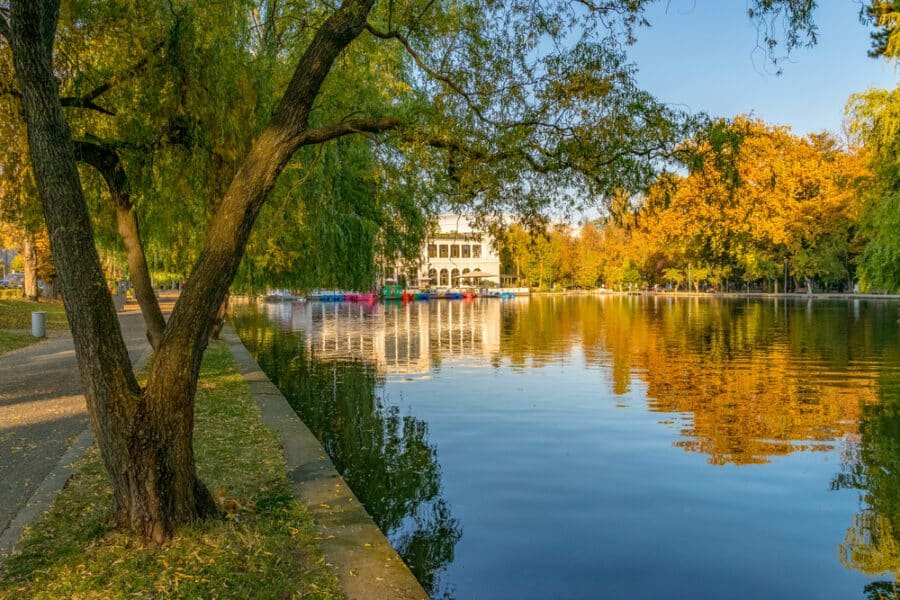
Situated in the historical center of Cluj is Cluj’s biggest public park, the Cluj Central Park. Founded in 1827, Cluj Central Park has served as a prime recreational space for all the residents of Cluj since then. The lush park is perfect for a relaxing evening stroll, allowing guests to reconnect with nature without having to go far briefly, one of those simple yet super-enjoyable Cluj-Napoca activities.
The Central Park of Cluj is often filled with beautiful plants and flowers, but those are far from its greatest attraction. Situated inside the Central Park is a small pond where visitors can ride a hydro bike and paddle across. On the pond’s perimeter, guests will find cafes and restaurants where they can enjoy some delicious refreshments and admire the peaceful views.
The historic Casino is also situated in Central Park of Cluj. Once the perfect place for gamblers, it is now a place for art exhibitions and ceremonial purposes. If you are looking for a relaxing afternoon in the city, Central Park is one of Cluj’s best places to visit .
4. Immerse Yourself In Art At The Cluj-Napoca Art Museum
Art and architecture fans should definitely head to this museum as it’s a wonderful blend of both. The building dates back to the 18 th century and is designed in baroque style. It’s also very easy to reach, as it’s right in the center of the city.
Inside, you’ll find paintings and decorative art by famous artists, including Grigorescu, Luchian, and Paciurea, to name a few.
5. Discover Unirii Square (Union Square), The Biggest Square In Cluj
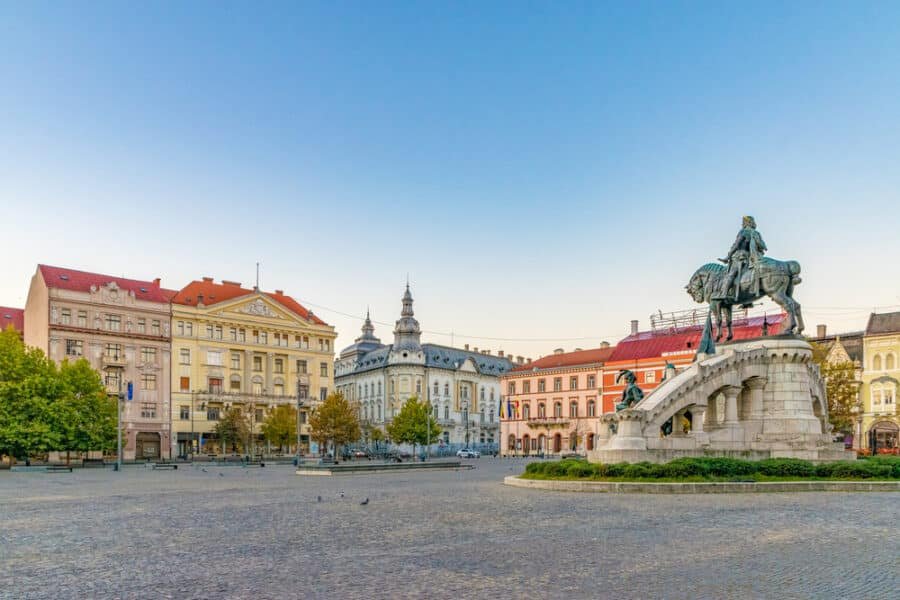
The most crucial feature of Cluj’s historic center is Unirii Square, the largest square in Cluj-Napoca. Union Square contains some of the most historical Cluj-Napoca attractions, such as the Roman Catholic St. Michael’s Church and the statue of Matthias Corvinus, King of Hungary, from 1458 to 1490.
If you don’t have a tour guide with you, you might not grasp Unirii Square’s historical significance. That is why it is important to have a tour guide for this part of Cluj, and there are many walking tours around the city at your service. If you are exploring Cluj without a tour guide, you can still enjoy some of Unirii Square’s biggest attractions, such as checking out St. Michael’s Church.
At 50 meters wide (at the nave) and 80 meters high, St. Michael’s Church is the second biggest church in Transylvania (just after the Black Church in Brasov ). The tower sits 80 meters high (including the 4-meter high cross) and is the highest in Transylvania. On the exterior, the masterful Gothic architecture looms over the Unirii Square, casting its beauty on anyone that passes by.
Exploring the inside of St. Michael’s Church is a must (and free). Visitors will find gorgeous stained glass and numerous artworks in the interior of this architectural masterpiece. When visiting, don’t miss the chance to go up to the church tower, where you will find a stunning bird’s-eye view of the city.
So, if you’re wondering what to see in Cluj-Napoca, we suggest starting at this landmark-dotted square.
6. Understand The Past At The National Museum Of Transylvanian History
Everyone is fascinated with the Transylvanian area, and this museum tells you about it in one easy-to-visit place. There are more than 400,000 artifacts to explore, dating back thousands of years. There are also temporary exhibits from time to time.
The National Museum of Transylvanian History is highly regarded as a European institution, so it’s a spot you should place on your visit list.
7. Learn Romanian Heritage At the Ethnographic Museum Of Transylvania
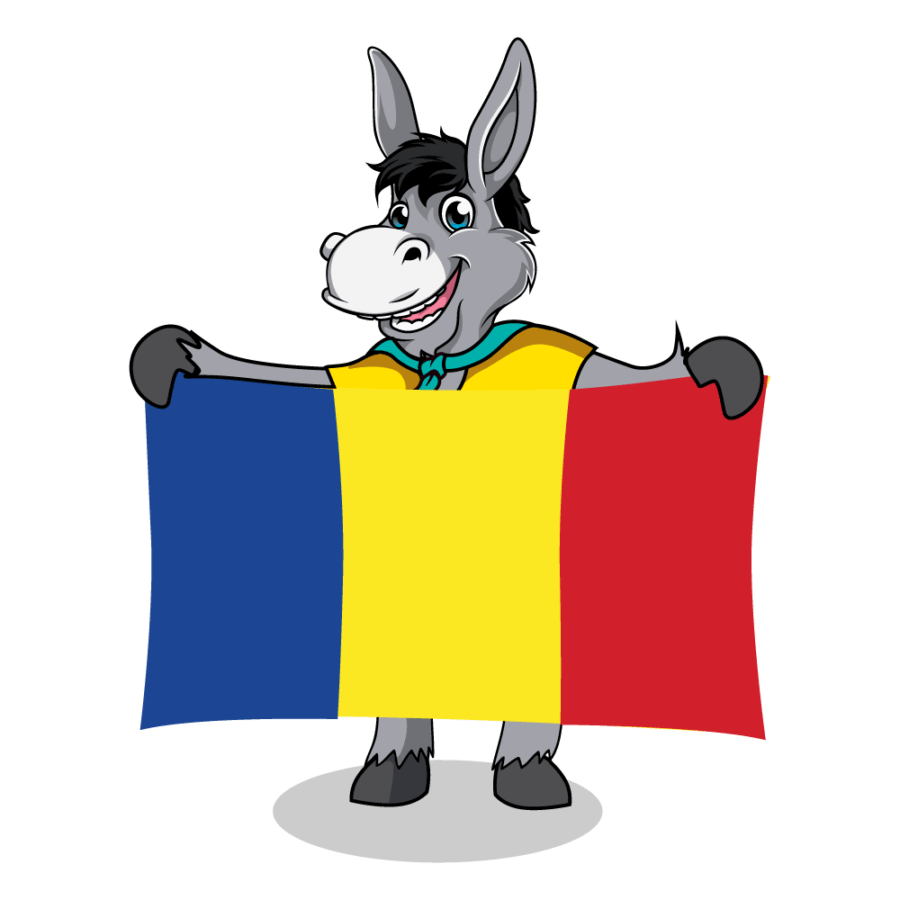
As the capital of the Transylvania region , Cluj-Napoca is the ideal place to learn about its heritage. There is no better place in the city to do so than the Ethnographic Museum of Transylvania.
The Ethnographic Museum of Transylvania consists of two exhibitions: the indoor museum in the historical center of Cluj and the outdoor open-air museum located 10 minutes away. Both are among the greatest Cluj tourist attractions and come highly recommended.
The indoor exhibition is located in Palais de la Redoute. Visitors will find a huge collection of items used throughout Romanian rural life’s history. The collection includes clothes, tools, photos, and a wide selection of scholarly journals and magazines.
The second part of the museum is located about a 10-minute drive (or 40-minute walk) from the Piața Unirii. Known as the Ethnographic Park Romulus Vuia, it is the first open-air museum in Romania . Most objects date back hundreds of years, with the oldest dating to 1678.
In the wide-open space, visitors will find many traditional Transylvania elements, such as old farms, mills, workshops, churches, and various buildings from different parts of Transylvania. Though visitors are not allowed to enter the buildings, just seeing them from the outside and getting close to them is like you have stepped into a time machine! It’s one of those uniquely cool places in Romania .
- Romania’s Historical UNESCO Sites
8. Head Inside Tailors’ Tower
Tailors’ Tower is part of the old fortress, and back in the 15 th century, it was funded by the tailors’ guild to defend the city against invaders. Inside, you’ll find a museum to learn more about the area and the tower itself, but it’s a pretty impressive spot and one of the oldest towers.
9. Check Out The Amazing Hilltop Views From Cetatuia Park
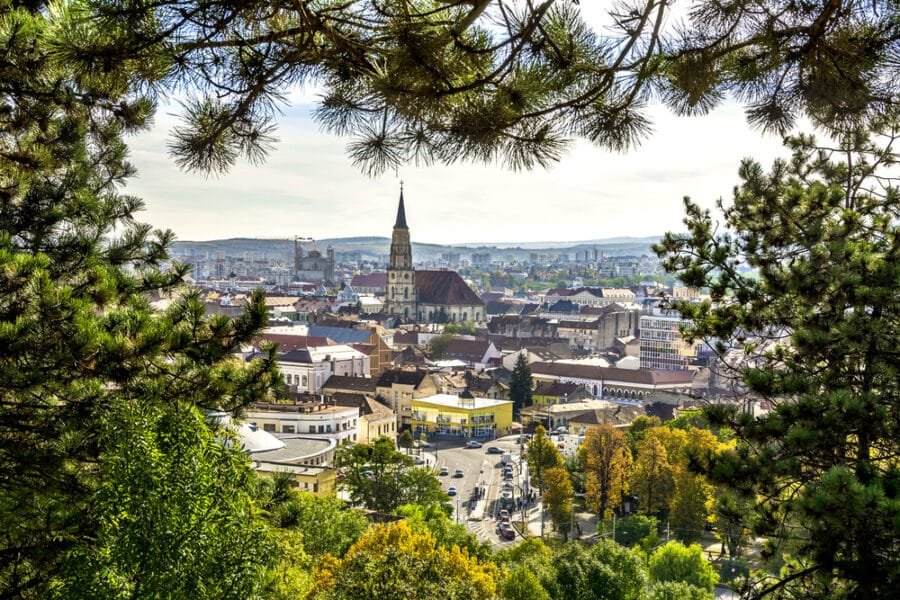
Located across the Someșul Mic River, away from the Old Town of Cluj, is another one of the city’s pristine parks: the Cetatuia Park. A popular destination on Cluj sightseeing excursions, the Cetatuia Park is perched over the hill and offers visitors panoramic views of the city and the surrounding landscape from above.
Lights from every crevice of Cluj illuminate to offer visitors a unique view of Cluj. Its wide-open spaces are particularly ideal for photographers, as they can photograph Cluj from many different angles. Though the views in the daytime are gorgeous, the night views are more sought after. It is no wonder why you will still find plenty of people in Cetatuia Park at night.
In the daytime, locals love to hang out in the Cetatuia Park for some fresh air, walk along the short hiking trails , and enjoy some of the excellent restaurants inside the park.
10. Gather With The Locals At The Statue Of Matthias Corvinus
Matthias Corvinus was a Hungarian king between 1458 and 1490. He was also a Cluj native, having been born there in 1443. The statue was built to commemorate his reign, and you can also head to Hunedoara Castle if you want to learn more, as he was the second son of one of the kings there. Incidentally, the castle is one of the largest in the region.
The land around the statue itself is well worth a visit as it’s a calm and relaxing spot where many locals gather.
11. Take A Day Trip To Salina Turda Salt Mine

Salina Turda is genuinely one of the hidden gems of Cluj Napoca. It is one of the best hidden gems in the entire world. Business Insider has personally ranked Salina Turda as one of the “25 hidden gems across the world that are worth the trek.”
Salina Turda is one of the oldest salt mines in the world. First mentioned in 1075, the Turda Salt Mine remained operational until 1932. Nowadays, you won’t get any salt production here; however you will find that this ancient salt mine has two main reasons to visit.
First, its underground galleries and large, high-ceiling caverns host an unusual amusement park.
Inside the Rudolf Hall of the Salina Turda, you will find bowling alleys, ping pong tables, billiards, theaters, mini-golf courts, and more entertainment to keep everyone in the family entertained. However, that isn’t all. Its most iconic feature is the 20-meter-tall Ferris wheel that makes you question, “How did they get that thing in here?”
Descend from Rudolf Hall into the Theresa Mine, and you will find the 6-meter deep underground lake. Visitors can rent a boat and row it around for 20 lei, taking in the gorgeous views and health-enhancing salty air.
Visitors will also enjoy the artificial lighting installations. Everything was designed to highlight the salt mine’s natural beauty and artificial galleries and give visitors a magical experience.
Second – well known among Romanians but less so by foreign tourists – is that inhaling salty air is good for your lungs and treats respiratory diseases. This is something even the Romans knew! Romanian doctors regularly prescribe salty air therapies and Turda Salt Mine, along with other salt mines such as Praid or Ocnele Mari, is a preferred destination for this.
What do you have to do to get these health benefits? Nothing! Just spend 2-4 hours in the mine. Take a tour to learn about its salt exploitation history and the interesting tools used, play some games or bring a book with you. Beware, though, as no food or drinks (other than still water) are allowed inside the mine as they will interfere with the air!
Salina Turda, is located about 45 minutes from Cluj-Napoca by car, making it an excellent day trip . If you haven’t rented your own vehicle, taking a taxi or an organized tour is recommended to get there. This is a fantastic excursion if you’re spending a weekend in Cluj.
- Peaceful Places To Visit In Romania
12. Visit The Assumption Cathedral, AKA Dormition Of The Theotokos Cathedral
The Assumption Cathedral (also known as Dormition of The Theotokos Cathedral) is a beautiful Romanian Orthodox Cathedral located in the heart of Cluj-Napoca. Constructed between 1923 and 1933, the cathedral is built in a Romanian Brâncovenesc style, combining Renaissance and Byzantine architecture.
Visitors can admire the 64-meter-high structure at the Avram Iancu Square. They will also find the National Theater and a statue of Avram Iancu, a prominent figure in the Austrian Empire Revolutions.
When you are done admiring its eight towers and four bells from afar, make sure you visit inside. Though the exterior is the most stunning part of this structure, the interior is far from lackluster. It is also completely free to enter, so there is really no reason to miss out!
13. Parcul Central – Parcul Cetátuia
Parcul Central in Cluj-Napoca, Romania, is the quintessential urban oasis that beckons both locals and visitors alike. Nestled in the heart of the city, this sprawling park offers a breath of fresh air and a slice of nature’s tranquility.
As you step into Parcul Central, you’re greeted by a vibrant sea of greenery—lush lawns, towering trees, and colorful flowerbeds that set the stage for a perfect picnic or a leisurely stroll. But the park has more to offer than just its verdant beauty.
A picturesque lake takes center stage, inviting you to hop on paddleboats and bask in the sun during warmer months. Nearby fountains lend a soothing soundtrack to your visit, creating an atmosphere of serenity.
Among the park’s many treasures are statues and monuments, including the Monument of the Heroes, a poignant reminder of Cluj-Napoca’s rich history and the sacrifices made during World War I.
For families, Parcul Central is a playground haven, complete with play structures that keep kids entertained for hours. And if you’re inclined to stay active, well-maintained walking and cycling paths provide the perfect backdrop for exercise and outdoor adventures.
When you need a break, the park’s cafes beckon with refreshments and snacks. Plus, Parcul Central is a hub for cultural events and festivals, adding a touch of local flavor to your visit.
But perhaps the park’s most valuable asset is its ability to offer relaxation amid the urban hustle and bustle. It’s a place to unwind, dive into a good book, or savor the serenity.
In Parcul Central, Cluj-Napoca offers not just a recreational space but a cultural haven, a natural retreat, and a breath of fresh air in the heart of the city. It’s the perfect locale to spend a leisurely day in the great outdoors, surrounded by the beauty of this vibrant Romanian city.
14. Cluj-Napoca Botanical Garden, AKA Alexandru Borza Cluj-Napoca Botanical Garden
If you have extra time on your visit to Cluj, don’t hesitate to pay a visit to the Cluj-Napoca Botanical Garden. Spanning over 14 hectares in area, this Botanical Garden is home to over 10,000 different species of plants worldwide. Visitors can learn about the Romanian flora and vegetation from Transylvania and the Carpathian Mountains , one of the nicest things to do in Cluj if you have an extra day.
Besides a wide variety of plants, the Botanical Garden is set up with themes in mind. For example, the most popular theme is the Japanese Garden, where visitors will find plants native to Japan and a traditional Japanese house. Another popular theme is the Roman Garden, where there stands a statue of Ceres and prominent plants in Romanian agriculture.
If you are traveling with kids in Cluj, consider visiting its Botanical Garden! The entrance fee is 5 lei per person (at the time of writing).
Brands We Use And Trust
What food to eat in cluj.
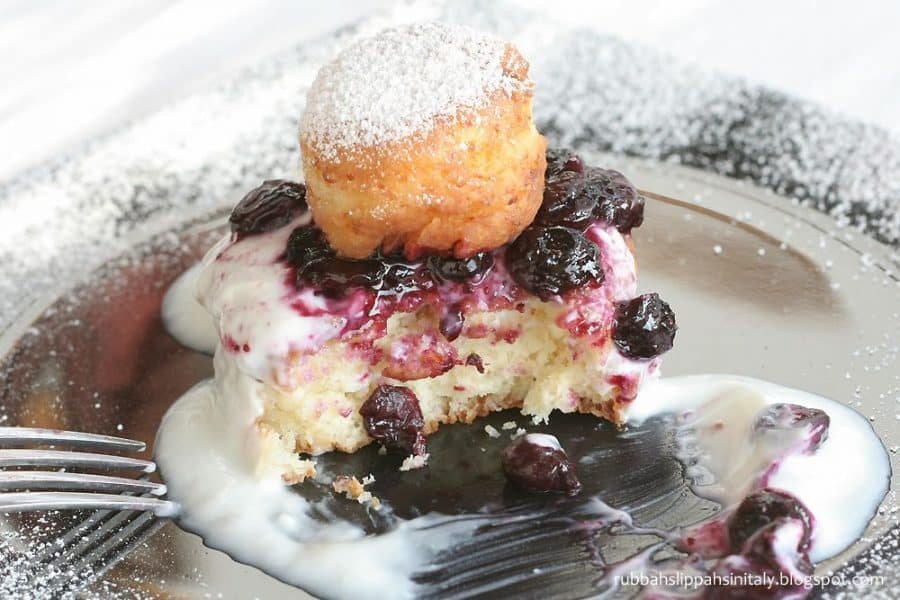
When in Cluj-Napoca, Romania, you’ll have the opportunity to savor a variety of traditional food options in Romania . Here are some of the places to eat all the must-try foods in Cluj:
- Mămăligă cu Brânză și Smântână. A traditional Romanian dish, mămăligă is a cornmeal porridge similar to polenta, often served with brânză (cheese) and smântână (sour cream). It’s a comforting and hearty option
- Sarmale. These are pickled cabbage rolls stuffed with a flavorful mixture of minced meat (usually pork or beef), rice, and spices. They are often served with smântână
- Mici. Known as “Mititei,” these are small grilled sausages made from a blend of minced meat (typically a mix of beef and pork) seasoned with garlic, paprika, and other spices. They are a popular street food.
- Varză a la Cluj. This is a local specialty in Cluj, consisting of cabbage rolls filled with a mixture of minced meat, rice, and spices, simmered in a tomato-based sauce
- Ciorbă de Perișoare. A sour meatball soup, typically made with beef or pork and flavored with sour cream and herbs
- Papanași. A delicious Romanian dessert, papanași are fried or boiled dumplings made from cottage cheese, covered with sour cream and fruit preserves. They are a sweet treat worth trying.
- Țuică: This is a traditional Romanian plum brandy, a strong alcoholic beverage often served as an aperitif or alongside meals
- Local Pastries. Explore local bakeries for a variety of pastries and desserts, such as cozonac (sweet bread), plăcinte (pastries filled with cheese, apples, or other ingredients), and clătite ( pancakes ) served with various fillings
To experience the full range of flavors in Cluj, consider dining at local restaurants, exploring street food vendors, and trying dishes that showcase Romania’s rich culinary traditions.
How To Get To Cluj-Napoca
Getting to Cluj-Napoca, a major city in Romania’s Transylvania region, can be done via several modes of transportation, depending on your starting location and preferences:
Avram Iancu Cluj International Airport (CLJ) is the main gateway for international and domestic flights. The Cluj-Napoca airport is well-connected with major cities across Europe through regular flights operated by various airlines, including low-cost carriers. From the airport, you can take a taxi or bus, or rent a car to reach the city center, approximately 10 km away.
To reach Cluj-Napoca by train, you can start in Bucharest (the capital), as well as other major cities in Romania and some neighboring countries. The train station is centrally located, and trains offer a scenic, albeit slower, mode of reaching the city.
Numerous bus companies operate services to Cluj-Napoca from Romanian cities and various European destinations. Buses usually terminate at the central bus stations, which are conveniently located within the city.
If you’re coming from within Romania or neighboring countries, driving to Cluj-Napoca is a viable option. The city is accessible via major highways and roads. The A3 motorway connects Cluj-Napoca with Bucharest and other parts of the country, offering a fast and convenient route for drivers.
Move This Adventure To Your Inbox & Get An Instant Freebie

No spam. Unsubscribe at any time.
Where To Stay In Cluj
Accommodation in Cluj Napoca is varied and inexpensive; here are just a few suggestions to get you started.
Luxury Nook
Location: City center.
Why book: Tastefully decorated apartment, centrally located, air-conditioning, high-speed wifi, and is one the best places for affordable luxury. Check out the hotel & prices here ↳
Hotel Platinia
Location: Near Ursus Brewery, Central Park, and Cluj Arena.
Why book: Five-star luxury, well-equipped rooms with free wifi, hardwood floors, comfortable fabrics, walk-in showers, dressing room, sofa, television, and prime location near attractions. Check out the hotel & prices here ↳
Villa-Hotel Escala
Location: In a residential area.
Why book: Warm and welcoming owners, large air-conditioned rooms, quiet garden with a pool, and useful information from the owners, it’s a lovely place. Check out the hotel & prices here ↳
Sungarden Golf & Spa Resort
Location: Countryside.
Why book: Outdoor pool, sauna, relaxation room, Turkish bath, 9-hole golf course, outdoor bars, spacious rooms with luxury amenities, and private terrace. Check out the hotel & prices here ↳
Apartment Vintige
Location: In the heart of Cluj.
Why book: Close proximity to St. Michael’s Church and cafes, beautifully decorated apartment, and complimentary bike for easy exploration. Check out the hotel & prices here ↳
Garden City Apartment
Location: A little further out of town.
Why book: Ridiculously cheap residential apartment with a quiet garden and fully-equipped kitchen. Check out the hotel & prices here ↳
FAQs About Visting Cluj Napoca
What landmarks can i visit in cluj, romania.
Notable attractions include Parcul Cetátuia for its beautiful city views, the Romanian National Opera House for a rich cultural experience, and St. Michael’s Church for its historic significance.
What outdoor activities are there in Cluj?
Outdoor activities in Cluj are plentiful, including visiting the Botanical Garden, attending a CFR Cluj football game, and participating in several walking tours.
What food is unique to Cluj?
A local delicacy that you must try is “papanași”, which are Romanian doughnuts.
Can I take a day trip from Cluj?
Yes, there are numerous day trip options, which include visiting the Turda Salt Mine and exploring the Apuseni Mountains.
Can I experience art and cultural events in Cluj?
Indeed. Cluj hosts numerous music and art festivals and is home to the Bánffy Palace Museum of Art.
Where can I shop for souvenirs in Cluj?
The local market in Cluj is a great place for souvenir shopping, where you can find traditional items like Romanian embroidered shirts.
We hope this Cluj-Napoca guide filled with things to do around Cluj has given you the proper information to plan your visit to this hidden gem in Romania!
- Romanian Food
- What To See When You Visit Romania
- Things To Do In Romania
- Bucharest Tours
- Things To Do In Brasov, Transylvania
- Where To Stay In Brasov
- Things To Do In Maramures
- Weekend Itinerary In Oradea
- UNESCO Villages With Fortified Churches
- Where To Stay In Bucharest
- Winter Travel In Romania
Initially written by Sean Lau of LivingOutLau and updated by the Chasing the Donkey team.
Leave a Reply Cancel reply
Your email address will not be published. Required fields are marked *
Save my name, email, and website in this browser for the next time I comment.
This site uses Akismet to reduce spam. Learn how your comment data is processed .
Subscribe To Unlock Your FREE Customizable Travel Packing List & All Our Best Tips!
Unlock Your FREE Customizable Travel Packing List!
Subscribe Now For Instant Access To Stress-Free Packing
- International edition
- Australia edition
- Europe edition
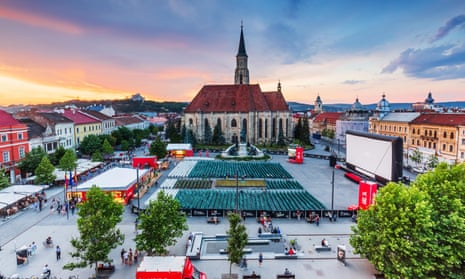
10 of the best things to do in Cluj-Napoca, Romania: a local's guide
The ‘capital’ of Transylvania has a large student population and an arty vibe with excellent clubs and some of Europe’s best-loved electronic music festivals
Lively old town
The historic centre around Unirii Square, the largest square in Cluj, is beautiful. Look out for the Hotel Melody Central . It opened in 1890 as a hotel but has also been a jazz club and a chapel. St Michael’s church is a huge gothic building and sights around the square include Old Banffy Palace , which now houses the National Art Museum , and the old town hall. The three main squares in the city centre – Mihai Viteazul and Avram Iancu, as well as Unirii – are full of historic buildings and cosy bars.
Cutting -edge festivals

Festivals attract a lot of visitors to Cluj and have really changed the city and accelerated its growth. It’s best known for electronic music events, particularly Electric Castle (15-17 July 2020), which won the best medium-sized festival at the 2019 European Festival Awards . Untold is another major electronica festival (30 July-2 August) and this year sees the launch of Form Days , a music and arts extravaganza in Gilău, outside the city (2-5 July). Cluj has a big history with jazz too, and Jazz in the Park (25-28 June) was named best small festival 2019.
Art, film and hair

Cluj is a very creative place with a mix of established institutions like the National Art Museum and more underground galleries like Fabrica de Pensule (previously in a large warehouse-like building, it’s currently closed but will reopen this year with events in different locations). One of the best modern art galleries is Galeria Quadro , while the Creic Center is a new creative hub for local artists. There’s a big interest in film in Cluj too: the Transilvania International Film Festival (29 May-7 June) is the most important in Romania – it was started by a group of friends about 17 years ago and now runs for almost two weeks, attracting people from all over the world. CASA TIFF has events and exhibitions all year and has a cafe and restaurant too with vegan fare. An unusual place to check out is Hairgonomy Hair Salon , which regularly hosts DJs and live artists performing in the salon. It also holds art exhibitions. Visitors who want to see art should contact a friend of ours, Helga Thies, who recently started ArtCrawl Cluj , taking people to discover the city’s diverse contemporary art.
Creative bar scene

Cluj is a lively student city with a great craft beer and cocktail scene. Joben Bistro is a steampunk bar with a focus on cocktails and Enigma also has a steampunk theme: the decor is amazing, with its kinetic sculptures, and it even has beer cocktails – try bloody beers with chilli sauce! Insomnia attracts artists and actors – it started as a photo gallery and became a bar – and Booha Bar is a must, especially at the weekend.
Cafes to linger in

Brunch has become really popular here and one great new place is District of Toast – though it does breakfast, lunch, dinner and good cocktails too! There are lots of inventive toast-based dishes, but make sure you try the clujentine eggs, served on a traditional cheese-filled pie with mushrooms and cream, and basil pesto. There’s a cool outside space and inside the vibe is industrial chic. It makes its own ginger beer and uses homemade ingredients for its cocktails. It’s the first place in Cluj to adopt a serious waste-free policy – which is why it serves cocktails in cute little bottles.
Cluj also has a big coffee culture – a remnant from Austro-Hungarian times. Meron is a roastery and coffee concept with seven locations in town. Eggcetera was the first dedicated brunch place to open in 2018, serving all-day breakfast at communal tables – it was all very new and there was a lot of hype. Ham and Jam , which opened last summer, serves more US-style and sweet breakfasts. Sisters is another great cafe, where you can experience the hipsterish side of town – it feels like being in Berlin.
Peaceful green space
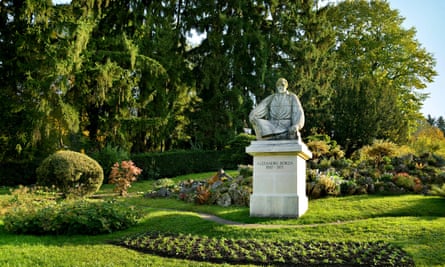
Cluj is a busy city but there’s lots of nature around. We’re on the river Somesul Mic and there are plenty of green spaces like Central Park, which is right on the riverbank. The Botanical Garden , opened to the public in 1925, is very beautiful and a lovely place to relax. It contains a rose garden with 250 different varieties, and examples of gardens from different parts of the world, like the Roman Garden and the Japanese Garden, as well as the Botanical Museum. Another interesting place is the Ethnographic Park and Museum – an open-air museum where you’ll see rural Romanian scenes. Last year it started running events with local chef Horia Simion hosting slow food lunches using local ingredients and showcasing Transylvanian gastronomy.
Taste of Transylvania
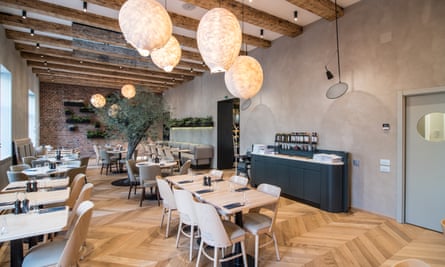
Among our favourite places to eat is Samsara Foodhouse , a brilliant vegetarian, vegan and raw food restaurant. It’s a bright location, with an olive tree growing in the centre. Mushroom and spinach lasagne and wild mushroom stew with truffles are popular dishes. There’s also Samsara Teahouse , great for organic teas, and each room has different decor – like the Asian room, and the psychedelic room. For really traditional Romanian fare, though, go to Roata – it has Transylvanian cold plate starters, traditional soups and dishes like cheese and polenta from the countryside, and local homemade wine (as well as traditional pálinka plum brandy). It has just opened a more modern bistro too.
Vintage ventures
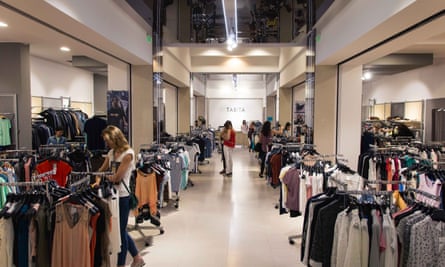
There’s a brilliant secondhand/vintage scene in Cluj, as well as some interesting independent designers. Helofita is a great outlet store – there are several of them around town – where you’ll find all sorts of secondhand clothes in good condition. Tabita is another chain of outlet stores where you often find cool stuff. For amazing handmade leather goods go to The Mill Handmade for Life , and check out Adina Grapa , a local designer who has her own shop that’s great for leather bags. Dopium Urban is another great label which rebuilds and upcycles all kinds of clothes; what were once ski-pants become a unique, incredible jacket. It’s owned by young, talented Cristina Teleptean who gives used clothes a second chance. Cluj is home to the University of Arts and Design and every summer the fashion students organise a great fashion show, the UAD Gala.
Funky new hostels

The hostel concept is quite a new idea in Cluj but it’s growing here now. There’s Iron hostel (bed from £11, doubles from £24) close to the station and Zen hostel (bed from £11, doubles from £23), which have lots of eco-friendly credentials and a mix of dorms and private rooms, as well as a bar and kitchen. Local people use Zen as a community centre so there are often events and DJs playing. There’s a bar and kitchen, terrace area and – yes – a hammock room for relaxing. Iron hostel is in the lively student district and just five minutes’ walk from the old town. Cluj has lots of excellent Airbnb apartments too.
Clubbing heaven
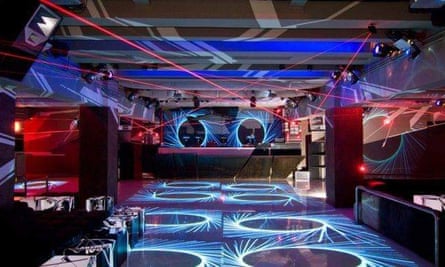
Club Midi , opened in 2007, was a huge thing (it’s been recognised as being in the top 100 clubs in the world by DJ Mag several times). It recently reopened with the emphasis on electronic music, from techno to house. FORM Space is another great venue – it has club nights, and live events. There is also a FORM cafe, a restaurant and bar which sometimes has parties.
When to go Spring and autumn are great times to visit, with the city in bloom or boasting vivid fall colours. Temperatures are less stifling than in midsummer, but warm enough for alfresco drinks. Summer sees an influx of visitors for the festivals, but there are great events all year round.
Costs Half a litre of beer is typically £1, a cappuccino is £1.20, and a three-course meal for two around £18. £1 = 5.6 RON (Romanian Leu)
Claudiu Șulea is founder and Flavia Mocan the PR manager of La Résistance creative agency and social enterprise
This article was amended on 29 January 2020 as one of the places originally mentioned had closed since the interview
- Romania holidays
- A local's guide
- Cultural trips
- Europe holidays
- City breaks
Comments (…)
Most viewed.

17 Top Things to do in Cluj-Napoca: Museums, History and Travel Guide
December 10, 2023 | Posted in: Romania
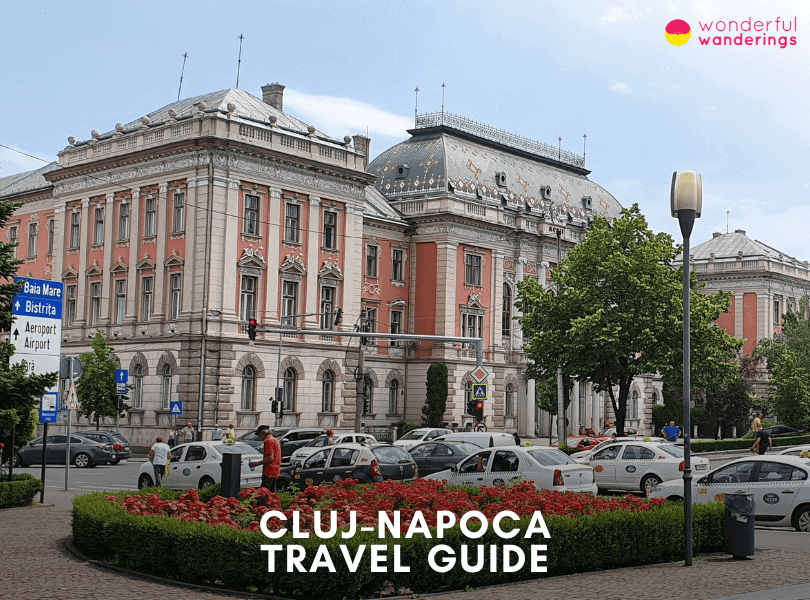
Cluj-Napoca is a city located in northwest Romania in the historical region of Transylvania. It has a long history dating back to Roman times when it was founded as the city of Napoca. Cluj-Napoca has been part of the Kingdom of Hungary, the Austrian Empire and modern Romania. It is the second most populous city in Romania after Bucharest, with a population of 324,576 as of 2023.
Cluj-Napoca is an important economic, academic and cultural hub. The city has a thriving university scene with over ten institutions of higher education. Major IT and technology companies have offices in Cluj-Napoca, earning it the nickname “Silicon Valley of Transylvania”.
Cluj-Napoca attractions feature the Gothic St. Michael's Church, the medieval Tailors' Tower, the Ethnographic Museum of Transylvania and the expansive Central Park. The city has a lively cafes, restaurants and a nightlife scene concentrated in the historic city center. Cluj-Napoca is known for its music and arts festivals like Untold and Electric Castle. Cluj-Napoca lies within the Eastern European Time zone, which is 2 hours ahead of Coordinated Universal Time (UTC+2) and switches to Eastern European Summer Time (UTC+3) during summer.
Listed below are the things to do in Cluj-Napoca.
- “Saint Michael” Church (Biserica Sfântul Mihail). “Saint Michael” Church (Biserica Sfântul Mihail) is a Romanian Orthodox church located in Unirii Square, Cluj-Napoca, Romania. The 80m high tower is the tallest church tower in Romania. The church has undergone renovations over the centuries, with the second phase of construction occurring from 1410-1487. The statue of King Matthias Corvinus stands in front of the church.
- Unirii Square (Piața Unirii). Unirii Square is the largest and most important square in Cluj-Napoca, Romania. It is located in the city center and has dimensions of 220m by 160m. The square is surrounded by beautiful 18th and 19th-century buildings in various architectural styles like Baroque, Gothic, Renaissance and Neoclassical. Points of interest include the Roman Catholic Cathedral, Baroque Palace, Serbian Orthodox Cathedral, Hotel Continental and a statue of King Matthias Corvinus.
- Tailors' Tower (Turnul Croitorilor). The Tailors' Tower is a medieval tower located in Unirii Square, Cluj-Napoca, Romania. The tower gets its name from the tailors' guild, which owned the building in the Middle Ages. The tower has seven floors and is approximately 35 meters high. It has Gothic windows and loopholes. The tower has served as a fire lookout, housed a pharmacy and been used as student housing.
- Ethnographic Museum of Transylvania (Muzeul Etnografic al Transilvaniei). The Ethnographic Museum of Transylvania is located in Cluj-Napoca, Romania. The museum is housed in an 18th-century Baroque palace. Exhibits showcase folk art, costumes, ceramics, icons, furniture, tools and other traditional objects. There are both permanent and temporary themed exhibitions. The museum has a library and photo archive, hosts cultural events and a souvenir shop.
- Central Park Simion Bărnuțiu (Parcul Central Simion Bărnuțiu). Central Park Simion Bărnuți in downtown Cluj-Napoca covers 13 hectares along the Someșul Mic River, offering visitors walks, sports, events, pedal boats and relaxation in one of the city's main public green spaces since the 1830s. It provides an urban oasis for tourists and locals.
- Alexandru Borza Botanical Garden (Grădina Botanică Alexandru Borza). The Alexandru Borza Botanical Garden in Cluj-Napoca was established in 1872 and contains over 10,000 global plant species across 14 hectares, making it one of southeast Europe's richest gardens. Key highlights include the Japanese Garden, palm house, systematic plant family beds and a 39,000-item botanical museum.
- Central Park Simion Bărnuțiu (Parcul Central Simion Bărnuțiu). Cetățuia Park sits on the site of an 18th-century Habsburg fortress that gives the park its name. Key highlights include remains of the fortress walls and buildings, the Heroes of the Nation Monument, outdoor fitness equipment, children's playground, walking paths and panoramic views over Cluj-Napoca from the top of Cetățuia Hill.
- Assumption Cathedral (Catedrala Adormirea Maicii Domnului). The ornate Assumption Cathedral, located in Avram Iancu Square, is Cluj-Napoca’s most famous Romanian Orthodox church. Its distinctive Romanian Brâncovenesc architectural style combines Renaissance and Byzantine elements to create one of the city's landmarks open to visitors.
- Avram Iancu Square (Piața Avram Iancu). Avram Iancu Square features prominent landmarks like the Assumption Cathedral, Palace of Justice, National Theater and statues commemorating Romanian revolutionary Avram Iancu and medieval king Matthias Corvinus. The central square serves as a popular gathering place.
- John the Baptist Orthodox Church in Cluj-Napoca. The Byzantine-style John the Baptist Orthodox Church, built between 1923 and 1933, stands out for its five domes, decorated interior with iconostasis and wall icons and serene atmosphere. Visitors can light candles, view the architecture and paintings and attend services at the centrally-located church.
1. “Saint Michael” Church (Biserica Sfântul Mihail)
St. Michael's Church (Biserica Sfântul Mihail) is a Romanian Orthodox church located in Unirii Square, Cluj-Napoca, Romania. The address is Piața Unirii 2, Cluj-Napoca 400001. It was built between 1316 and 1390 in the Gothic style and is one of the oldest churches in Transylvania. The 80m high tower is the tallest church tower in Romania. The church has undergone renovations over the centuries, with the second phase of construction occurring from 1410-1487. The statue of King Matthias Corvinus stands in front of the church.
Visitors can admire the Gothic architecture and 80m tall tower. The church holds regular Orthodox services that visitors are welcome to attend. The church is easily accessible by foot, bus or car, located centrally in Unirii Square. There is no admission fee to enter the church.
2. Unirii Square (Piața Unirii)
Unirii Square (Piața Unirii) is Cluj-Napoca, Romania's largest and most important square. It is located in the city center. The square has dimensions of 220m by 160m and is surrounded by beautiful 18th and 19th-century buildings in various architectural styles like Baroque, Gothic, Renaissance and Neoclassical. Points of interest include the Roman Catholic Cathedral, Baroque Palace, Serbian Orthodox Cathedral, Hotel Continental and a statue of King Matthias Corvinus. The square is a lively area with shops, restaurants and pedestrians.
Visitors can admire the architecture and enjoy the view or dine at one of the restaurants on the square. Unirii Square is accessible by public transportation or car. There is no admission fee to enter the square.
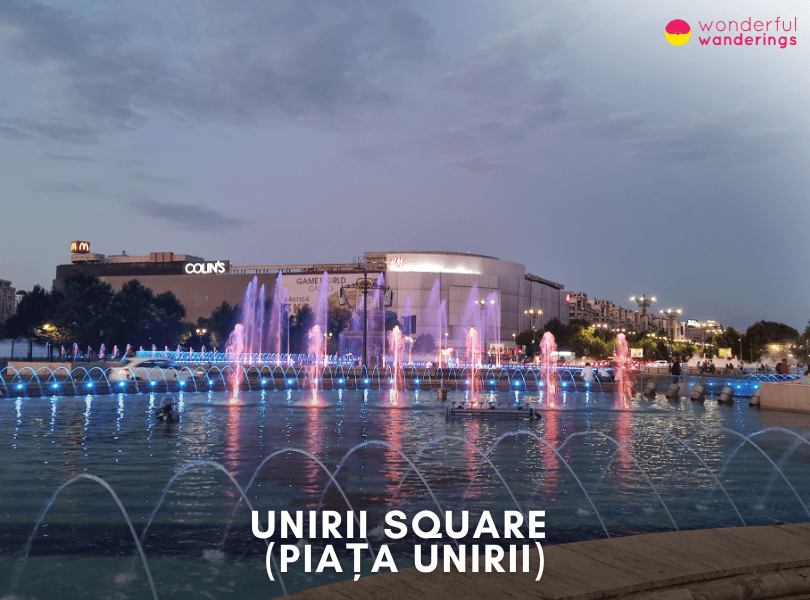
3. Tailors' Tower (Turnul Croitorilor)
The Tailors' Tower (Turnul Croitorilor) is a medieval tower located in Unirii Square, Cluj-Napoca, Romania. The address is Piața Unirii 27, Cluj-Napoca 400001. It was built in the 15th century as part of the city's fortifications. The tower gets its name from the tailors' guild, which owned the building in the Middle Ages. The tower has seven floors and is approximately 35 meters high. It has Gothic windows and loopholes. The tower has served as a fire lookout, housed a pharmacy and been used as student housing. It underwent restoration in the 1970s.
Visitors can admire the medieval Gothic architecture of the tower. The Tailors' Tower is located in Unirii Square and can be accessed on foot or by local transportation. There is no admission fee to view the tower exterior.
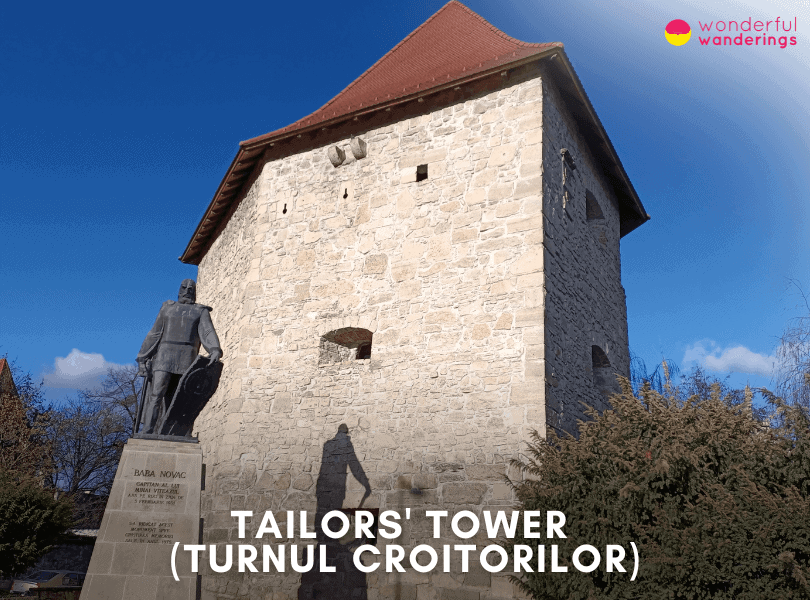
4. Ethnographic Museum of Transylvania (Muzeul Etnografic al Transilvaniei)
The Ethnographic Museum of Transylvania (Muzeul Etnografic al Transilvaniei) is located at 21 Memorandumului St, Cluj-Napoca 400020, Romania. The museum was established in 1922 and has over 40,000 artifacts related to Romanian peasant culture and life in Transylvania. The museum is housed in an 18th-century Baroque palace. Exhibits showcase folk art, costumes, ceramics, icons, furniture, tools and other traditional objects. There are both permanent and temporary themed exhibitions. The museum has a library and photo archive and hosts cultural events. There is a souvenir shop on site.
Visitors can view the exhibits to learn about Romanian culture in Transylvania. The museum can be reached by public transportation and has paid admission. It is suitable for adults and older children interested in cultural history.
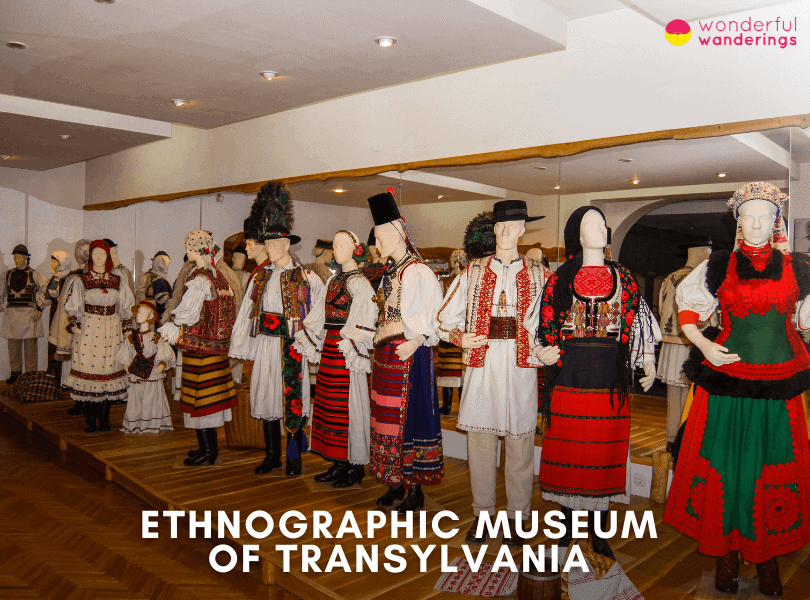
5. Central Park Simion Bărnuțiu (Parcul Central Simion Bărnuțiu)
Central Park Simion Bărnuțiu, known as Parcul Central Simion Bărnuțiu or Parcul Mare, is a large urban park located in downtown Cluj-Napoca, Romania, along the southern banks of the Someșul Mic River. Central Park is one of the main green spaces in Cluj-Napoca's city center. It covers approximately 13 hectares. The park has a history dating back over 185 years, with the land being rented in 1827 to create a recreational area. It opened to the public in the 1830s.
Visitors to the park can go for walks, relax on benches, rent pedal boats, play sports, attend events or enjoy the natural scenery. It provides an oasis from the bustling city. Central Park is open 24 hours a day year-round and admission is free. It's a popular spot for both tourists and locals in Cluj-Napoca. The park sees the most foot traffic during warm weather months when its paths, lake and beer garden are most utilized.
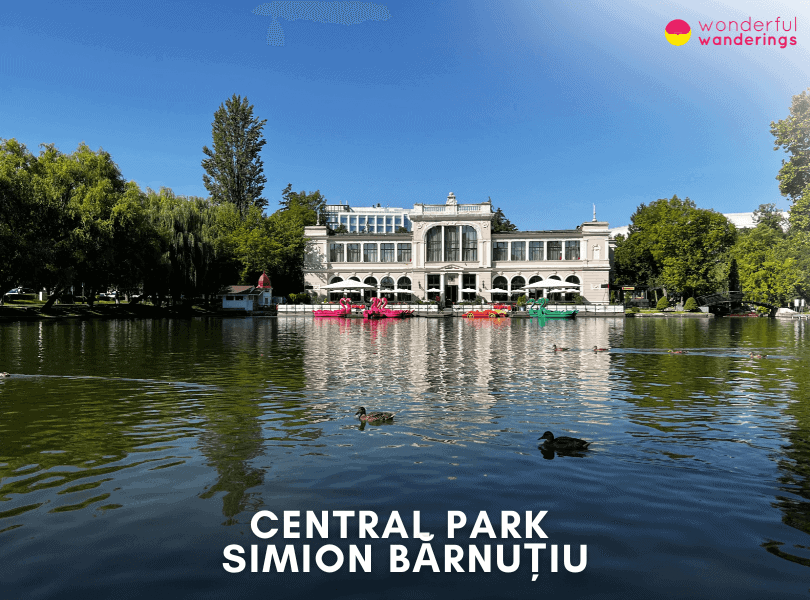
6. Alexandru Borza Botanical Garden (Grădina Botanică Alexandru Borza)
The Alexandru Borza Botanical Garden is located in Cluj-Napoca, Romania at 42 Republicii Street. It was established in 1872 by the Transylvanian Society for Natural Sciences as the Botanical Garden of the University of Cluj. The garden is named after the Romanian botanist Alexandru Borza, who was the garden director in the early 20th century. The botanical garden covers over 14 hectares and contains over 10,000 plant species from around the world, making it one of the richest botanical gardens in southeast Europe. It has a systematic department organized by plant family, an ecological department displaying plants by habitat, a medicinal plant section and a Japanese garden in the traditional gyo-no-niwa style. The garden houses a botanical museum with over 39,000 items related to botany.
Some key attractions in the garden include the Japanese Garden with its artificial lake and traditional Japanese elements, the systematic department showcasing diverse plant families and the palm house containing tropical and subtropical species. Visitors can stroll through the various themed gardens, visit the museum or simply relax and enjoy the natural beauty. The garden provides an oasis of greenery and tranquility within the city. The botanical garden is open Tuesday to Sunday from 10 am to 8 pm in summer and 10 am to 5 pm in winter.
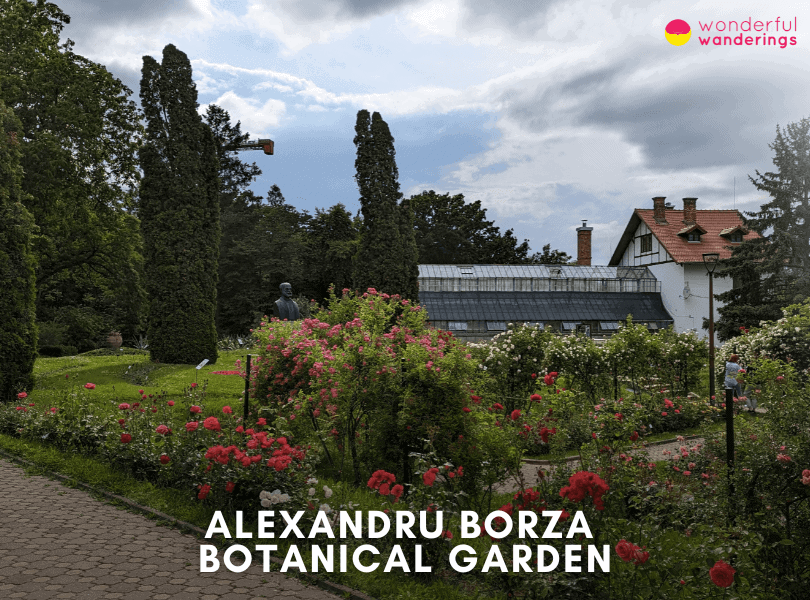
7. Cetățuia Park (Parcul Cetățuia)
Cetățuia Park is located in Cluj-Napoca, Romania on Cetățuia Hill at 1 Calea Moților. The park sits on the site of an 18th-century Habsburg fortress, built between 1715 and 1735, that gave the hill and park their name. The fortress was designed by architect Giovanni Morando Visconti in a star shape with surrounding bastions; today, only parts of the original fortress walls, four buildings and two entrance gates remain. The hilltop offers panoramic views over Cluj-Napoca and is one of the city's most popular tourist attractions. Two years after the death of Empress Elisabeth (Sissi), the hill was turned into a public park.
Key features of the park include the remains of the old fortress walls and buildings, the Heroes of the Nation Monument honoring martyrs of the 1848 revolution, outdoor fitness equipment, a children's playground, walking paths and the Belvedere Hotel's panoramic terrace. The park offers opportunities for walking, admiring the views, letting children play and accessing the hotel's restaurant and bar. It attracts families, tourists and anyone wanting to enjoy the outdoors with a beautiful vista of the Someșul Mic Valley. The park can be reached via a winding walking path with 300 steps leading up the hill. There is no admission fee to enter Cetățuia Park itself, though the hotel's facilities are privately owned. The park is open daily from 7 am to midnight and is easily accessible by car, public transport or on foot from Cluj-Napoca's city center.
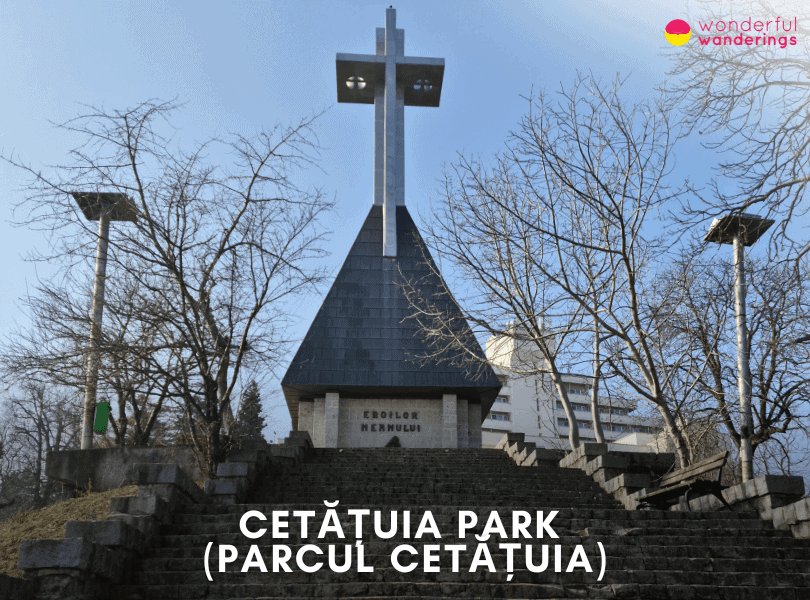
8. Assumption Cathedral (Catedrala Adormirea Maicii Domnului)
The Assumption Cathedral is Cluj-Napoca, Romania's most famous Romanian Orthodox church. It was built in a Romanian Brâncovenesc architectural style, combining Renaissance and Byzantine elements and is located in Avram Iancu Square. The Assumption Cathedral is considered a landmark of Cluj-Napoca and is known for its Romanian Brâncovenesc architectural style, which synthesizes Renaissance and Byzantine elements. Its prominent location and architecture make it one of the most recognizable buildings in the city.
Visitors can admire the cathedral's ornate interior and exterior architecture, attend religious services, light candles and view the cathedral's collection of religious art, icons, manuscripts and objects. The cathedral is suitable for visitors of all ages and backgrounds who want to view the architecture and art or attend religious services. Entrance to the Assumption Cathedral is free and open to the public during visiting hours.
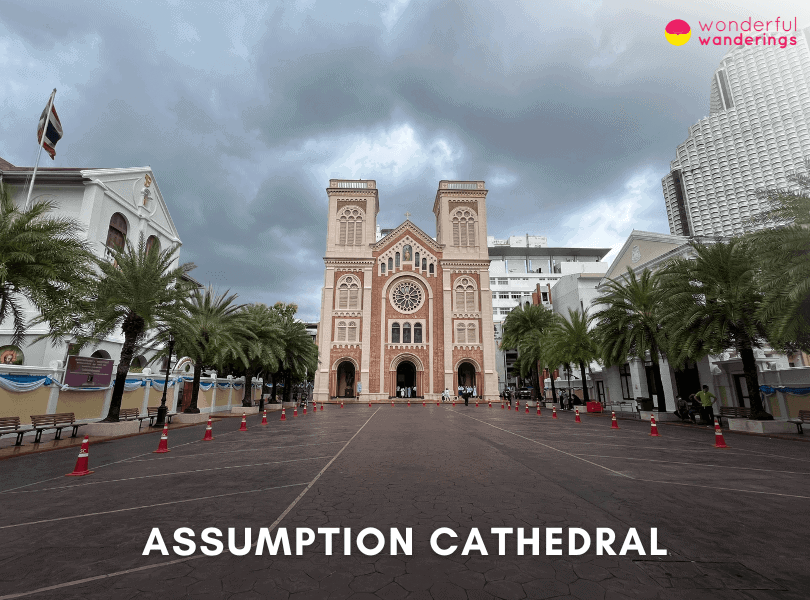
9. Avram Iancu Square (Piața Avram Iancu)
Avram Iancu Square is a central plaza located in Cluj-Napoca, Romania. It is named after the 19th-century Transylvanian Romanian lawyer and revolutionary Avram Iancu. The square features prominent landmarks like the Assumption Cathedral, Palace of Justice, Lucian Blaga National Theater and statues of Avram Iancu and Matthias Corvinus. Its central location makes it a popular gathering place.
Visitors can relax in the square, view the surrounding landmarks and architecture, visit the adjacent museums and attractions, attend cultural events or dine at one of the many nearby cafes and restaurants. The square appeals to all types of visitors interested in architecture, culture, history or just experiencing the atmosphere of the city center. It is suitable for both adults and families. There is no admission cost to enter Avram Iancu Square.
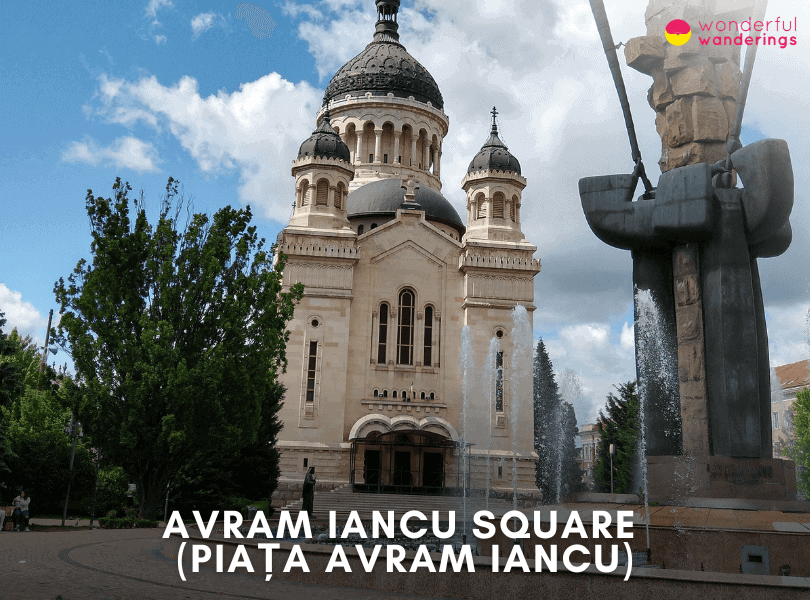
10. John the Baptist Orthodox Church in Cluj-Napoca
The John the Baptist Orthodox Church is located in the central area of Cluj-Napoca, Romania. It was built between 1923 and 1933 in the Byzantine architectural style. The church has a rectangular shape and five domes. The interior is beautifully decorated with Byzantine-style paintings and icons. Notable features include the ornate iconostasis separating the nave from the sanctuary and the many icons displayed on the walls.
The church regularly holds Orthodox services and is open to visitors outside of service times. Visitors can light candles, pray quietly or admire the beautiful architecture and paintings. Guided tours may be available upon request. Visitors can light candles, pray, attend a service, admire the icons and paintings and take photos. There is no admission fee to enter. The serene atmosphere makes it a nice spot for anyone interested in Orthodox architecture, art and culture.
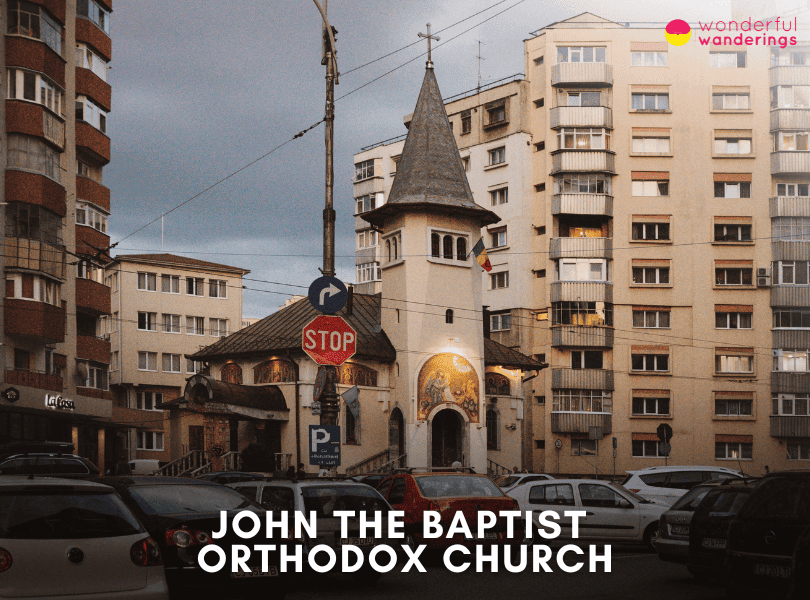
11. Romanian National Opera (Opera Națională Română)
The Romanian National Opera in Cluj-Napoca was founded on September 18, 1919, simultaneously with the National Theater and the Music Academy. It is housed in an ornate building constructed 1904-1906 in a Baroque-Secessionist style by the Viennese architects Fellner & Helmer.
The opera hall seats 928 and has excellent acoustics. The opera has staged over 200 titles from the international repertoire as well as over 40 Romanian works. It has a reputation as an important training ground for young singers, many of whom have gone on to international careers like Angela Gheorghiu. Visitors can attend performances or arrange guided backstage tours on non-performance days to view the sets and costumes and learn about the opera's history.
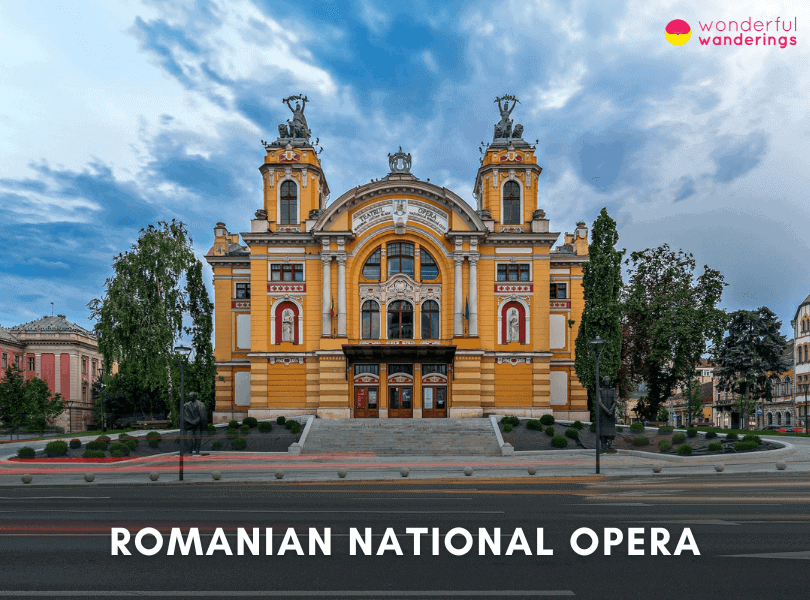
12. Matthias Corvinus House (Casa Matei Corvin)
The Matthias Corvinus House is a 15th-century Gothic building with Renaissance elements located in the city center of Cluj-Napoca, Romania, at Matei Corvin Street No. 4. It was built between 1474-1480 as a residence for King Matthias Corvinus of Hungary during his visits to the city. The interior of the Matthias Corvinus House contains various lavishly decorated rooms like the Knights' Hall, Music Room and Summer Dining Room with ornate chandeliers, carved wooden furniture and frescoed walls. Today, the building operates as a history museum displaying artifacts from medieval Transylvania.
Visitors can take guided tours to see the well-preserved interior and learn about King Matthias Corvinus's life. Temporary exhibitions and cultural events are held at the house. The Matthias Corvinus House is accessible by public transportation, located a short walk from central Lucian Blaga Square. It is an ideal activity for adults and older children interested in medieval history, architecture and art. Admission is 10 RON for adults and 5 RON for students.
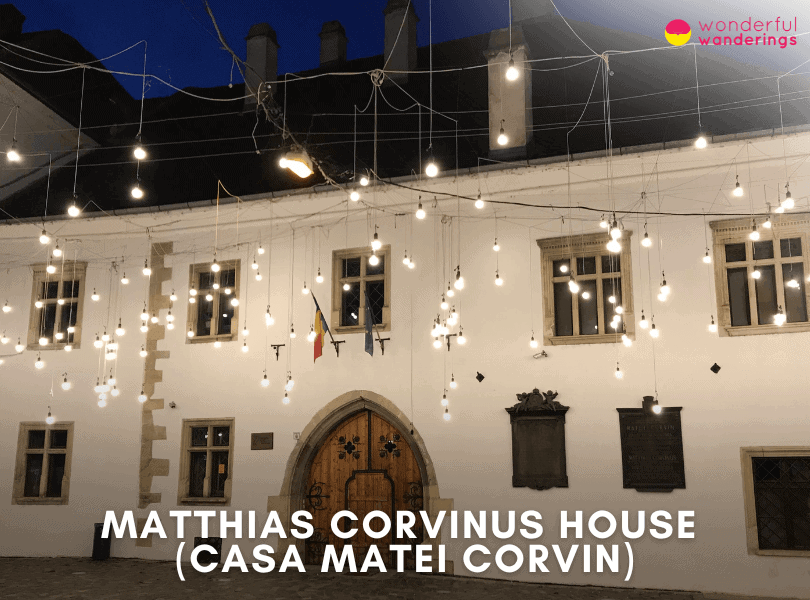
13. Turda Salt Mine
The Turda Salt Mine is an impressive underground labyrinth of tunnels stretching over 249 km beneath Turda, Romania, around 30 km from Cluj-Napoca. Mining activity at the site dates back to the 12th century. The salt mine opened as a tourist attraction in 1992. Visitors descend over 400 feet on a wooden elevator into the Unirea section of the mine. Attractions include an underground amusement park, mini-golf course, Ferris wheel, rowboat rides on an underground lake and a spa.
There are museums with interactive exhibits on the history of salt mining. Guided tours are available to see the Great Collapse Chamber, Iosif Mine and Rudolf Mine. The constant 50°F temperature and purified air provide natural relief for respiratory illnesses. Over 1 million tourists visit the Turda Salt Mine annually.
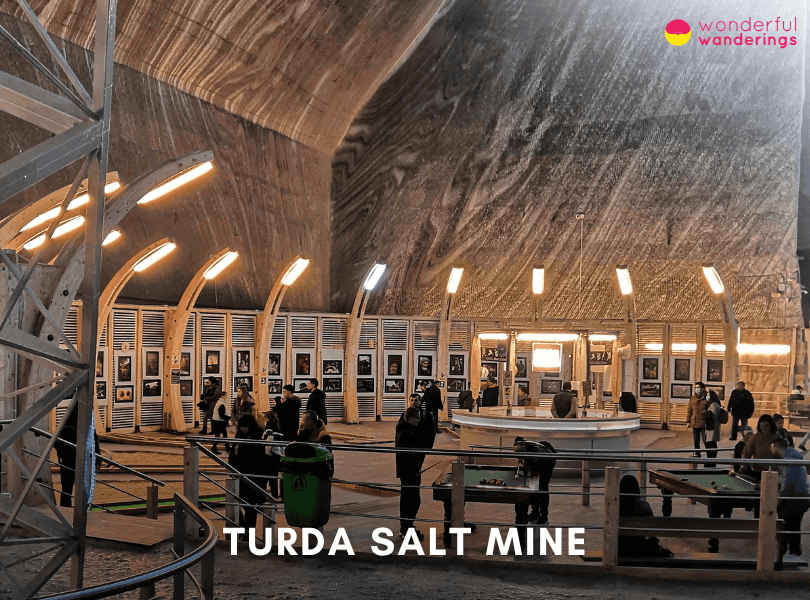
14. Steampunk Transylvania
Steampunk Transylvania is a steampunk and fantasy museum located in Cluj-Napoca, Romania. It is a unique museum that combines elements of 19th-century industrial steam-powered machinery with science fiction and fantasy. The museum spans two floors and features steampunk art installations, sculptures and gadgets created by artists. Some highlights include a time machine, steampunk weapons like a flamethrower and lightsaber, an alchemy lab, a steampunk x-ray machine and more. Visitors can interact with many of the exhibits.
Visitors can view and interact with the steampunk art installations and gadgets, walk through fantasy environments like an enchanted forest, see a secret library and hidden room, play retro video games, try on steampunk costumes and more. Guests can chat with the museum staff to learn the stories behind the exhibits. Steampunk Transylvania appeals to both kids and adults interested in science fiction, fantasy, art, imagination and interactive museums. Families, tourists, artists and steampunk fans will enjoy a visit.
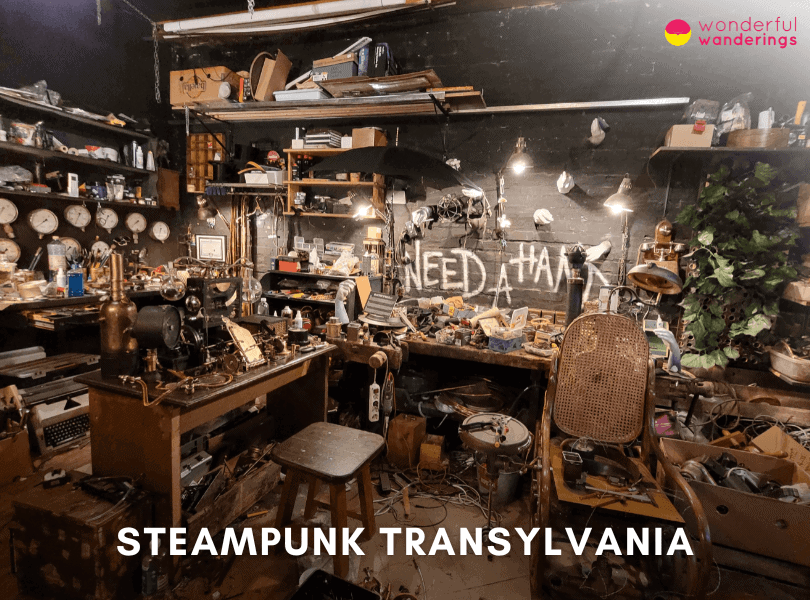
Muzeon is an open-air sculpture park and museum located in Moscow, Russia along the Moskva River. It covers 60 hectares and features over 700 sculptures dating from the early 20th century to today. The park contains works by renowned Russian artists like Vera Mukhina, Ernst Neizvestny, Dmitry Shorin and many others. Visitors can take a stroll and view a variety of sculpture styles, from Soviet realism to contemporary abstract pieces. Notable sculptures include Mukhina's iconic Worker and Kolkhoz Woman, Neizvestny's The Tree of Life and Shorin's sculptural chess set. In addition to the outdoor collection, Muzeon has indoor gallery spaces that house temporary exhibitions focused on 20th-century Russian art. Special programs like lectures, film screenings and festivals are held at the venue throughout the year.
Visitors can explore the sculpture park on foot, view over 700 works of art spanning styles and eras, relax in the garden areas, attend cultural events hosted at the venue and visit the indoor gallery spaces to see temporary exhibitions. Guided walking tours are available as well. The sculpture park and museum appeal to adults and kids interested in art, Russian culture and history. It is educational for school groups and enjoyable for families, tourists and residents.
Entry to the Muzeon Sculpture Park is free. There may be admission fees for special exhibitions inside the gallery spaces.
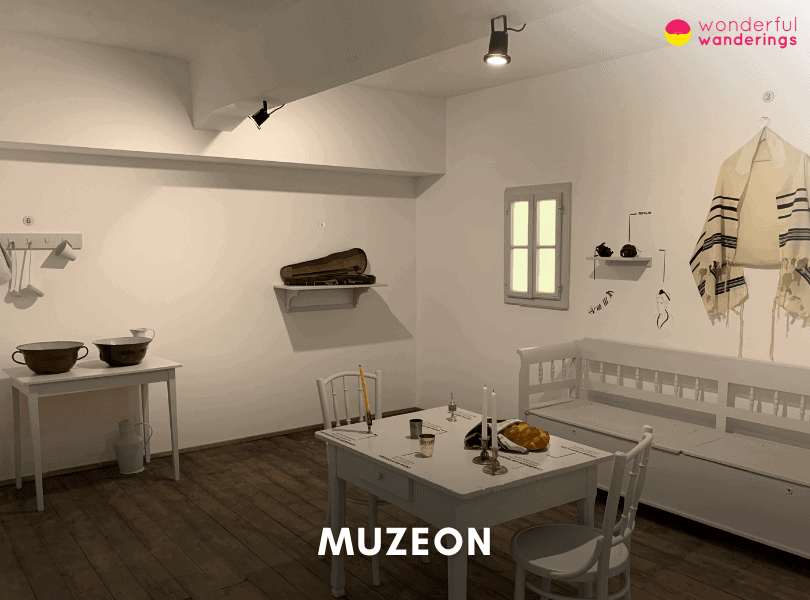
16. Pharmacy History Collection
The Pharmacy History Collection is in Cluj-Napoca, Romania, inside the historic Hintz House at 9 Eroilor Street near the Tailors' Bastion. This museum lies within the oldest operating pharmacy in Cluj, tracing its roots back over 500 years. The collection originated from objects gathered by Professor Iulius Orient and contains antique laboratory equipment, medicinal ingredients, original furnishings and documents chronicling the evolution of pharmacy practices. The museum's highlights include 16th-century albarellos, 19th-century measuring tools, the old wooden pharmacy counter and Orient’s library.
Visitors can take a free guided tour to view the historic interiors and learn about traditional healing methods. Some unusual remedies and ingredients on display include “crab eyes”, skulls and powdered mummies. The museum is best suited to pharmacy students and professionals interested in the evolution of pharmacy practices and medicinal history and general visitors interested in medical artifacts, traditional healing methods and Cluj's history. The Pharmacy History Collection offers a glimpse into Cluj’s medical past and early pharmacology.
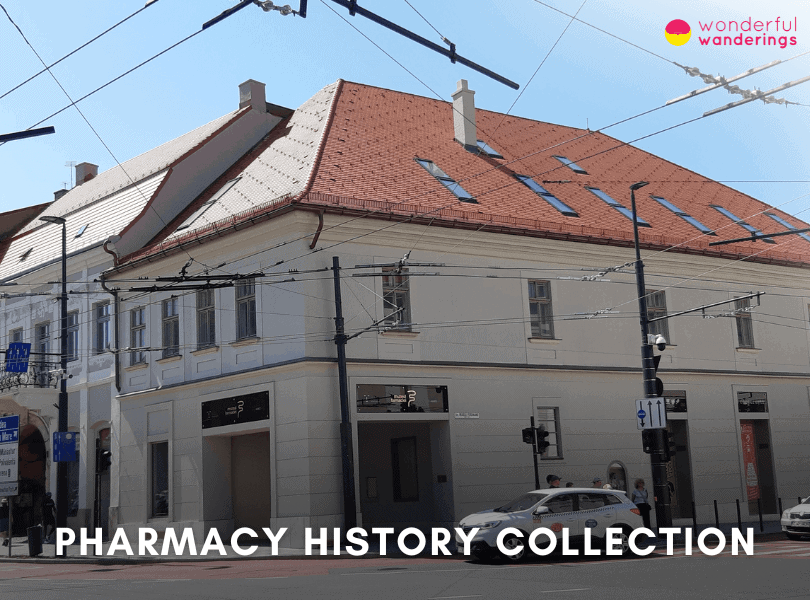
17. The Ethnographic Park (Parcul Etnografic National “Romulus Vuia”
The Ethnographic Park “Romulus Vuia” is an expansive open-air museum at 432-434 Memorandumului Street in Cluj-Napoca, Romania. It was the first ethnographic park in Romania with the aim of preserving traditional Romanian village architecture and culture from the 18th to 20th centuries. The park contains over 300 structures that provide an immersive look into rural life, including houses, barns, wells, technical installations, mills and workshops. Many of the buildings were transplanted from villages around the Transylvania region and reconstructed onsite. Highlights include the 18th-century Lenchic House, the 19th-century Ruges House and the old wooden church from Silivas village.
Visitors can also view exhibits of folk art, ceramics, costumes, tools and other artifacts. The sprawling park covers 50 acres, with walkways connecting the different areas. Guided tours are available, allowing visitors to learn about the diverse structures and past ways of life. The museum offers additional workshops, fairs and events to showcase Romanian folk crafts and traditions. Ethnographic Park is best for people of different ages and interests, especially families, students and cultural heritage tourists. It provides an engaging and educational way to explore Romania's past lifeways. The Ethnographic Park provides an immersive introduction to Romania's cultural heritage and history with its expansive collection of buildings, artifacts and activities.
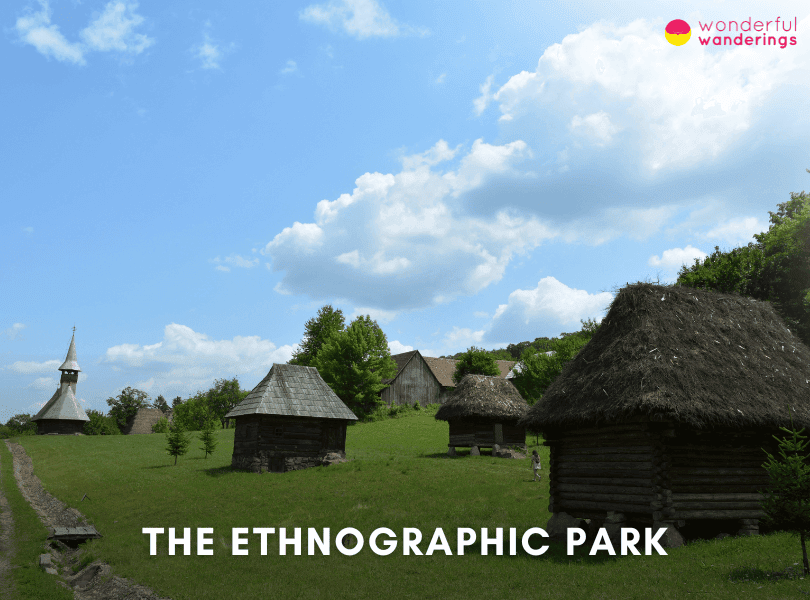
What are the best museums to visit in Cluj-Napoca?
Listed below are the best museums to visit in Cluj-Napoca.
- National Museum of Transylvanian History. The National Museum of Transylvanian History is located in the center of Cluj-Napoca. It houses artifacts and treasures that showcase the history and culture of Transylvania, with collections covering archaeology, medieval history, modern history and ethnography. Visitors can see Thracian gold treasures, medieval weapons, folk costumes and more. The museum building itself features a modern glass facade integrated into a historic building.
- Ethnographic Museum of Transylvania. The Ethnographic Museum of Transylvania in Cluj-Napoca displays the Romanian people's traditional culture and folk art in Transylvania. It has over 40,000 artifacts related to agriculture, fishing, hunting, traditional costumes, ceramics, icons and religious art. The exhibits are spread throughout two buildings, the Reduta Palace in the city center and the Romulus Vuia Park on the outskirts.
- Pharmacy History Collection. Pharmacy History Collection in Cluj-Napoca's oldest pharmacy building from 1573. The museum showcases the history of pharmacy through tools, laboratory gear and old medicinal products. It provides a glimpse into early pharmaceutical practices and medical treatments.
- Museum of Art Cluj-Napoca. The Museum of Art Cluj-Napoca houses over 12,000 works by Romanian and international artists. It has a broad collection of paintings, sculptures, graphic art, decorative art and photography from the 15th century onwards. The exhibits are displayed in a historic palace in the city center.
- Aviation Museum. The Aviation Museum in Cluj-Napoca displays Romanian aircraft models from the early 20th century onwards. Highlights include replicas of the first planes to fly in Romania, as well as models actually used in World War II. There are exhibits on aviation history, rocket engineering and astronomy.
What are the best things to do in Cluj-Napoca with kids?
Listed below are the best things to do in Cluj-Napoca with kids.
- The Central Park (Parcul Central Simion Bărnuțiu). Central Park is located in the city center of Cluj-Napoca at Strada Cardinal Iuliu Hossu. It is a large public park founded in 1827 that serves as a recreational space for residents and visitors. Kids can enjoy playgrounds, paddle boats to ride around the small island on the lake, outdoor gym equipment to play on, areas to play sports like basketball or just walking around surrounded by nature. Admission is free.
- The Ethnographic Park (Parcul Etnografic National “Romulus Vuia”). The Ethnographic Park is an open-air museum located at Strada Taietura Turcului in Cluj-Napoca, about a 10-minute drive or 40-minute walk from the city center. It features traditional Romanian village houses, workshops like pottery and blacksmith facilities, wooden churches and more that kids can explore to learn about Romanian rural life.
- The Cluj-Napoca Botanical Garden (Grădina Botanică “Alexandru Borza”). The Cluj-Napoca Botanical Garden spans 14 hectares in central Cluj-Napoca at Strada Republicii. It houses around 10,000 species of plants from around the world for kids to discover. Notable attractions include the Japanese Garden, greenhouse with tropical plants, rosarium and Roman Garden with a statue of the goddess Ceres.
- The Tailors' Bastion (Bastionul Croitorilor). The Tailors' Bastion in Cluj-Napoca serves as a cultural center with interactive exhibits for kids to enjoy. Kids can explore and learn about medieval history. General admission is free and special programs or events may have fees.
What are the best activities for a business traveler in Cluj-Napoca?
Listed below are the best activities for a business traveler in Cluj-Napoca.
- Attend a business event at the Cluj Arena. The Cluj Arena is the largest event venue in Cluj-Napoca, hosting conferences, exhibitions and other business events. With a capacity of over 30,000 people, major companies often utilize the arena for product launches, corporate meetings and networking events. It has excellent facilities for large-scale business gatherings.
- Work remotely from Impact Hub. Impact Hub is a popular co-working space located right in the heart of Cluj-Napoca. It offers private offices, meeting rooms, event spaces and hot desks in a modern environment. Business travelers can easily get work done here, with fast WiFi, printing services, free coffee and tea and opportunities to connect with the local startup community.
- Take a factory tour at Emerson or Bosch. Cluj-Napoca has attracted major international companies like Emerson and Bosch to open factories and operations centers locally. Many of these companies offer pre-arranged factory and office tours for visiting business professionals to showcase their operations. It is an interesting look into the city's business landscape.
- Attend a business networking event. Cluj-Napoca has an emerging startup and tech community. Frequent professional networking events, like those organized by ClujHub and Cluj IT Cluster, bring together entrepreneurs, investors and more. Attending these events allows business visitors to connect with potential partners.
- Enjoy the business facilities at a luxury hotel. Top hotels like Grand Hotel Italia Cluj and Hotel Napoleon offer excellent business amenities like meeting rooms, printing services, conference calls, translation services and more. Booking a room at one of these luxury hotels ensures easy access to support business needs.
Where is Cluj-Napoca?
Cluj-Napoca is located in the Someșul Mic River valley in northwest Romania , 323 kilometers (201 miles) from Cluj-Napoca, 350 kilometers (218 miles) from Budapest, Hungary and 321 (200 miles) from Belgrade, Serbia. It sits roughly equidistant from those three major cities in the historical region of Transylvania.
What is the history of Cluj-Napoca?
Cluj-Napoca has a long history, having been part of many empires and kingdoms over time, including the Roman Empire, the Hunnic Empire, the Kingdom of Hungary, the Austrian Empire and modern Romania. The area was settled in antiquity and was home to the Dacian settlement of Napoca. The Romans conquered Dacia in 106 CE and founded the city of Napoca. It was an important Roman outpost for centuries. The area changed hands many times before becoming part of the Kingdom of Hungary in the Middle Ages. Cluj served as the capital of the Grand Principality of Transylvania from 1790 to 1848 and from 1861 to 1867. Cluj continues to be an important economic, academic and cultural center in Romania.
What language is spoken in Cluj-Napoca?
The primary languages spoken in Cluj-Napoca are Romanian and Hungarian. Romanian is the official language of Romania and the native language of most residents. Cluj-Napoca sits in a historical Transylvania with a large ethnic Hungarian minority population. Many residents of Cluj-Napoca speak Hungarian as their first language. The city has a small German-speaking population. Romanian, Hungarian and German are the main languages used in the city.
What time zone is Cluj-Napoca in?
Cluj-Napoca and all of Romania are located within the Eastern European Time Zone. Cluj-Napoca falls under Eastern European Time, 2 hours ahead of Coordinated Universal Time (UTC). Cluj-Napoca uses EEST (UTC/GMT +3 hours) in the summer months and EET (UTC/GMT +2 hours) in the winter months each year.
How many people live in Cluj-Napoca?
Cluj-Napoca has a population of 324,576 people as of 2023, with 156,238 men and 168,338 women living in the city. There are 53,000 children under the age of 18, making up 16% of the population. The majority of residents are of working age, between 18-65 years old, numbering around 217,000 people or 67% of the total. There are 54,000 elderly over the age of 65, comprising 17% of Cluj-Napoca's inhabitants.
What are the most interesting facts about Cluj-Napoca?
Listed below are the most interesting facts about Cluj-Napoca.
- Currency. The currency used in Cluj-Napoca and all of Romania is the Romanian Leu (plural form is Lei). Romania is not part of the Eurozone, so Euros are generally not accepted except at some tourist-oriented businesses. Local currency is needed for most transactions.
- Time Zone. Cluj-Napoca is located in the Eastern European Time Zone, which is 2 hours ahead of Greenwich Mean Time (GMT+2) and 7 hours ahead of U.S. Eastern Standard Time. Daylight Savings Time is observed from the end of March to the end of October, temporarily putting Cluj-Napoca 1 hour ahead (GMT+3) during summer.
- Language. The official language is Romanian, which belongs to the Romance language family (as a descendant of Latin) and is the native language of over 90% of Cluj-Napoca's residents. English and German have a strong prevalence as second languages in Cluj-Napoca, especially in central areas. Some basic Romanian phrases are still helpful to know.
- Power Plugs. Power sockets in Cluj-Napoca and all of Romania are Type F, which have two round pins, similar to most European countries. The standard voltage is 230 V. Travelers from America will need power converters and adapters for U.S. plug types. Many modern devices have built-in voltage converters, but power adapters are still needed to fit Romanian outlets. Checking devices' input voltage/frequency compatibility is recommended.
How many days are needed to see Cluj-Napoca?
It is recommended to stay for three days, which is enough time to see the highlights of Cluj-Napoca. Spending three days allows visitors to explore the top sights like Central Park, St. Michael's Church, the museums, Old Town, etc., as well as have time for day trips to nearby places like Turda Salt Mine. Three days provide enough time to get a good sense of what Cluj-Napoca has to offer without feeling rushed.
Is Cluj-Napoca worth visiting?
Yes, Cluj-Napoca is worth visiting. Cluj-Napoca offers medieval Old Town architecture, lively cafes and restaurants, museums and a thriving cultural scene with concerts, theaters and festivals. The Gothic St. Michael's Church and stately Banffy Palace are two of the architectural highlights of Cluj-Napoca. Cluj has a youthful, energetic vibe. The city is surrounded by hills and forests, providing a nice base for outdoor activities.
Is Cluj-Napoca expensive to visit?
No, a trip to Cluj-Napoca can be very affordable compared to most other European destinations. Budget hotels, hostels and apartments provide cheaper accommodation than other Romanian or Western European cities. Public transportation, taxis, food and entertainment are reasonably priced. Museums, churches, parks and wandering the old town can keep costs low while sightseeing. Budget-conscious travelers have no trouble finding bargains in dining, lodging, attractions and shopping around Cluj-Napoca.
Is Cluj-Napoca safe to visit?
Yes, Cluj-Napoca is very safe to visit. It is one of Romania’s most popular tourist destinations. The city has low crime rates and is considered safe for travelers. Violent crime is rare in Cluj-Napoca. Tourist areas like the historic Lipscani district and Old Town are heavily frequented and considered safe. Cluj-Napoca's city center and attractions are well-lit and have a visible police presence. Basic precautions like being aware of your surroundings, not leaving belongings unattended and avoiding poorly lit areas at night will ensure your visit to Cluj-Napoca is trouble-free. Cluj-Napoca is safer than most European cities of its size and tourists will feel comfortable visiting.
Is Cluj-Napoca easy to visit with kids?
Yes, Cluj-Napoca is easy to visit with kids. Cluj-Napoca is a family-friendly city to visit with children. Many hotels allow kids to stay for free or at discounted rates. Attractions like the Botanical Garden, open-air Village Museum and Zoo are big hits with little ones. Bakeries and cafes typically welcome children. The pedestrian streets in the old town allow for casual strolling without traffic worries. Cluj-Napoca is generally a safe, low-crime environment, which means parents can relax while enjoying the views.
What is Cluj-Napoca famous for?
Cluj-Napoca is famous for its lively festival scene, thriving nightlife dominated by bars and clubs and gothic architecture exemplified by St. Michael's Church in the historic center. Secondly, Cluj-Napoca is an important educational hub, home to over ten universities and a large student population. Many major IT and technology companies have offices in the city, earning it the nickname “Silicon Valley of Transylvania”. Lastly, Cluj is famous as it has hosted concerts by international stars like Metallica and Elton John.
What are the most important people born in Cluj-Napoca?
Listed below are the most important people born in Cluj-Napoca.
- Matthias Corvinus (1443-1490). King of Hungary and Croatia, who expanded the kingdom through military campaigns. He was born to John Hunyadi on Saturday, February 23, 1443, in Cluj-Napoca, Romania. He promoted Renaissance culture and humanism and created one of Europe's largest libraries, the Bibliotheca Corviniana. He died on Wednesday, April 6, 1490.
- George Emil Palade (1912-2008). George Emil Palade is a cell biologist who won the 1974 Nobel Prize in Physiology or Medicine for his discoveries on ribosomes and organelles in cells. His work formed the basis of modern molecular cell biology. He was born in Cluj-Napoca on Friday, November 19, 1912 and died on Tuesday, October 7, 2008.
- Ion Luca Caragiale (1852-1912). Ion Luca Caragiale was an Influential playwright and author considered the father of Romanian national theater. His satirical plays criticized social issues in Romania and remain classics of Romanian literature. He was born on Monday, January 30, 1852, in Haimanale, near Cluj-Napoca and died on Sunday, June 9, 1912.
- Emil Racovita (1868-1947). Emil Racovita is a biologist and polar explorer who led expeditions to Antarctica. He made important contributions to biology and zoology through studies of Antarctic fauna and cave organisms. He was born in Cluj-Napoca on Friday, November 15, 1868 and died on Tuesday, November 17, 1947.
What to eat in Cluj-Napoca?
Listed below are what you can eat in Cluj-Napoca.
- Varza a la Cluj (Cluj Cabbage). Varza a la Cluj is a cabbage dish with minced meat, sour cream and herbs. It is a specialty food of the Cluj-Napoca region, popular across Romania. It dates back to the 17th century and is considered one of the most iconic dishes to try when visiting the city. This cabbage is one of the best food to eat in Romania.
- Mici. Mici is called “mititei” in Romanian. Mici are grilled skinless sausages normally made from a zesty blend of ground pork, beef and lamb before being served alongside spicy mustard, crusty bread or crispy fries. Mici is a popular food and is served at most markets in Cluj-Napoca.
- Plăcintă. Plăcintă is a crispy, flaky Romanian pastry that encases fillings like tangy cheese, savory minced meat, fresh fruit or sweetened cocoa paste before being baked or fried to golden perfection. Plăcintă is a delicacy for visitors to try in Cluj-Napoca.
- Ciorba. Ciorba refers to sour Romanian soups like silky tripe stew, hearty bean and smoked meat soup, always paired with vinegar or lemon wedges, cooling sour cream and crusty bread on the side. Ciorba is a popular soup served at restaurants in Cluj-Napoca.
- Papanasi. Papanasi are sweet, fried Romanian doughnuts stuffed with fresh white cheese, fruit jam and lightly sweetened sour cream. Papanasi is a popular finger food in Cluj-Napoca markets.
What are the best places to eat in Cluj-Napoca?
Listed below are the best places to eat in Cluj-Napoca. restaurants to eat in Cluj-Napoca.
- Casa Dacilor. Casa Dacilor serves very large portions of hearty traditional Romanian dishes meant for sharing, like grilled meats with polenta. The restaurant is known for extremely generous dishes and authentic cuisine. The decor encapsulates the traditional Romanian style with rustic wooden furniture and local cultural motifs. Many describe the food as very good and one of the best restaurants to eat in Cluj-Napoca.
- Zama. Zama offers modern interpretations of classic Romanian fare, like soups, stuffed cabbage rolls and grilled meats. Zama provides a contemporary dining atmosphere in the heart of the city. Their stylish interior design and friendly service give a relaxed yet lively ambiance while you enjoy creative updates to traditional dishes.
- Roata. Roata specializes specifically in Transylvanian and greater Romanian cuisine. This restaurant is beloved for staples like cabbage dishes, bean soups, grilled meats and fried sweet cheese pastries. The cozy, rustic interior and fair prices provide a comfortable, unpretentious place to sample authentic local flavors.
- Tokyo. Tokyo is considered the top sushi restaurant in Cluj-Napoca. It serves exceptionally authentic Edomae-style sushi and Japanese cuisine with white-glove service in an elegant dining room. The refined cuisine and polished hospitality make it a destination for fine Japanese dining in the city.
- Samsara Foodhouse. Samsara Foodhouese offers a diverse and creative vegetarian and vegan menu with globally inspired dishes like soups, curries, pasta and more. The relaxing, chic ambiance and lovely patio create a sophisticated yet welcoming atmosphere in which to enjoy their meatless cuisine.
What are the best areas to stay in Cluj-Napoca?
Listed below are the best places to stay in Cluj-Napoca.
- City Center. The city center neighborhood is located right in the center of Cluj-Napoca. It is perfect for tourists who want to be close to the main attractions like St. Michael's Church, Union Square and museums. The area has a lively atmosphere with shops, restaurants and nightlife. This neighborhood is safe for solo travelers.
- Grigorescu. Grigorescu is a quiet, upscale residential neighborhood west of the city center. It is perceived as one of the safest and greenest areas in Cluj-Napoca, with lots of trees and parks. The area has great access to public transportation for exploring other parts of the city. It offers a mix of hotels, hostels and Airbnbs, perfect for any budget.
- Zorilor. Zorilor is located northwest of the city center and is home to many universities. The area is very lively and perfect for solo travelers. It is close to major attractions like St. Michael's Cathedral, National Theater and museums. Zorilor has affordable accommodation options for students and tourists.
- Manastur. Manastur is a residential area west of the city center, close to the Somesul Mic River. It is perceived as calm, green and ideal for families. The area is very safe for solo travelers. Manastur offers a range of hotels and apartment rentals suitable for any budget.
- Marasti. Marasti is a central neighborhood just south of the city center. It is a well-developed area with modern office buildings, shops, restaurants and cafes. There are nice hotels and apartment rentals in Marasti at affordable prices. The area is considered very safe for solo travelers.
What are the best accommodations to stay in Cluj-Napoca?
Listed below are the best accommodations to stay in Cluj-Napoca.
- Grand Hotel Napoca. The Grand Hotel Napoca is considered one of the top luxury hotels in Cluj-Napoca due to its central location, elegant decor and high-end amenities. Its proximity to attractions like St. Michael's Church and museums in the historic city center makes it one of the best hotels to stay in Cluj-Napoca.
- Hotel Victoria. Hotel Victoria is considered a top accommodation option for its modern amenities and proximity to attractions like Central Park and the Botanical Garden. Its 4-star service, air-conditioned rooms and central location help make it a go-to hotel in Cluj-Napoca.
- Hotel Agape. Hotel Agape is considered one of the best values in Cluj-Napoca for its cozy rooms and quiet location. The hotel's free parking, simple decor and proximity to the Somesul Mic River make it a top choice for tourists.
- Zen Hostel. Zen Hostel is regarded as one of the top hostels in Cluj-Napoca for its perfect location in the lively Zorilor neighborhood. Its affordability, social atmosphere and convenience for exploring the city help make it an ideal hostel option.
- Lol & Nori Boutique Hotel. Lol & Nori Boutique Hotel is considered a top boutique accommodation for its central location and stylish, modern rooms. Its contemporary decor, on-site restaurant and soundproofed rooms help make it a stand-out boutique choice.
How to get from Cluj-Napoca to Bucharest Henri Coandă International Airport?
There are a few ways to get to Bucharest Henri Coandă International Airport from Cluj-Napoca. These are by bus, car, taxi/rideshare, train and plane. Firstly, Direct bus services are available with multiple companies operating daily routes between the cities; the trip takes 8-9 hours to cover 360 kilometers (223 miles) with frequent departures. Secondly, driving 360 kilometers (223 miles) allows flexibility but can be tiring over 4-5 hours; costs include fuel, small tolls and airport parking fees. Thirdly, services like Uber offer door-to-door rides covering the distance in about 5 hours for a high cost of €91 ($100, £79) and above. Fourthly, direct trains from Cluj-Napoca to Bucharest's main station take 5-6 hours to cover the distance. Lastly, plane flights from Cluj-Napoca Airport to Bucharest take 1 hour to reach Bucharest International Airport.
How to get from Cluj-Napoca to Bucharest?
There are a few ways to get from Cluj-Napoca to Bucharest . These are by bus, train, car and plane. Firstly, buses provide affordable transport between the cities in 8-9 hours and have frequent daily departures. Secondly, the train takes 5-6 hours to cover the 360 kilometers (223 miles) distance between Cluj-Napoca and Bucharest's main station and has 1-2 limited daily departures. Thirdly, driving the distance allows flexibility but takes 4-5 hours; costs include fuel and tolls. Lastly, direct flights are available between the Cluj-Napoca and Bucharest airports, taking 1 hour with multiple daily options.
Where to go shopping in Cluj-Napoca?
There are several great places to go shopping in Cluj-Napoca. These are Iulius Mall, Platinia Shopping Center, Central Shopping Center and VIVO! Cluj-Napoca. Firstly, Iulius Mall opened in 2007, with over 200 shops, a food court, a hypermarket, a cinema complex and a skating rink. The mall features brands like Zara, Massimo Dutti, H&M and more. Secondly, Platinia Shopping Center, which features a modern glass facade, opened in 2017. The mall has shops, supermarkets, restaurants, casinos, international and local brands. Thirdly, the Central Shopping Center is one of the oldest shopping centers in the city. The mall has a variety of stores like clothing, shoes, toys, cosmetics and more. It has restaurants and game centers. Lastly, VIVO! Cluj-Napoca is a large shopping complex with over 160 shops alongside hypermarkets, cinemas, a food court and brands like Zara, C&A and Decathlon.
What festivals or events are taking place in Cluj-Napoca?
Listed below are the festivals or events that are taking place in Cluj-Napoca.
- Transylvania International Film Festival (TIFF). The Transylvania International Film Festival (TIFF) is one of the largest film festivals in Romania, showcasing international and Romanian films over the course of several days in late spring/early summer. Held annually since 2002, it features film screenings, workshops, panel discussions and networking events for industry professionals and film enthusiasts. The festival takes place at venues across Cluj-Napoca, centered around the National Theatre, Cinema Florin Piersic and outdoor screenings in Union Square. The festival attracts 100,000 attendees flocking to the city each year. TIFF brings an energetic and celebratory atmosphere while highlighting cinematic arts and culture. TIFF is one of the anticipated festivals in Cluj-Napoca.
- Untold Festival. The Untold Festival is a major four-day electronic music festival held annually in early August in Cluj-Napoca. The festival features some of the world’s top DJs and electronic music artists performing on multiple stages at the Cluj Arena stadium and venues throughout the city. Untold incorporates elaborate set designs, eye-catching art installations, dance competitions, gaming areas and other activities into the festive atmosphere.
- Electric Castle Festival. The Electric Castle Festival is a multi-genre music festival held annually at Bánffy Castle, located in Cluj-Napoca, in the village of Bonțida. Electric Castle incorporates art installations, technology-integrated designs and a variety of outdoor activities into the festival atmosphere. The festival offers a unique setting to enjoy music of all genres while taking in Transylvania's history and natural beauty with the medieval Bánffy Castle as a backdrop.
PIN FOR LATER
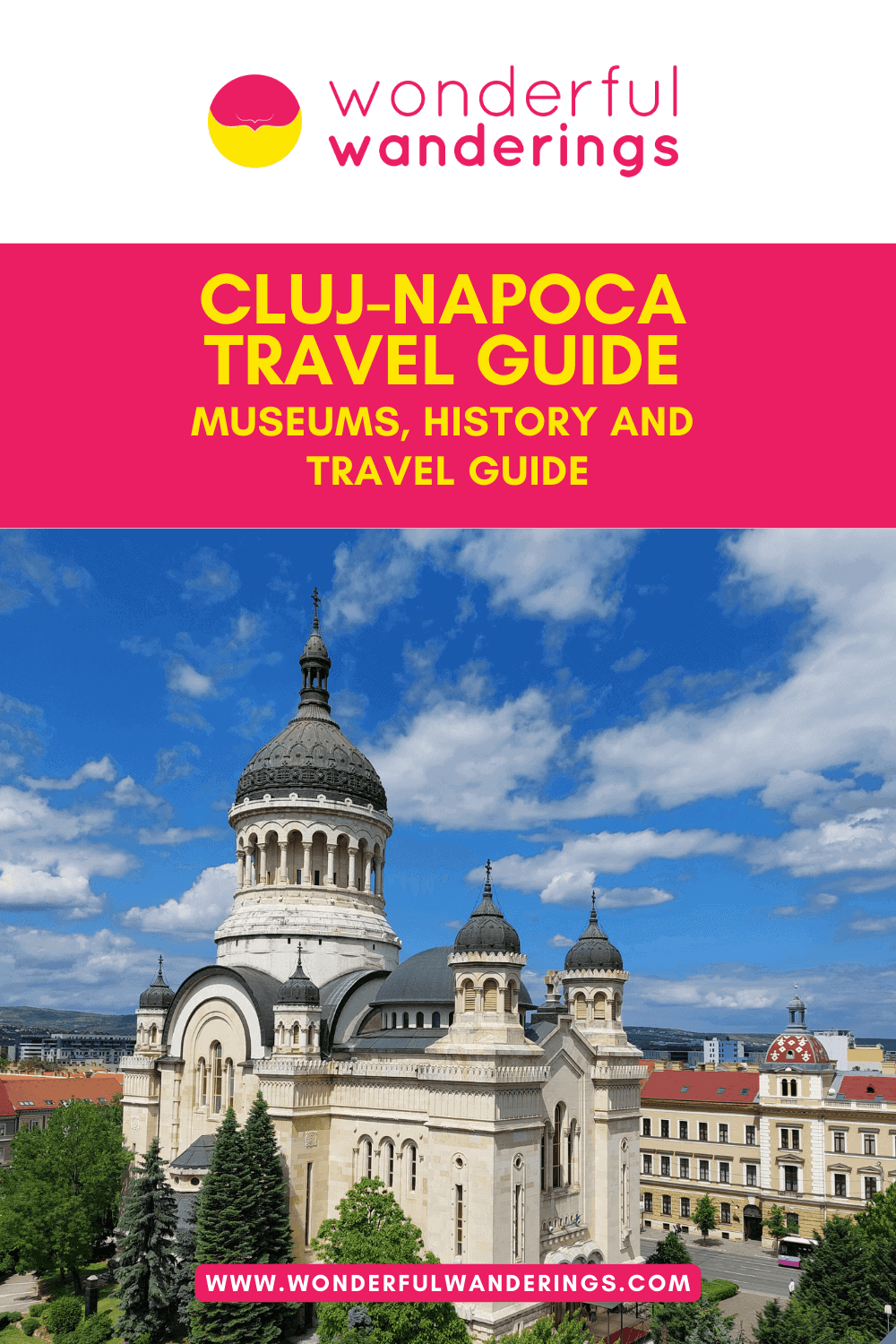
Find below the best posts about Romania.

16 Best Destinations in Romania to visit all year round!

19 Great Things to Do in Brasov, Museums, History and Travel Guide

18 Best Things to Do in Constanta: Museums, History and Travel Guide

17 Cool Things to do in Timisoara: Museums, History and Travel Guide

18 Top Things to do in Bucharest, Museums, History and Travel Guide

Celebrate Halloween in Romania on a 7-day Transylvania tour
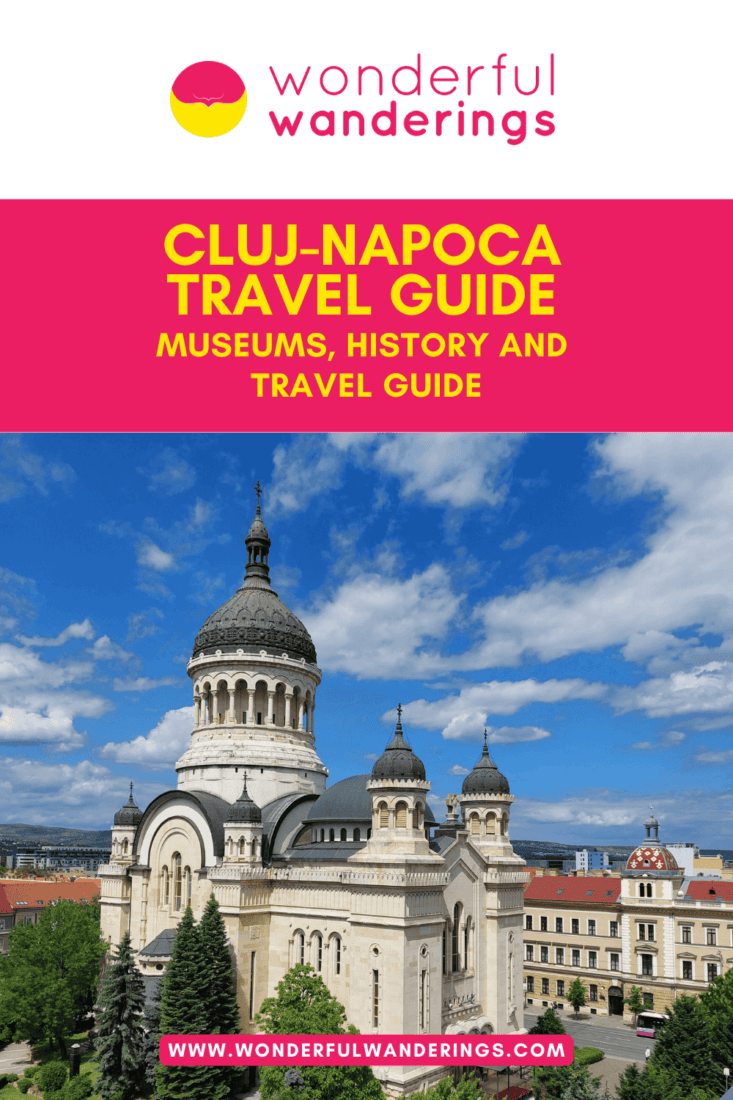
The editorial team at Wonderful Wanderings brings together travel experts with backgrounds in travel writing, web development and digital marketing. The team, through their collaborative effort, provides readers with relevant travel experiences and up-to-date digital content. The vast expertise within the team ensures an informative blend of travel stories and useful online travel guides and trip experiences, built on a foundation of both industry recognition and hands-on global adventures. Learn more about Wonderful Wanderings
Your email address will not be published. Required fields are marked *
Join 58,000+ other Wonderful Wanderers!
As an Amazon Associate I earn from qualifying purchases.

Top Things to Do in Cluj-Napoca for the First Time Visitor
Home » Visit » Travel Ideas » Top Things to Do in Cluj-Napoca for the First Time Visitor
- Attractions in Transylvania
- Travel Ideas
- things to do
- Transylvania
- travel tips

Diana Condrea

If you are planning a trip to Transylvania, be sure to save a few days for Cluj-Napoca. You’ll be delighted for sure as this is today one of the trendiest cities in Romania for the young. Our insider guide to the top things to do in Cluj-Napoca will help you make the best out of your time in this cool place that dates back to ancient times.
1. See the city from above
This should definitely be on your list of things to do in Cluj-Napoca. In fact, we suggest you do it before visiting the city. You’ll get the best view from an old fortification point known as Cetatuia that dates from the time of the Habsburg Empire. The fortification was built in 1735, on q taller hill outside the city, as a strategic point of defense and observation.
Catch the sunrise from Cetatuia for some great photos of Cluj-Napoca.
2. Visit the Botanical Garden
A visit to the Botanical Garden is one of the great things to do in Cluj-Napoca for a first-time visitor. One of the must-see attractions, the Botanical Garden was founded by Professor Alexandru Borza from the University of Cluj-Napoca back in 1925. It’s today one of the most popular places in the city, with over 150,000 visitors every year.

The Botanical Garden
3. An evening at the National Theater or the Romanian Opera
Spending an evening at the National Theater or the Romanian Opera will be one of your favorite things to do in Cluj-Napoca if you enjoy cultural events. Across the street, in Avram Iancu Square, you’ll see the Metropolitan Cathedral, built between 1920 to 1930, the third-largest cathedral in Romania and a symbol of the Orthodox Church in Transylvania.
Check the events schedule on www.operacluj.ro

The Opera House
4. Visit Saint Michael Church
Unirii Square is the central attraction of the city and the place where you can find the second largest Gothic church in Romania. The construction of Saint Michael Church began in the 14th century and the monument remains until today one of the most impressive in the country. The church is guarded by the statue of Matias Corvin, one of the greatest rulers of the Hungarian Kingdom, the son of Ioan of Hunedoara, a true hero of the anti-Ottoman wars.
You can discover more about the two princes at Corvin Castle .

Saint Michael Church
5. Relax in the Museum Square
The dense network of small streets in this area makes it a great place for walking around the historical part of Cluj-Napoca. Important old monuments you’ll see are Matias Corvin’s house, the 13th-century Franciscan church, Mikes Palace, and the 1817 Obelisk dedicated to Francis the 1st and his wife, Carolina, the first Austrian emperors who visited the city.
6. Travel back in time
A visit to the open-air Romulus Vuia National Ethnographic Museum is for sure one of the top things to do in Cluj-Napoca. The traditional houses and installations people used back in the day will take you on an interesting and interactive cultural trip. You will see what methods were used for woodworking, grinding grains, modeling clay, how gold used to be obtained, and many other bygone activities.
7. Walk as much as possible
Cluj-Napoca has lots to offer, especially if you take longs walks and you let it surprise you. Check the Central Park, ride a bike, or just experience the feeling of being surrounded by nature right in the middle of a crowded city. Lose yourself on the streets and don’t be shy to ask for advice, locals are friendly and proud to show off their beautiful city.

Decorative elements, historical house
8. Engage in an original pubbing experience
Not only the city has some of the best universities in the country, but also some of the coolest pubs. For sure, one of the best things to do in Cluj-Napoca is to explore its trendy pubs and bars where you can grab a beer or enjoy a delicious meal. You have plenty of options to keep your evenings occupied.
9. Join the festival fever
Romania is quickly becoming a major festival destination, and Cluj-Napoca is no exception. The city hosts some of the most popular events. Are you a film fan? There is Transylvania’s International Film Festival with select international participation. Do you love jazz music? There is Jazz in the Park. And let’s not forget major music festivals like Untold and Electric Castle .

Untold Festival
10. Go outside Cluj-Napoca
There is plenty to see and do everywhere in Transylvania, including close to Cluj-Napoca. You can visit the world-famous salt mine from Turda, spend a day at Belis Lake, or take a one day trip to Apuseni Mountains. Horseback riding, paragliding, and hiking are among the best options for an active day away from the city.

Turda Salt Mine
Photo by Cristian Bortes via ro.wikipedia.org
We hope our guide to the top things to do in Cluj-Napoca for first-time visitor will make you curious because the city has so much more to offer.
If you’re already planning your vacation in Cluj-Napoca, don’t forget to book your accommodation in time especially if you’re going to one of its many festivals.
Where to stay
You have many options, depending on your budget and preferences. If you prefer a hotel, we recommend Hotel Capitolina City Chic and Lol et Lola Hotel . Booking an apartment is also a solid option as there many available choices. We recommend Cluj Apartments , Apartament Belvedere , Cluj ApartHotel , and Central River Apartment.
Related posts

Top Five Day Trips from Bucharest You Should Take

Visit Maramures: 10 Things to Do in the Land of Wood

The Most Beautiful Roads in Romania You Should Drive
Leave a reply cancel reply.
Your email address will not be published. Required fields are marked *
Save my name, email, and website in this browser for the next time I comment.
I have read and accepted the Privacy Policy *
Travel tips
Location: Cluj-Napoca, Cluj County
Nearby attractions: Turda Gorges, Apuseni Mountains
Access: International Airport Avram Iancu, E81 from Bucharest
In order to give you a better browsing experience, this site uses cookies.
If you agree, please close this notice or learn more about the cookies policy here | OK, close
Pentru a va oferi o experienta de navigare mai buna acest site foloseste cookies.
Daca esti de acord cu acestea, inchide aceasta notificare sau afla mai multe despre setarile cookies aici | OK, inchide
- No translations available for this page
Monday, 29 April 2024
Follow us on social media

Earth's Attractions – travel guides by locals, travel itineraries, travel tips, and more
Insider travel guides, travel tips, and travel itineraries – Amazing places to see in the world!
- Travel Guides
A complete travel guide to Cluj-Napoca, Romania
Cluj-Napoca, usually referred to as Cluj, is a beautiful Romanian city. Located in the worldwide famous region of Transylvania, Cluj has a lot to offer to its visitors: beautiful buildings, a small beach, a splendid ethnographic museum, a famous forest, and a beautiful, impressive salt mine close to it. I’m inviting you today to find out more about the city from this guide written by Oana and Cristian from Around the Compass . This complete travel guide to Cluj includes famous landmarks, off the beaten path attractions and things to do, where to eat recommendations, and tips.
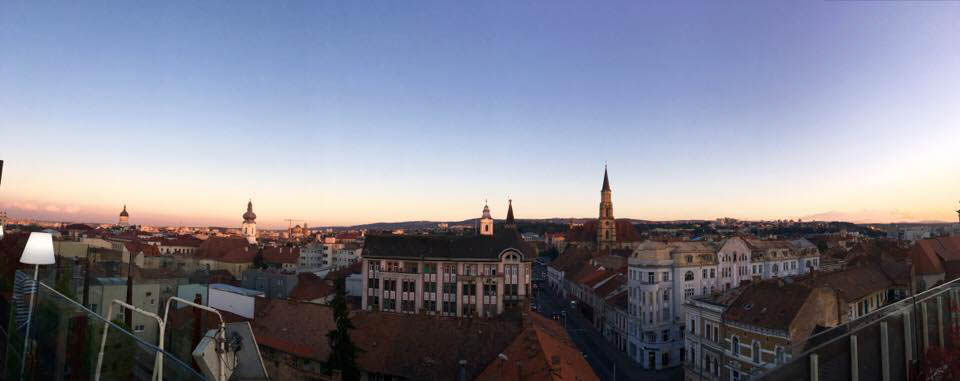
Cluj-Napoca, or just simply Cluj, is the second city after the capital, Bucharest, with regards to population and the unofficial capital of the region commonly known as Transylvania. It is home to the country’s largest university, Babe?-Bolyai, which makes the influx of students quite big. Coupled with the fact that a lot of companies are opening up offices here, especially IT, results in a very lively city with a big party scene. With an international airport, Cluj makes it easy to get to and travel around Transylvania, but it is a destination in and of itself as well, catering to everyone, from architecture lovers to food enthusiasts.
Top 5 landmarks of Cluj-Napoca
1. Old Town Centre and its pedestrian areas. The cobbled streets of the old town centre are as if taken from another time, surrounded by old buildings. These streets come to life during evenings, especially when the weather allows for outside sitting, as there are numerous cafés, restaurants, bars and pubs. During the day, multiple craftsmen set up stalls in the market region for exhibition and sale of their arts and often small concerts are held here.
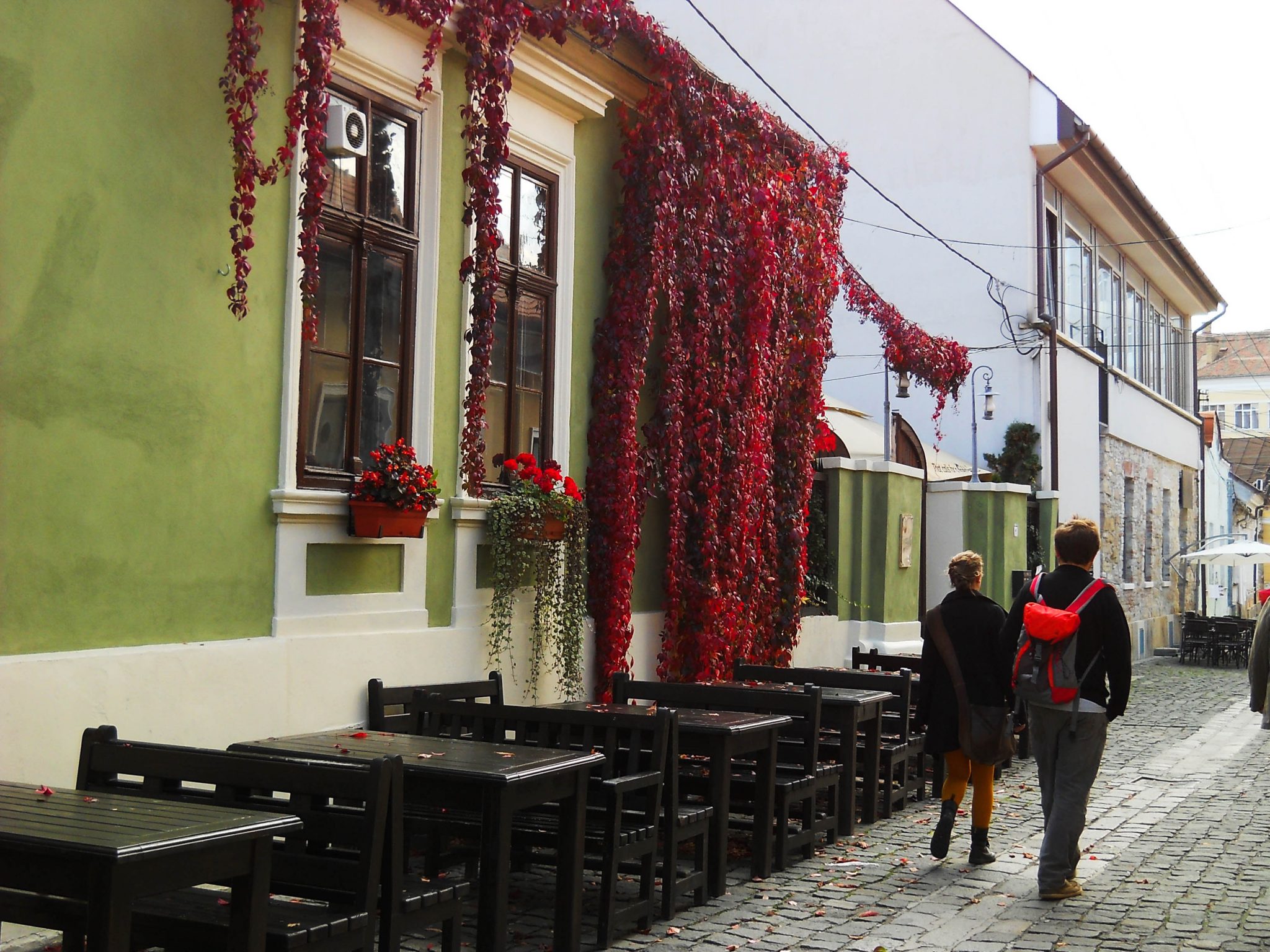
2. St. Michael’s Church & Unirii Square St. Michael’s Church is a Roman Catholic church built in a gothic style, completed at the middle of the 15th century and named after the Archangel Michael, the patron saint of the city. With its tower reaching 80 meters in height, it is the tallest church in Transylvania. The square around the church from where the city spreads out, called Unirii (Union) is used for hosting medium-sized concerts and during winter it becomes an ice skating rink and the main setting of the Christmas market.
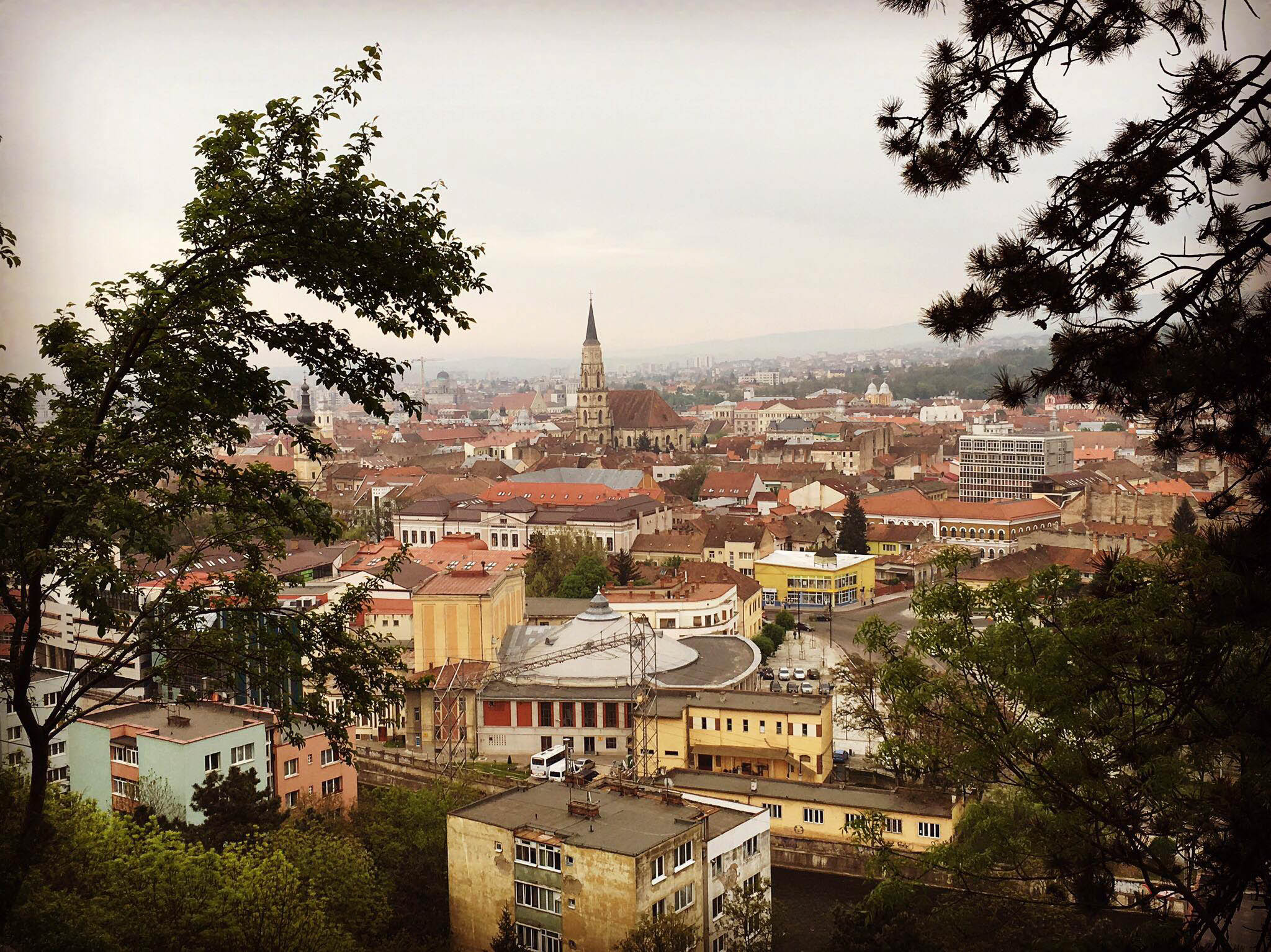
3. Central Park The park is great a stroll, be it during the day or during the night. At its western end you can find the Casino, a Viennese-inspired building, where various cultural events and concerts are organized. The lake near the Casino allows for renting out rowing boats or ice skating during winter and there is even a restaurant with a terrace overlooking the lake. All in all, the park is a great place to relax and unwind.
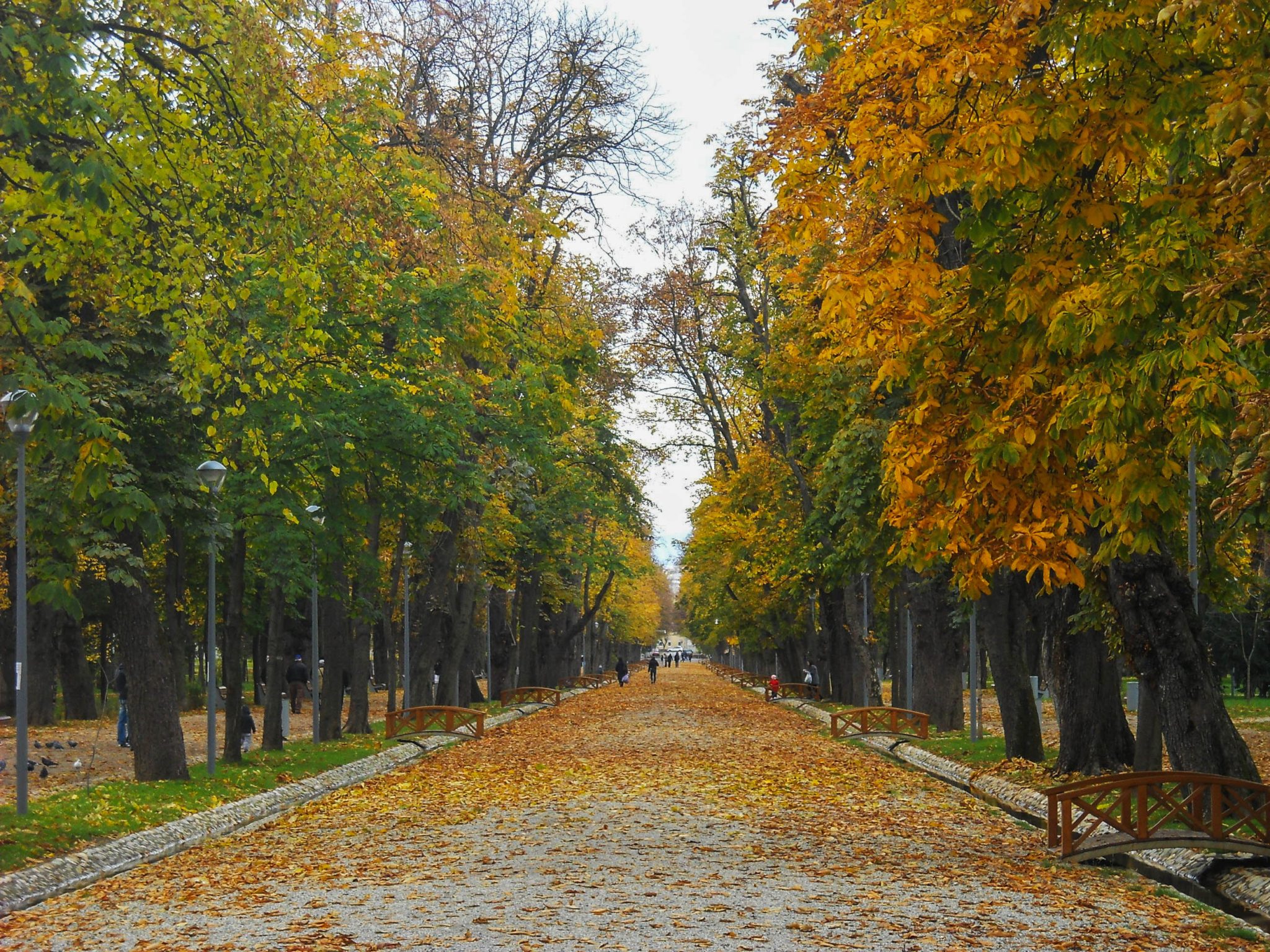
4. Botanical Garden In addition to its role as a leisure place, the garden serves as a teaching and research center for the university. It has 14 hectares and over 10.000 plants from across the world, divided into multiple sections. A main attraction is the Japanese Garden, designed with an Asian theme and a Japanese style house. Another special attraction is the Roman Garden, which also houses archeological remains from the Roman colony that used to inhabit the region.
5. Cetatuia Hill If panorama opportunities are what you’re after, look no further than the Cetatuia Hill. After a short, but rather steep climb, the whole city unwinds before you. A perfect spot for pictures or just for a stroll, it is recommended to get here both during the day and during the evening.
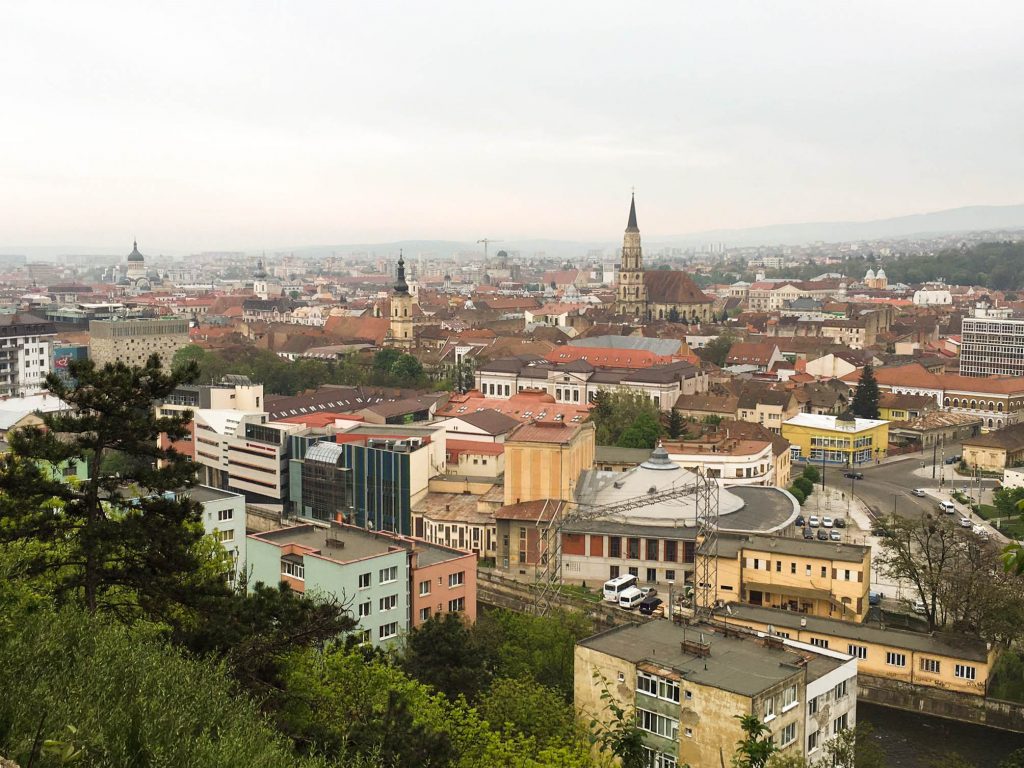
Cluj Off the Beaten Path
Cluj is crossed by the Somes river, so a walk along the car-free river side can be very pleasant and different from exploring the crowded inner city; there’s even a small beach where you can stop for a picnic/drink and just enjoy the sound of the stream.
Escape the city rush and get a glimpse of the Romanian village in the Ethnographic Park „Romulus Vuia”.
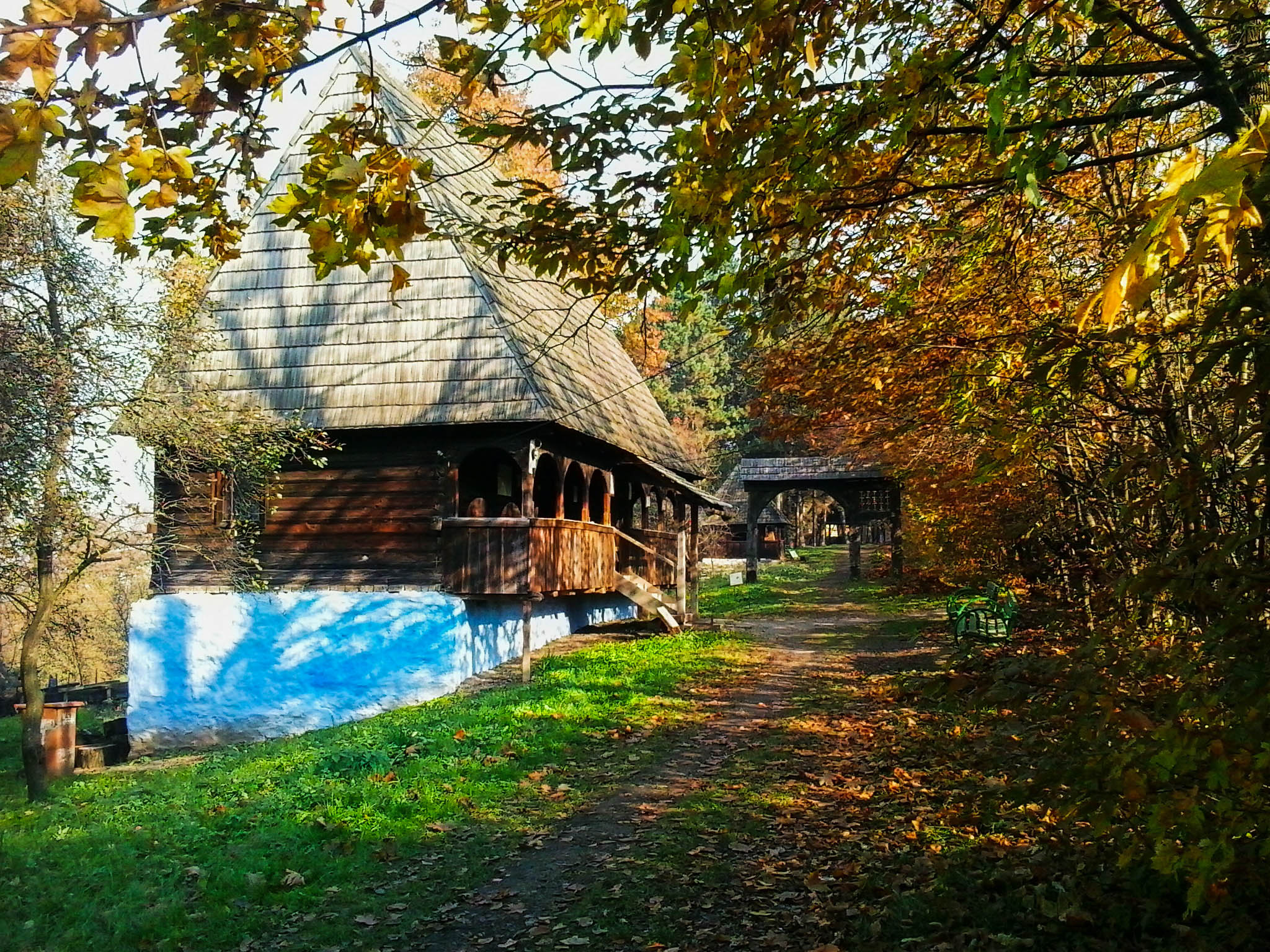
Just 10 minutes’ walk away you can trek through Hoia forest , allegedly a haunted forest due to repeated reports of paranormal phenomena. It shouldn’t be anything different than a usual walk through any other forest, but for some extra chills & thrills you can book a night tour of the forest with these guys: //hoiabaciu.wixsite.com/project .
Andrei Muresanu neighbourhood located in the south of the city center, is a very charming part of town with beautiful houses and courtyards; it’s very likely you’ll be coming across more cats than people. If you visit it in autumn, you will be charmed by the grapes’ smell coming from all the vines.
The Paintbrush Factory is an actual factory building turned into a cultural space where local artists base their galleries and activities. The galleries are opened daily and theatre and dance shows happen every weekend.
Where to Eat in Cluj-Napoca
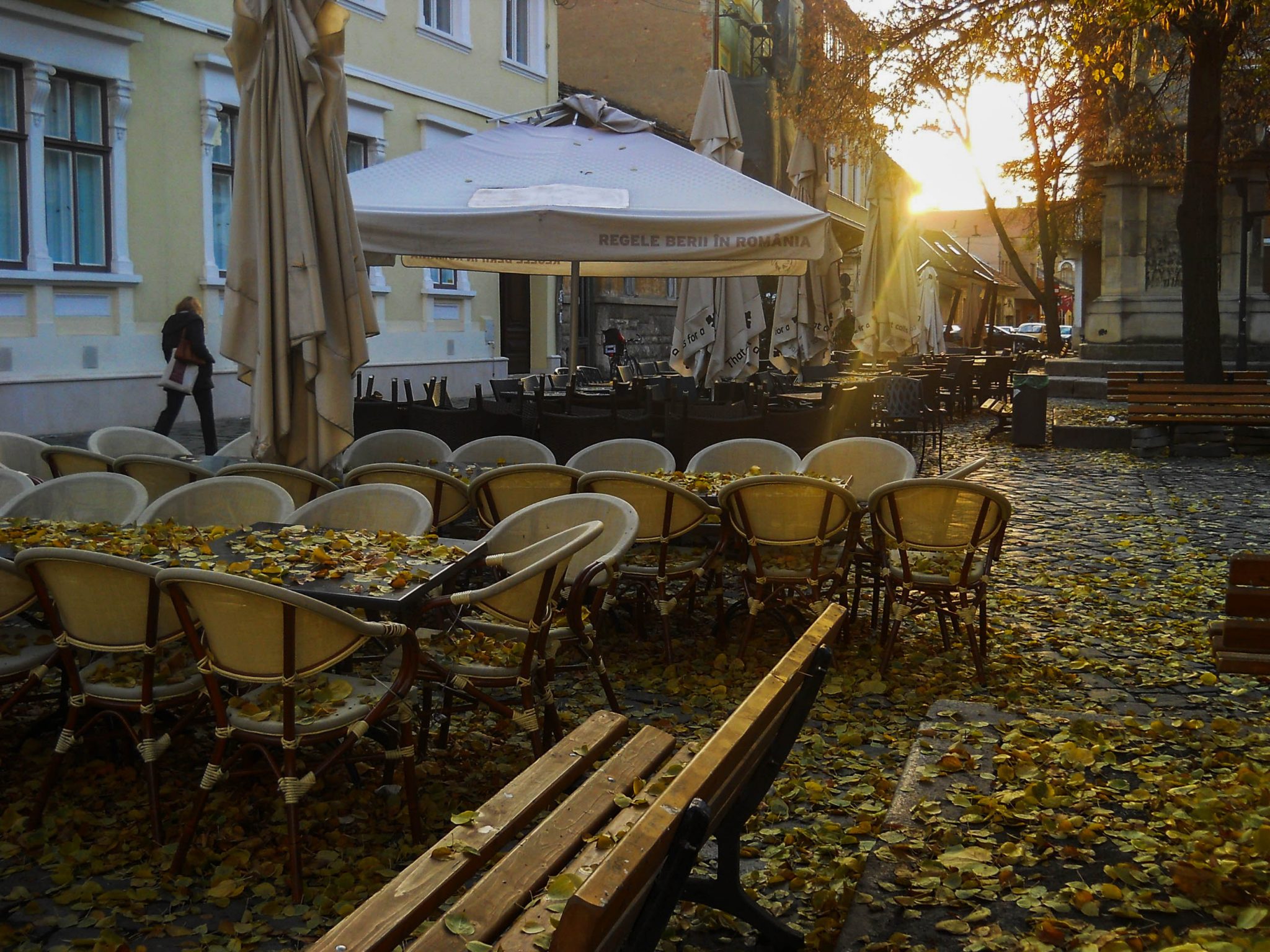
Cluj’s offering is just as rich as any other cosmopolitan European city, from posh restaurants, bistros and pubs to fast-food chains addressing the rumbling bellies of hundreds of students.
For some local Transylvanian cuisine, you cannot miss Roata Restaurant and Zama Bistro, where soups and mouthwatering Romanian dishes are at their best.
If you’re into lighter stuff, try Mint Bistro for savoury pies or the vegetarian/vegan restaurant Samsara Foodhouse.
When the sweet tooth kicks in, you can stop for deserts at Cafe Francesca located in Museum’s Square where they have the loveliest of homemade cakes and cookies and it’s the only place in town where you’ll be sharing a table with a giant teddy bear, you’ll see what I’m talking about. If the Cetatuia Hill was not enough, Klausenburger is a restaurant with a great view of the city, being at the top level of a shopping mall, and they also have their own brewery, if you want to taste some local beers.

Tips for Cluj

Cluj guided tours are free tours in English everyday starting at 6PM – meeting point is in Unirii Square.
The summer months are marked by some of the major festivals in Romania and Eastern Europe. If you’re interested in doing cultural/music tourism be sure to check : – TIFF – Transylvania International Film Festival in June – Electric Castle Festival in July – Untold Festival in August
Getting around the city is relatively easy, public transport being quite well developed and cheap.
If you’re planning on day trips from Cluj, check out Turda Salt Mine , one of the coolest underground places in the world as ranked by Business Insider, or the Turda Gorge, a canyon and natural reserve approximately 15 km south-east from Turda.
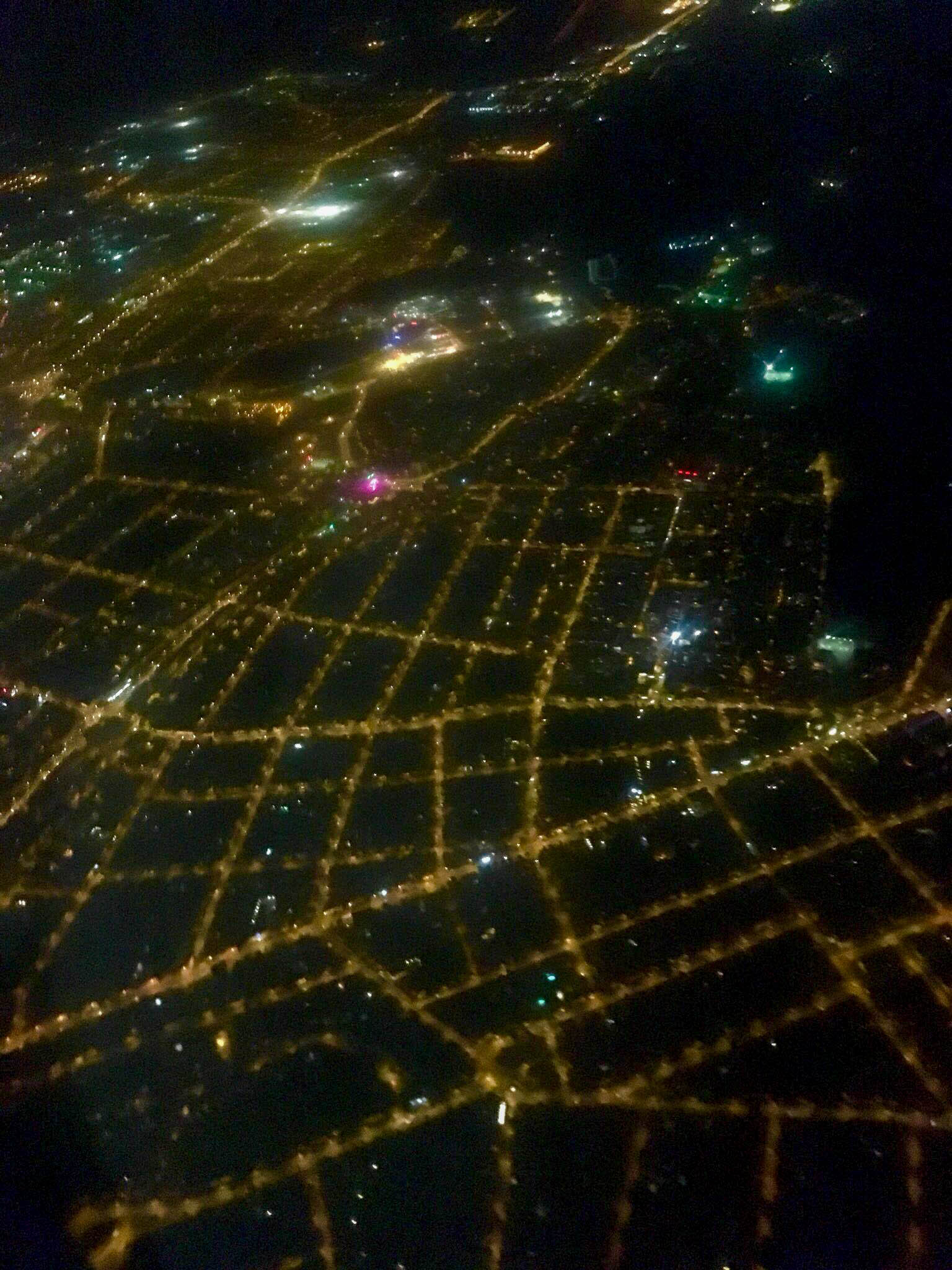
About the authors
Oana and Cristian are a Romanian couple currently living in London. They started their travel blog, Around the Compass, in May 2016. The idea behind it was coined while they were on a bus in Iceland. While still working full-time, they take advantage of every holiday to visit new places and experience new cultures. Follow them on Facebook and instagram.
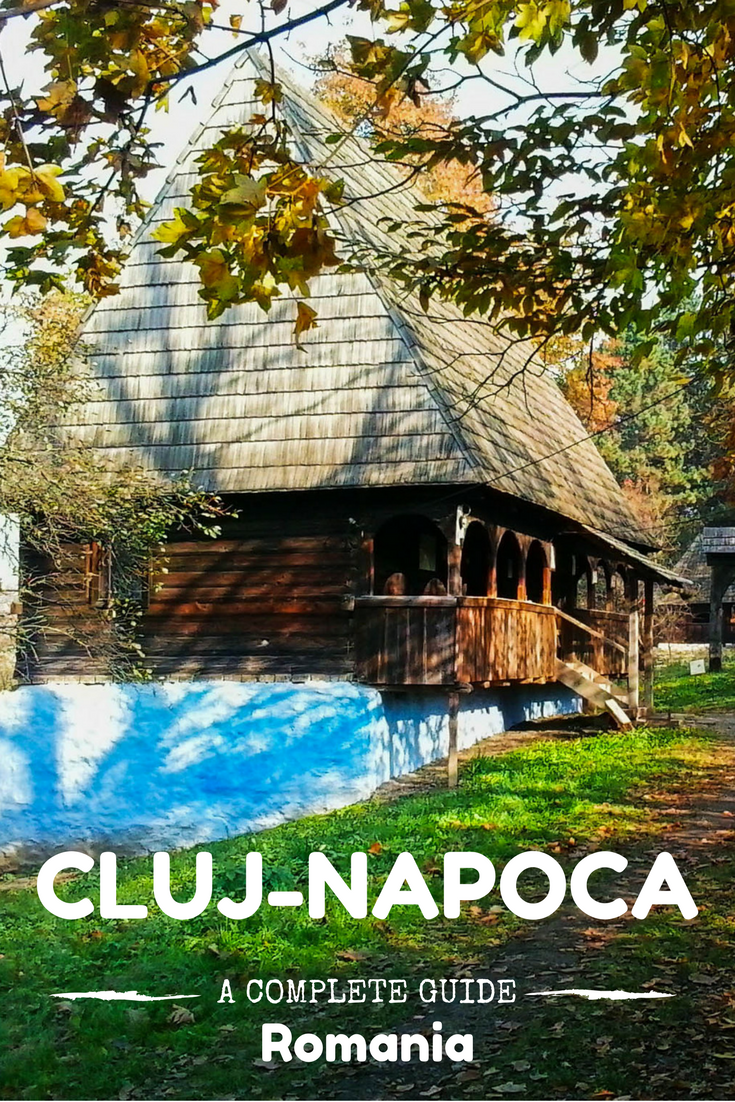
More amazing articles for you:
Related posts.
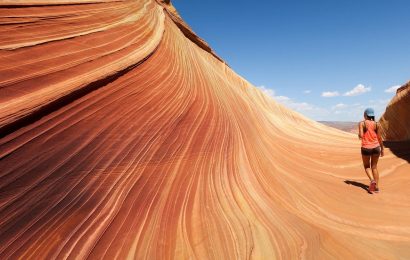
Responsible travel: 15 things you should never do while travelling abroad
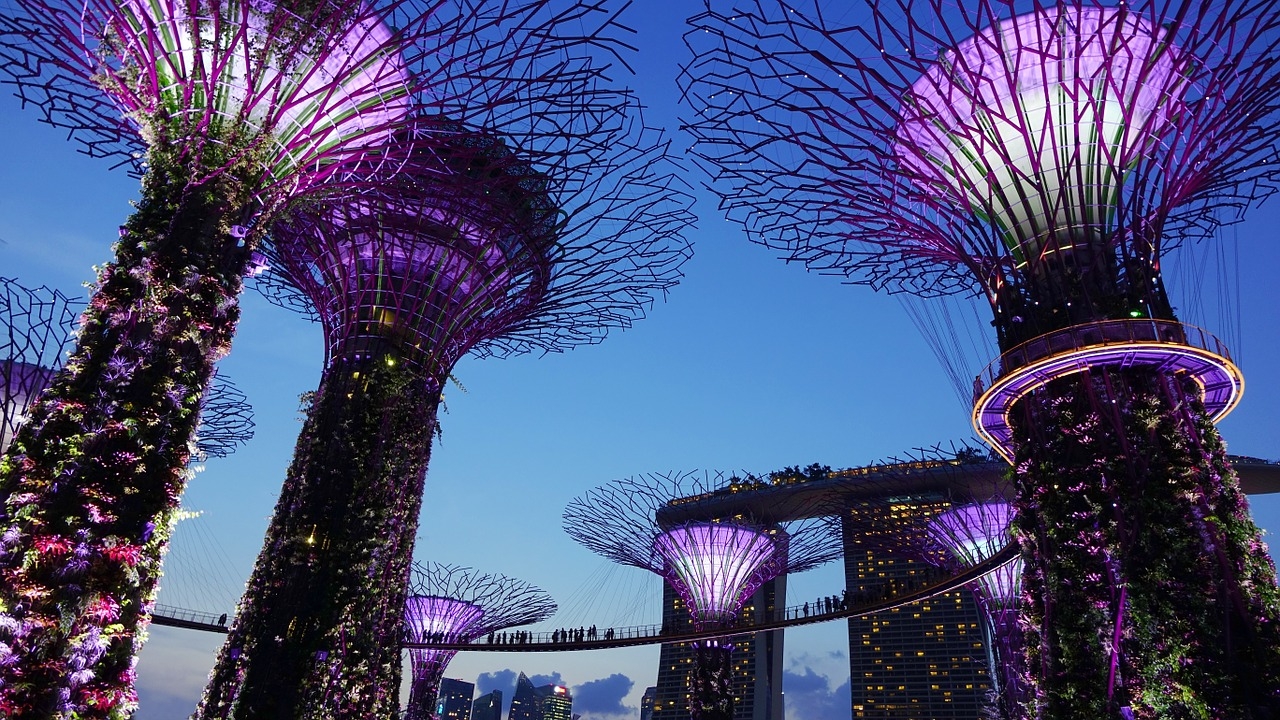
Insider’s guide to Singapore with the best attractions in Singapore
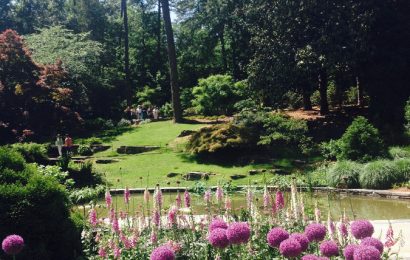
Your Complete Local’s Guide to Durham, NC by a resident with the best things to do in Durham NC, where to eat and stay
2 thoughts on “ a complete travel guide to cluj-napoca, romania ”.
Thanks for this lovely, useful post! Cluj is on my bucket list for as long as I can remember, but, somehow, I’ve never managed to get there.
This blog is fantastic. I really enjoyed the pictures and the suggestions of place to visit and dine while in the Cluj/Napoca area. I am now convinced that I must come visit Romania. What a beautiful country. Thank you!
Leave a Reply Cancel reply
Your email address will not be published. Required fields are marked *
Save my name, email, and website in this browser for the next time I comment.
Currently you have JavaScript disabled. In order to post comments, please make sure JavaScript and Cookies are enabled, and reload the page. Click here for instructions on how to enable JavaScript in your browser.

- Two Castles in One Day Tour – 12 hours
- Bucharest City Tour by Night – 1.5 hours
- Bucharest City Tour & Wine Tasting – 2.5 hours
- Bucharest Evening Tour & Traditional Dinner – 3 hours
- Unhealthy Food Tour of Bucharest – 4 hours
- Half-Day Tour of Bucharest – 4 hours
- The Last Days of Communism Tour – 4 hours
- Mogosoaia Palace & Snagov Monastery Tour – 5 hours
- Wines of Wallachia Tasting Tour – 8 hours
- One Day Tour from Bucharest to Constanta (the ancient city of Tomis) – 10 hours
- The Real Dracula Tour – 11 hours
- Experience Bulgaria Tour – 11 hours
- Transylvania Break Tour – 2 days
- Danube Delta Tour – 2 days
- Transfagarasan & Medieval City of Sibiu Tour – 2 days
- Medieval Transylvania Tour – 3 days
- Private Half-Day City Tour of Bucharest – 5 hours
- Private Full-Day Sightseeing Tour of Bucharest – 8 hours
- Slanic Salt Mine & Wine Tasting Tour – 8 hours
- Peles Royal Castle & Wine Tasting Tour – 9 hours
- In the Footsteps of Dracula Tour – 11 hours
- Private Trip to Peles Castle & Bran Dracula Castle – 12 hours
- One Day Tour to Bulgaria – 11 hours
- The Black Sea & Danube Delta Tour – 2 days
- Medieval City of Brasov Tour (Kronstadt) – 2 days
- Medieval City of Sibiu Tour (Hermannstadt) – 2 days
- Bucovina & Transylvania Tour – 3 days
- Romanian UNESCO Heritage Tour – 4 days
- Magic Transylvania Tour – 4 days
- Transylvanian Medieval Castles & Fortified Churches Tour – 4 days
- Maramures, Bucovina & Danube Delta Tour – 5 days
- Transylvania – 12 tours
- Bucharest – 9 tours
- Muntenia Wallachia – 8 tours
- Danube Delta – 3 tours
- Bucovina – 3 tours
- Bulgaria – 2 tours
- Maramures – 1 tour
- Tour Search
10 Best attractions in Cluj Napoca That You Shouldn’t Miss
The 10 best attractions in Cluj Napoca ? If you are the explorer that we know you are, and you happen to want to check out the fairyland that is Transylvania, a pit stop in Cluj Napoca is a definite must. Home to some of Europe’s most famous festivals, be it music or film, Cluj Napoca is a vivid place, one that will fill you up with good energy.
We have put together the 10 best attractions in Cluj Napoca . Either if you want to see the tourist attractions in Cluj Napoca , or want to see it as a local, you are in for a treat. Here are the best places in Cluj Napoca .
Explore the 10 best attractions in Cluj Napoca
What you should know, before anything else when you decide to visit Cluj Napoca (often called Cluj) you should know that, like most cities in Europe, Cluj Napoca is a combination of historical landmarks, modern architecture, and future like hotspots.
So, to be honest, deciding to name 10 best attractions in Cluj Napoca was not an easy task, but we managed to narrow it down to the following:
1. Union Square – Saint Michael’s Church and the Statue
Situated in the center of Cluj Napoca, Union Square is one of those meeting points, everyone knows where it is! Why is it one of the best attractions in Cluj Napoca? Well, it’s rather great to grab a pretzel and a coffee, and lay in the sunshine.
Union Square is home to open-air events in Cluj Napoca, such as the well-known TIFF Festival . Saint Michael’s Church is one of the most visited tourist attractions in Cluj Napoca , and it’s situated in Union Square. It now serves as a catholic church hosting multiple gatherings throughout the week.
Saint Michael’s Church is over 600 years old, impressive by size, architecture, and inside details, and one of the top tourist attractions in Transylvania .
Right by Saint Michael’s church, you can see the impressive statue of horseback Matthias Corvinus, a famous Hungarian king of the 15th century. Going to Cluj Napoca’s Union Square makes to cut off your list three of the best attractions in Cluj Napoca .
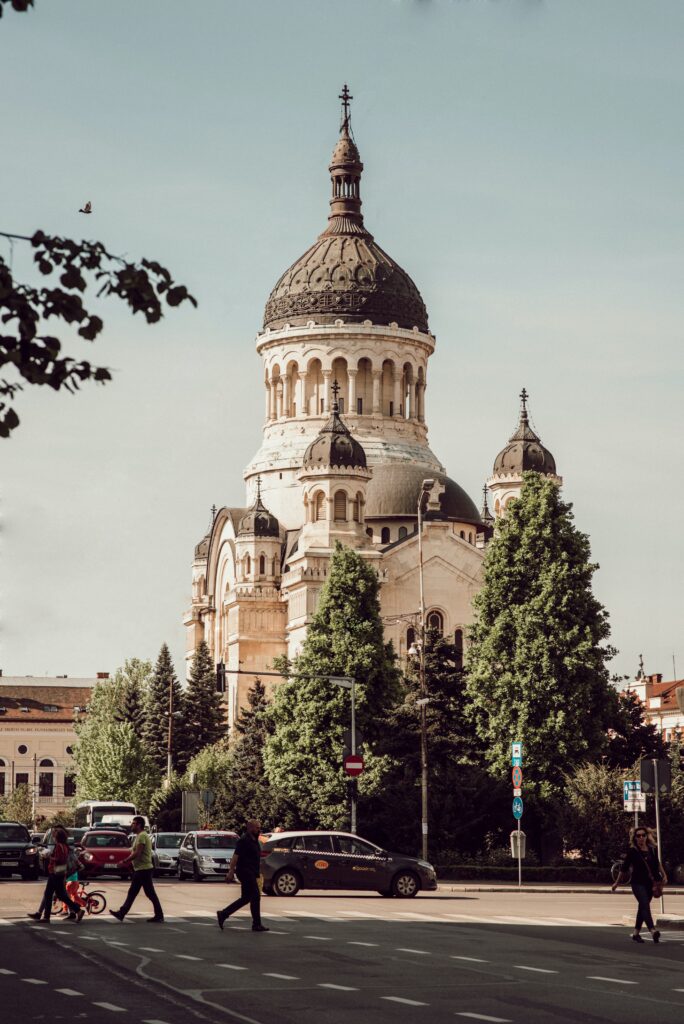
2. Museum Square
This top attraction in Cluj Napoca is a favorite of ours, for good reasons. But let us starts with the beginning, shall we? The Museum Square, located in the center of the city, is one of the oldest markets in the city. It gets its name after the Transylvania History Museum located within the square.
Although it is not a huge area, it is one of the top attractions in Cluj Napoca because of the density of historical landmarks and buildings. Also, plenty of restaurants and cafes- the perfect place to spend a day. Have we mentioned it’s 100% pedestrian? It is loved equally by locals and tourists as it is a top tourist attraction in Cluj Napoca .
Within the square you will find the Franciscan monastery church building- is one of the oldest buildings of the city. Read more about it here .

Here are a few amazing restaurants that you should check out when in Museum Square:
1. Charlie Pub & Restaurant
- Address: No.3 Museum Square, Cluj Napoca
- Contact: +40 741 055 821
- Email: charliepub.ro
Marty Restaurants Muzeului
- Address: No.2 Museum Square, Cluj Napoca
- Contact: +40 736 368 791
Muura Steak House
- Address: No.2 Franklin Delano Roosevelt Street, Cluj-Napoca
- Contact: +40 733 051 562
3. Avram Iancu Square
Avram Iancu Square is situated in the western part of the old city walls and it was initially a market. It is one of the best attractions in Cluj Napoca because of the rich history of the place, and the special meaning that it has today.
The square is guarded by three bastions and gates. At the end of the 19th century, the walls and gates were demolished, and a small park was arranged in the square.
Today, some of the top tourist attractions in Cluj Napoca are located in the Avram Iancu Square area: National Theater , the Orthodox Cathedral, the office of the Cluj Prefecture, or The Palace of Justice.

4. Botanical Garden
Are you a fan of the wonder that is Mother Nature? Brace yourself for an absolute must on our best attraction of Cluj Napoca list.
The Botanical Garden is located in the south of Cluj Napoca. It covers an area of 14 hectares, and it is home to over 10000 species from all around the world. So yes, you can easily spend an entire day in this top attraction in Cluj Napoca .
Inside the garden, there is a Botanical Museu m- over 635 000 species of plants can be examined and admired here. Besides the museum and the garden itself, you will find glasshouses, which ensure a proper environment for exotic plants. Interesting fact : it is believed that smokers cough a lot when they enter the glasshouses.
- Opening hours: 15 May-15 Sept, from 9.00-20.00; glasshouses: 9.00-18.00
- Opening hours: 16 Sept-14 May, from 9.00-17.00; glasshouses: 9.00-16.00
- Contact: +40-264-592-152
- Email: [email protected]

5. Cetățuia Hill and Park
Cetățuia Hill is definitely one the most popular attraction in Cluj Napoca. And it’s not just because of the view, which is, by the way, an absolute delight for the eyes and soul during sunset. The perfect view over the city center, an out-of-the-box way to admire the city’s architecture.
But this is not the only reason why Cetățuia Hill is one of the best attractions in Cluj Napoca . This is the place where a majestic fortress was built by the Habsburgs . You can still see some of the old gates of the fortress. Even if you are not a history fan, you would still thank yourself for coming here and escaping the noise of the city.
6. The Pharmacy History Museum
Here is a different kind of a museum- not hard to understand that it wasn’t hard to introduce it on our best attractions in Cluj Napoca list.
The Pharmacy Museum or The Pharmacy History Collection is today located in the oldest pharma building in Cluj Napoca, built-in 1573. The collection of over 1,800 pieces is a display of pharma activity in Transylvania between the 16th and 20th centuries. In order to keep the pharmacy rooms as close to the original settings as possible, the furniture inside dates back to the 17th century as well.
Such a delight for both locals and visitors. Convinced that the Museum of Pharmacy is a top tourist attraction in Cluj Napoca yet?
7. Central Park
Home to Untold Festival , to Sunday walks and brunches. Central Park is a sanctuary for locals and a top tourist attraction in Cluj Napoca. It was founded in 1827 and it’s the main green oasis in Cluj-Napoca.
Yet another great thing about Central Park is that it has a lake right in the center. If you feel like exercising, you can rent a boat.

8. Turda Salt Mine
Without any doubt, one of the best attractions in Clu j. The Salt Mine is located close to the city of Turda, which is about 30 km from Cluj Napoca.
Turda Salt Mine has a history of over 2000 years, well-preserved galleries, and a futuristic attraction deep underground. It is the largest salt mine museum in the world, and, needless to say, incredible.
We are not the only ones to say that, Business Insider ranked Turda Salt Mine as the most beautiful underground place in the world . There is no place for boredom! Amongst the things you can find there, we would like to mention: an amphitheater, an underground lake that anyone can explore with paddles, a Ferris wheel, bowling alley, table tennis, pool tables, spa treatment rooms with natural aerosols.
So if it’s considered one of the coolest places on Earth, who are we not to consider it a top tourist attraction in Cluj. We have written an entire article about Turda Salt Mine, you can read it here.
9. Hoia Baciu Forest
For the fans of the supernatural, or for those who are just curious, Hoia Baciu Forest occupies a leading position in our list of best attractions in Cluj Napoca.
Hoia Baciu Forest became famous after, legend has it, a Shepard went missing with his 200 sheep, never to return.
Later on, in 1968, the forest gained international attention after a military technician stated he saw a UFO above a part of the forest. The zig-zag shaped trees that no scientist was able to explain, the strange noises, feeling of nausea, fatigue, and failure of electronic devices is what makes Hoia Baciu Forest a top tourist attraction in Cluj.
If you decide to check it out, you should know that there are tours around the forest, and you can even camp overnight. Are you in?

10. Ethnographic Park Romulus Vuia
The ethnographic park was the first open-air museum in Romania and it was established in 1929, by the ethnologist Romulus Vuia. There were outlined 4 thematic sectors: one with regional types of farmsteads and with monuments of architecture, one with peasant workshops, a botanic sector, and a zoological sector with animals of local breed.
A perfect place to learn more about Transylvanian culture and customs, which is why we believe it’s one of the best attractions in Cluj Napoca.
You might be interested to learn more about the top things to visit in Cluj county, Transylvania .
Best places to taste traditional Transylvanian food in Cluj Napoca
Of course, you cannot make a list of the best attraction in Cluj Napoca and not include food and places to eat. A warm recommendation is to try Panemar – they are specialized in bread and pastry products.
Almost every local buy their daily bread from a Panemar kiosk. There are dozens of Panemars all around Cluj Napoca, so it would be rather hard not to find one. We heartwarmingly recommend their bread, sandwiches, and croissants. Now let us have a look at a few restaurants:
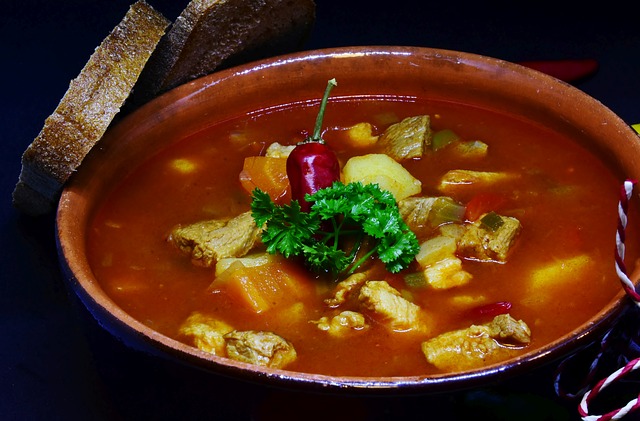
1. Rod Restaurant
- Specialty: Fish Soup (Storceag de peste)
- Address: No.160 Calea Turzii, Cluj Napoca
- Phone: 0737 732 425
2. Roata Restaurant
- Specialty: mititei and ciorba de burta
- Address: No.6 Alexandru Ciurea Street, Cluj Napoca
- Phone: 0264 592 022
3. Valachia Restaurant
- Specialty: beef belly steak
- Address: No.27 Govora Street, Cluj Napoca
- Phone: 0264 427 588
4. Varzarie Restaurant
- Specialty: varza a la Cluj (Cluj-Style cabbage)
- Address: No.37 Eroilor Blv., Cluj Napoca
- Phone: 0264 595 064
5. Zama Restaurant
- Specialty: Transylvanian potato salad/ Transylvanian omelette + elderflower beverage
- Address: No.16 Napoca street, Cluj Napoca
- Phone: 0755 080 777
All of the above-mentioned restaurants have takeaway options. Nonetheless, we highly recommend going there. All of them have traditional Transylvanian decor, for a genuine experience.
Best time to visit Cluj Napoca, Transylvania
Now, we know you want to make the most out of your trip. And let’s face it, in order to really enjoy the best attractions in Cluj Napoca , the weather has to be on your side.
Romania’s climate is temperate-continental, with four seasons- you can read an entire article about the weather in Romania here. Here is something to keep in mind when visiting Cluj Napoca, and Cluj county in general. The location is central-northern, near Apuseni mountains in the west. This means that temperatures would be a little bit lower than in the southern part of the country, for example.
So, to make the most out of the top tourist attractions in Cluj Napoca , we recommend visiting:
- March to May- spring season , if you want to take hikes, walks in the forest ( Hoia Baciu Forest or Turda Gorges , for instance)
- June to August- summer season , if you are into music festivals (such as Untold or Electric Castle ), film festivals (such as TIFF ), or open-air shows and museums.
- September to November- autumn season, if you want to focus your visit on museums, castles, and art galleries
- December to February- winter season , if you are a fan of winter sports.

Free walking tour in Cluj Napoca
To be honest, there is no better way to learn about a place than by discovering it with a local. And if you feel more comfortable not having to look up places to see in Cluj Napoca , we have some good news.
Cluj Guided Tours offers free walking tours for anyone who is interested. The team is all local, passionate, and super nice- something typical for Transylvanian people. They also have other types of tours:
- Thematic tours
Specialty coffee shops in Cluj Napoca
Specialty coffee is a rather young concept in Romania, but gaining speed fast.
Cluj Napoca was the first city in Transylvania, and 3rd in Romania to have a specialty coffee roastery. Today the number increased by a dozen, and specialty coffee shops are in high demand. Coffee is the fuel humans run on, so we had to include it on our list of best attractions in Cluj Napoca .

1. Meron Coffee
- Address: multiple locations across Cluj Napoca and Romania. This is one: No.19 Ștefan cel Mare Square, Cluj Napoca
- Contact: https://www.meron.coffee
- Origins: Brazil, Ethiopia, Panama.
2. YUME Coffee
- Address: No.21 Victor Babeș Street, Cluj Napoca
- Contact: https://yume.coffee
- Origins: Brazil, Guatemala, Rwanda, Ecuador, Columbia, El Salvador.
3. Tucano Coffee Puerto Rico
- Address: No.19 Eroilor Blv., Cluj Napoca
- Contact: https://www.tucanocoffee.com/en/
- Origins: Ethiopia, Kenya, Honduras
4. The Green Specialty Coffee
- Address: No.2 Matei Corvin Street, Cluj Napoca
- Contact: https://www.facebook.com/thegreenspecialtycoffee/
- Origins: Kenya, India, Ecuador.
Shopping in Cluj Napoca
Either we like to admit it or not, the truth is we all love shopping. It just is something about buying things when traveling, isn’t it? And not just souvenirs… everything and anything. If you agree with us, these are best attractions in Cluj Napoca when talking about shopping:
1. Iulius Mall Cluj Napoca
- Shopping: over 60, amongst which ZARA, The Body Shop, Sephora, Massimo Dutti, Guess
- Dining: over 30, amongst which Dashi Japanese, Cartofiserie, Salad Box, Chopsticks
- Entertainment: Carturesti Bookstore, Cinema City, Air Hokey, F1 Simulator
- Address: No.53B Alexandru Vaida Voievod street, Cluj Napoca
- Website: http://iuliusmall.com/cluj/?lang=en
2. Vivo Mall Cluj Napoca
- Shopping: 110, amongst which Aldo, Tom Tailor, Oysho, Pandora, H&M, LEGO, Lacoste
- Dining: over 40, amongst which Wasabi Running Bar, Pep&Pepper, Marty, Ciao Ragazzi, KFC
- Entertainment: Dino Land, Thron Games, Zoo Karting, Cinema City
- Address: No.500 Avram Iancu Street, Floresti, Cluj
- Website: https://vivo-shopping.com/en/cluj-napoca
That’s a wrap for best attractions in Cluj Napoca. In hope that you found this article useful, we really do want you to fully enjoy your trip to Cluj Napoca.
If you are interested in top things to do and see in Transylvania read more about it in this article.
Feel free to let us know if there is any additional information you might need. Contact us and we will answer as soon as we can.
Why Book With Us?
- Small-groups always
- Certificate of Excellence
- Fun & Friendly local guides
- Customer care available 24/7
- 15+ years experience
Tour Categories
Tour destinations, blog categories, proceed booking, already a member.
Username or E-mail
Forget Password?
Don't have an account? Create one.
Or continue as guest.

17 Cool and Unusual Things to Do in Cluj-Napoca, Romania!
If you’re not super-familiar with Romanian cities, you can be forgiven for not having heard about Cluj-Napoca – after all, its tourism scene is still developing. But don’t worry: it’s a thoroughly lovely, charming place in which to spend a few days, and you’ll soon fall in love with its non-touristy charms and awesome locals, not to mention its epic music festivals! Romania is an awesome country to explore – start off with 3 days in Bucharest – but you’ll soon discover that there’s plenty of things to do in Cluj too!
In fact, I had three days in Cluj, and could’ve happily stayed for longer. The capital of Transylvania is pretty, relaxed, and refreshingly free of crowds, and the local people genuinely welcome visitors. What’s not to love about that? Nothing, say I!
So, I’m going to let you in on all the top things to do in Cluj-Napoca, and inspire you to visit Romania! Think of this as your personal travel shopping list; the places that you really can’t leave Cluj without seeing.
Otherwise the vampires will get ya.

How to get to Cluj-Napoca
Cluj is a vivacious university town, and tourism is steadily growing, so you’ll find an increasing number of direct flights into Cluj-Napoca Airport from the rest of Europe. The UK, Germany, and Spain are particularly well-served, so if you’re coming from further afield, you’re probably best off transferring in one of those countries (check Momondo for the best deals).
The airport isn’t especially big (which is a great thing for all of us who get endlessly lost in massive airport terminals ), so you’ll be through passport control and baggage pickup in next to no time!
It’s also extremely easy to get to the city from Cluj Airport: those keeping to a strict budget can catch the train, which takes about twenty minutes and costs the equivalent of one US dollar. Alternatively, catch one of the taxis outside the terminal for the 10 minute drive – this should cost about 26 Romanian leu. Recommended taxi firms are NOVA, Diesel, Clima and Activ.
Alternatively, you can reach Cluj-Napoca by train, thanks to the city’s railway station, and trains which come from as far away as Vienna (the IR 143 service is direct). Get yourself a first class ticket if you fancy one of the comfy private compartments, which have ample legroom; you could even make two journeys of it, and spend a few days in Budapest , which is en route!

The best things to do in Cluj!
Okay, you’ve arrived in Cluj – isn’t it lovely? Once you’ve dropped off your bags at your chosen Cluj hotel – more on which later – it’s time to hit the town and check out some cool and unusual things to do in Cluj. Of which there are many, I assure you!
So here’s what to do in Cluj, in order to ensure a fang-tastic Transylvanian trip! Sorry, I just had to make that pun somewhere in this article. I mean c’mon .

Take in the views from Parcul Cetátuia
Whenever I travel, I always like to climb up to a vantage point – or a flippin’ big hill, at the least – and take in the sights.
Luckily, Cluj has you covered on all fronts, as it’s a flippin’ big hill with a vantage point on top, from which you can get a lovely vista of the whole city! It’s also very easy to get to – there’s a road running along the bottom of the hill, and a flight of steps takes you up a path flanked by trees, from which you can turn around and soak in the views.
That’s not all, though! There’s a few monuments to check out, as well as the rather fascinating tower which juts up from the back of the hill – it’s the property of the Romanian Aeroclub, and they use it for practicing their parachuting, of all things. If throwing yourself from a large metal structure doesn’t float your boat, you can instead relax at the hillside cafe of Pergola , and enjoy the view whilst you sip your coffee!

Admire the National Opera House
Grabbing the title of “fanciest building in Cluj” with both hands is the National Opera House, a glittering jewel in the Cluj-Napoca crown!
This lovely building, constructed in 1919 by a couple of Austrian architects who made darned sure that their baby was just as ornate as anything in Vienna, has been the on-off home of the Romanian National Opera all the way through its history. Changes in Transylvania’s political status meant that Cluj occasionally ended up being part of Hungarian territory, meaning that the Romanian opera needed to change their HQ sharpish, but it’s now fully settled in its spiritual home. The neo-baroque exterior is absolutely gorgeous, and fully matched by the interior, with everything that you’ve ever imagined an opera house to have. I’m talking columns, gold decoration and crimson red seats: the works.
If you’re suitably impressed by all this culture and want to take in a show, then you’re in luck: the building houses not only opera, but ballet and the occasional spot of Shakespeare too! Have a look at the Romanian National Opera’s website for more details!

People-watch in Piata Unirii Square
Piata Unirii Square is one of the nicest places in Cluj, and certainly the best for putting your feet up and watching the town’s residents go about their business!
The piazza – proof that the local town planners learnt well from their former occupiers from the Roman Empire – is an open space at the side of St. Michael’s Church, and it’s a perfect sun-trap. I spent a very nice afternoon just sitting at one of the outside cafe tables, and watching the locals go by, whether they were walking their dogs, or browsing the market stalls. It’s also something of a public performance area; there was a stage set up on the weekends hosting a traditional Romanian dance group – perfect for watching as the sun goes down.
Piata Unirii Square has a selection of cafes on one side – as well as one of the few souvenir kiosks in town – and my favourite was Toulouse . The prices were reasonable, and the food excellent – check out the very generous, and very tasty, pasta dishes!

Visit St. Michael’s Church and the statue of Matthias Corvinus
Get two bits of awesomeness for the price of one, by pairing up the splendor of St. Michael’s Church with the statue of Cluj’s most famous former resident! (unless you count the Cheeky Girls .)
St. Michael’s Church is the second-biggest church in Transylvania, outdone by the magnificently-named Black Church of Brasov, and was completed in 1487. It’s a gloriously Gothic church, with the sharp angular looks of the exterior paired with a gorgeous vaulted ceiling and intricate wood carvings on the inside. It’s also slap-bang in the city centre, and very much the heart of the city, both spiritually and physically. It also holds the distinction of having changed its denomination an impressive five times, due to political issues – it’s now settled firmly in Roman Catholicism!
Pop outside, and you’ll see Cluj’s most notable statue: the huge monument celebrating Matthias Corvinus, who was born in Cluj, and eventually became the king of Hungary and Croatia in 1464. If you’ve visited Budapest, you’ll undoubtedly have seen the beautiful Matthias Church, where he got married. This monument is no less impressive!

Check out the stunning Dormition of the Theotokos Cathedral
Located just opposite the National Opera House, this cathedral is yet another hidden Romanian gem!
Making your way past the fountain in front (with its flock of pigeons who seem determined to perch on the fountain’s jets), and pausing to check out the statues of broody-looking figures, you’ll enter the cathedral and be greeted by a beautifully-decorated Orthodox church. The frescoes on the walls really are something: they stretch all the way up, representing the celestial beings watching over you, and they give the interior a really solemn, humble atmosphere. It’s well worth going in purely to stand to one side, and watch the steady stream of people offering up their prayers with obvious devotion.
The outside is just as spectacular, thanks to being inspired by the Hagia Sophia in Istanbul – you can certainly see the influence in the cathedral’s dome! Be aware that you do get the occasional beggar outside; a firm “no” (or “nu” in Romanian) should be enough if you don’t want their company.

Relax at Central Park
Cluj’s Central Park is a beauty – it might not be big, but it provides a lovely walk!
Cluj isn’t exactly a smog-filled metropolis – on the contrary, it actually has the best air quality in Europe – but Central Park is the lungs of the city. It’s a narrow strip of green, tree-filled land between the city and the main canal passing through Cluj, and it can be a wonderfully shady refuge on a hot summer’s day. It’s also the home of a lot of Cluj’s events! When I visited, I happened to take a shortcut through the park, purely because it was a quicker route back to my hotel. To my amazement, when I entered the park, I realized that it was hosting the city’s Jazz in the Park festival. There were fairy lights and hammocks stretched between the trees, live music being played on stages, stalls selling street food and drink, and an endless sea of happy residents enjoying the evening with friends and family. It was absolutely wonderful!
But even if you’re not lucky enough to see the festival, there’s still plenty going on, including a quite gorgeous fountain and the stunning tree-lined Chios Lake. And swan pedalos, because no lake in Europe is complete without swan pedalos!

Learn about Transylvanian History at Romulus Vuia Ethnographic Park
Ready to travel back in time? Well you can put that TARDIS back where you found it: you’ll genuinely feel like you’ve stepped into the pages of a storybook at the Romulus Vuia Ethnographic Park!
Located a slight way out of town (you can easily walk it down Strada Romulus Vuia, which starts near the train station, or catch a taxi), this is the star of all of Cluj’s attractions. You’ll see why as soon as you set foot over the threshold: beyond the ticket office, you’ll walk past wooden cabins which look straight out of a Robin Hood movie, whilst a stream trickles past and red squirrels scamper in the trees. It’s simply idyllic.
The park was established in 1922 by Romulus Vuia (what a name!), and is a collection of buildings and objects which have been transplanted from their original location and put in the park for safekeeping. They come from all over Transylvania, and really do reflect the buildings and lifestyle of Romania’s rural past. At time of writing, there’s 13 traditional farms, which are all decorated inside and extremely cozy – I could happily move into one – a myriad of rural buildings such as mills and workshops, and most impressively, 3 wooden churches. These are absolutely wonderful, and so ornate both inside and out (if the door is locked when you get to a building, wait a moment and one of the seemingly-omnipotent guardians will come along and unlock it with a huge key).
There’s also a few goats and donkeys wandering around, adding to the pastoral bliss. Even if you’re not remotely interested in history (hisssss), you should definitely visit the Romulus Vuia Ethnographic Park: it’s a fantastic place just to wander, and see some genuinely interesting buildings. If it’s a sunny day, it’s even more perfect!
Check out their website before you go for opening hours – the park is also generally closed on Monday and Tuesday.

Sample a Papanași
Don’t leave this sweet treat off your list of what to do in Cluj! It needs to be experienced!
Papanași are essentially Romanian doughnuts. Except that they’re doughnuts on crack; expect more calories than you’ve ever had in your life, but an absolute taste sensation! They look like round doughnuts with a small baby doughnut on top, but when you cut into them, you’ll find them absolutely packed to the rafters with sweet, gooey filling. Mine was nutella and cream (omnom!), but you get them with soft cheese, jam, sour cream, fruits, and seemingly anything the chef can get their hands on.
I also can’t emphasize enough how big these things are. They. Are. Huge! You’re definitely better off getting one to share between two of you! If you’ve completely fallen in love with them, you can find a recipe for papanași here.
I was told by my hotel owner that Restaurant Fair Play has the best papanași in Cluj, and that’s where I tried them; I can certainly vouch for this recommendation!

See a CFR Cluj game
Celtic fans, look away now.
The mighty CFR Cluj are often Romanian football champions (or soccer, if you’re in the US), and although they can’t quite compare to European giants such as Barcelona or Juventus, they’re certainly capable of pulling off a shock. In the 2019 Champion’s League qualifiers, they were drawn against Celtic – the biggest and most successful team in Scotland. Everyone expected Celtic to win the tie. It should’ve been no contest. Everyone assumed that Celtic were practically through already.
Guess what happened? Spoiler: watch this if you want to see some very happy Romanians.
So if you want to take part in the local passion, how about going and sitting with the locals at a CFR Cluj game? Their stadium is almost in the city center on Strada Romulus Vuia, and you can buy tickets for CFR Cluj games through their website. For anyone who’s used to paying through the nose for games in other European leagues, you’ll be delighted to see that tickets cost the equivalent of €10 – that’s an utter bargain!

Take some walking tours
More than anything, Cluj is just a lovely place to take a stroll. Its famously clean air and attractive buildings mean that you can easily while away a few hours just ambling around, and taking in the sights. But what if you want to go a bit deeper?
Unsurprisingly, Cluj has an interesting history – after all, it’s the capital of Transylvania, and in a position that the city has had to change nationality various times. So it’s easy to go around and spot a historical monument here and a pretty building there, but it can be difficult to interpret what it all means. Cluj isn’t fully geared up for tourists, so it’s not like you’re going to find a vast information board outside of these places.
The best way to walk around Cluj, and really appreciate what you’re seeing, is to take a walking tour. The local guides really know their stuff, and are happy to guide you around the city and give you a full explanation of what you’re seeing – it avoids that shallow, “I don’t really understand what I’m seeing” feeling, which can be so frustrating for travelers.
Cluj walking tours are a great way to see the city, and learn more about the people and the place you’re staying in!

Take a walk to the Tailor’s Bastion and the Greco-Catholic Cathedral
Slightly to the southeast of the Old Town is the Tailor’s Bastion. It’s a scenic old structure, and well worth the short walk!
Back in ye olde medieval times, the walls of castles weren’t only guarded by soldiers. Local guilds of craftsmen would also take up their tools or weapons and guard the city, as they were equally keen as anyone else to protect their families and livelihoods. So stretches of city wall were assigned to particular guilds; that was the case for Fisherman’s Bastion in Budapest , and so it goes for the Tailor’s Bastion in Cluj. I’ll leave it to you to imagine tailors guarding the walls with very large needles and some natty armor.
These days, it’s something of a community center: it holds an exhibition detailing the history of the tailors guild, a cafe, and occasionally hosts local events. Pop in and say hello!
Whilst you’re there, you can also have a look at the Graco-Catholic Cathedral which is under construction on the other side of the main road. It’s been under construction for many years and isn’t the most photogenic building in town – it’s certainly proving to be controversial with the locals. It’ll probably be quite impressive if it ever gets finished, because it’s already ginormous!

Visit the home of a medieval king
Remember our good friend Matthias Corvinus, he of the impressive statue outside St. Michael’s Church? He of the illustrious royal career over in neighboring Hungary?
Well, he’s a local boy done good, as Matthias Corvinus was actually born in Cluj. And you can go and visit his house!
If you’re standing right outside the entrance to St. Michael’s Church, turn right, and you’ll spot a small pedestrian street on the other side of the road. It’s a particularly lovely one, with hundreds of light bulbs strung above you: go straight down here, and you’ll see a white and brown building straight in front of you. This is the Matthias Corvinus birthplace, and it’s now owned by the local Art and Design University.
So you may not be able to go in, but take a look around you – what a lovely square, right? This whole area is one of Cluj’s loveliest spots: in summer there’s plenty of outside dining in front of the cafes, and in winter the trees are strung with lights, while Christmas markets take place below them.
If you want to see somewhere else with a connection to Matthias Corvinus’ family, check out a day trip to the stunning Corvin Castle . This storybook castle was supposedly where Vlad the Impaler was held prisoner, and was featured in Halloween specials for both Ghost Adventures and Most Haunted . You’ve been warned…

Take a day trip to the Turda Salt Mine
Never mind the best things to do in Cluj Napoca – the Turda Salt Mine is one of the best things to do in Romania!
You really owe it to yourself to go on a day trip to the Turda Salt Mine . Once you’ve stopped giggling at the name (yeah okay, I bought a postcard from the mine because of the name. Sue me), you’ll soon realize that this is one of the most extraordinary places you’ll ever visit in your life. It’s genuinely one of the world’s hidden gems.
You’ll descend into the mine, which has been on this site since antiquity, down a long and rather chilly tunnel. After a few more descents down salt-encrusted staircases, you’ll emerge into the Rudolf mine – and it is insane. Stalactites of salt hang from the ceiling above a vast, vast underground chamber… which contains a Ferris wheel, ping pong tables, ten pin bowling, pool tables, a basketball court, and an underground lake which you can rent pedalos on. And a gift shop, because we might as well throw that in there too. It is one of the most amazing places I’ve ever visited, and you NEED to see it. If you don’t see anything else on this list, if you ignore my tips completely, just make sure you do this one thing and see Turda Salina. It’s stunning!
If you’re looking for other day trips from Cluj, check out Alba Iulia with its gorgeous citadel (which can also be done on a tour which includes both Alba Iulia and Turda Salt Mine ). Alternatively, you can take in both the Turda Salt Mine and the beautiful Apuseni Mountains .

Explore the haunted Hoia Baciu Forest
Imagine, if you will, that I’m turning out the lights and turning on a torch. Because it’s time for a spooky story…
In the countryside, beyond the city limits of Cluj, there lies a forest. Nestled between in a valley between two rivers, overshadowed by the mountains, the forest is dark and brooding, waiting for unsuspecting tourists to fall into its trap. For it is said that the forest is haunted by the restless ghosts of sinners, and that the area is a beacon for supernatural beings. A UFO was photographed right above it in 1968, and it is one of the most notorious areas of paranormal activity in Europe. Even the vegetation is strange, as if manipulated by some otherworldly force. A visit here is a must-do… but will you survive it?!
Okay, enough drama. But it’s all correct: Hoia Baciu Forest really is supposed to be both haunted, and an area touched by paranormal activity. You can even take a tour exploring Hoia Forest at night , with supernatural activity sensors – it makes for a perfect Halloween trip to Transylvania!
If the creepy isn’t your thing, then there’s plenty of things to do in the daytime, from scenic walks to archery and biking. Double it up with a trip to the Ethnographic Museum!

Explore nature, and confuse your friends, at the Botanical Garden
Here’s a fun game to play with your friends. Tell them you’re visiting Cluj, Romania, then send them a photo of yourself in Japan. Then another one of you in a sub-tropical mangrove swamp.
Confused? Not as much as they will be!
The answer is actually pretty simple: you can do all of this mischief-making by visiting the Botanical Garden in Cluj. These gorgeous gardens cover 14 hectares, and like to arrange their displays thematically. So their eastern examples are grouped together in a convincing Japanese Garden, whilst their tropical plants are located in a vast greenhouse, including a large pool full of huge lily pads. They genuinely look like something straight from the Amazon!
The rest of the gardens are equally impressive: there’s a soothing stream and waterfall, a garden filled entirely with cacti, and even a Roman garden which features coffins from Cluj’s former stint as the Roman city of Napoca. It’s just a lovely place to go and take a walk around – I know next to nothing about flowers, but I thoroughly enjoyed it!

Get artistic at Bánffy Palace Museum of Art
For not very much money (as with everything in Cluj; prices are cheap across the board), you can gain access to Cluj’s renowned Bánffy Palace Museum of Art!
The building used to be the home of the Governor of Cluj, and it’s a grand old pile – take a moment to stand opposite the museum, and drink in the statues of various ancient Greek deities, as well as the Bánffy family emblems. It was turned into an art museum in 1951 (the family who resided there presumably getting the option to leave), and it’s remained so ever since.
You probably won’t be conversant with many of the works held inside unless you’re particularly up on your Romanian and Hungarian artists, but does it really matter when it comes to art? It matters less whether you’ve heard of the artist, and more if you like the art they produce, and you’re bound to find something you’ll fall in love with here. Plus, how often do you get to walk around a Baroque palace? Not every day, that’s for sure!
Check out the museum’s website here , though be advised that there isn’t much in English.

Do some retail therapy and souvenir shopping at the market
Congratulations! You’ve seen Cluj’s highlights! Though you can never do more than scratch the surface of a town in a few days, you’ve navigated this quirky Romanian city and undoubtedly fall in love with it.
So it’s time to do some shopping! Head back to the Piata Unirii Square, and you’ll find a market with a wondrous variety of stalls, many selling traditional dress. These make excellent Cluj souvenirs – my boyfriend bought a traditional Romanian embroidered shirt, and wears it to work! If you’re not sure that you can pull off the style, there’s also stalls selling cute rag dolls wearing traditional dress so that you don’t have to.
Wondering what else to buy in Cluj? There’s plenty of food produce to choose from, from huge loaves of bread to jams and preserves. You can also get yourself some lángos, a fried treat which is a traditional food in Budapest , but which has continued its popularity over the border in Transylvania. You can get them either savory or sweet, but my personal favorite is to have one with cheese on top – heaven!
And that’s it! Retire to a pavement cafe of your choice, and watch the sun go down over the square. Your time in Cluj has been well-spent!
Cluj Events
Cluj-Napoca is rapidly becoming increasingly known for the quality of its music festivals! These are bringing both artists and visitors from across the world – indeed, when I was staying in Cluj, all the locals assumed that I was there for the jazz festival (which I wasn’t, but I still enjoyed it regardless!).
Fancy mixing some music with your mici ? Here’s the rundown of Cluj’s top festivals!
Jazz in the Park – See my entry on Central Park above for my experience, but Jazz in the Park is an undoubtedly lovely event. It might not get the attention of the other festivals, but it gets acts from around the world, and is a lovely excuse to spend the evening in the park. Grab a hammock and some street food, listen to the jazz, and make some new Romanian friends!
Electric Castle – featuring everything from rock to indie to hip-hop, this is where the big international names are to be found. Previous headliners include Fatboy Slim, Sigur Ros and Florence + The Machine. Usually takes place in July, at Bánffy Castle near Cluj – the ticket proceeds go towards the restoration of the castle. Rightly regarded as one of the top festivals in Europe.
UNTOLD – veering more towards dance music, this has also won a host of European Music Festival awards. Usually taking place in the huge Cluj Arena in August, its central location means that you can stay in accommodation in Cluj rather than having to camp out. If you’re not attending the festival, don’t worry – practically every house in Cluj can hear the music!

Where to eat in Cluj
Cluj has a wide-ranging variety of places to eat – you certainly won’t lack for options! The city offers everything from traditional Romanian food to burgers and sushi, and it’s all of a very high standard. The good news is that thanks to a generous exchange rate, none of them will break the bank.
Here’s my list of favorites!
Toulouse – This cafe on Piata Unirii Square is perfect for people-watching, sipping a beer or a coffee, and eating massive bowls of pasta. Does very tasty sharing platters. The inside is also nicely decorated, should it be a rainy day.
Fair Play – serving the best papanași in Cluj! Looks distinctly no-frills when you enter, and service isn’t super-speedy, but the food is worth the wait. Everything is cooked fresh, so it takes a little longer – be patient. Worth the slight walk out of town.
Roata – recommended to me by my lovely hotel owner as the best Romanian food in town – and she was absolutely right. It’s incredibly popular with locals, so advance bookings are wise. Servings are absolutely huge – my boyfriend and I had a traditional serving platter full of barbecued meat, and we really struggled to get through it due to volume. We wished we could though, because it was all delicious! Slightly hidden down a side street, but sitting outside on a sunny evening, under a terrace with grape vines growing up it, will be a highlight of your trip!
Ursus Brewery – a brewpub, as you might’ve guessed by the name, but one that sells delicious food! Ursus beer is a local, legendary beer, and you can’t go wrong by accompanying it with one of the pub’s meals. The chicken schnitzel with sweet potato fries might not be traditional, but I can give it a personal recommendation!
Farmer’s Market – self catering? Doing Cluj on a budget? Get fresh produce from the farmer’s market on Strada Arges – there’s also a Carrefour supermarket just around the corner, if you can’t find what you’re looking for!
Where to stay in Cluj
Your hotel budget can go a long way in Romania! You can either go budget and get an absolute steal, or look at the luxury hotels which might be out of your reach somewhere else. Either way, Romanian hospitality is incredibly warm and welcoming, and you’re bound to feel right at home.
Budget hotels in Cluj
Garden city apartment.
Want to stay a little further out of town, and save a bundle of money while you’re at it? The Garden City Apartment is quite ridiculously cheap, and you get a lovely, residential apartment in return. This place will charm your socks off, with a quiet garden for relaxing in, and a fresh feel indoors. It’s a perfect choice for backpackers and long-term travelers thanks to a fully-equipped kitchen with a washing machine (great for refreshing those smelly socks stuffed down the bottom of your pack). The host, Ildiko, is absolutely lovely!
Apartment Vintige
If being away from the city center doesn’t appeal, and you’d rather be right in the thick of things, check out the Apartment Vintige – you couldn’t be any closer to the heart of Cluj! St. Michael’s Church, and all the cafes surrounding it, are a mere five minutes walk – and if even that sounds like too long, how about a free bike to ride there? The apartment itself is beautifully decorated and cozy-feeling, and you’ve got the benefit of a full-size fridge and oven!
Mid-range hotels in Cluj
Villa-hotel escala.
Simply put, one of the best, and most feel-at-home places I’ve ever stayed in. The owners welcome you like you’re personal friends, and they’ll have a chat with you about your day when you return after exploring (as well as provide you with some really useful information – it’s like having your own personal travel agent / tourist information officer!). Rooms are large, comfortable, and air-conditioned. There’s a quiet garden with a pool for you to relax in, and it’s really peaceful thanks to being located in a residential area. There’s also a cemetery opposite, so you’re ensured quiet neighbors! (though this is Transylvania…)
Sungarden Golf & Spa Resort
Not too worried about being in the city center? Prefer being out in the countryside, being pampered like a celebrity? Then this is the place for you! Not only do you have an outdoor pool, a sauna, a relaxation room and Turkish bath, but you also get a 9-hole golf course and outdoor bars for relaxing in the sunshine. You get a huge bed, all of the luxury trappings, and your own private terrace. So how much is this setting you back per night? Less than €100 for a premium Queen room – at that price, it would be silly not to.
Luxury hotels in Cluj
Luxury nook.
I love this apartment’s name, because it describes it perfectly! Just do yourself a favor, and click the link – see that tasteful decoration? See that huge apartment, right in the city center, that you can have all to yourself? See that gorgeous bathtub and quality fabrics everywhere? Of course, you can’t see the air-conditioning (a must in summer) and the high-speed wifi, but you can imagine it! This is the luxury city apartment you always dreamed of – and thanks to the exchange rate, it’s extremely affordable!
Hotel Platinia
How about some true luxury? If you’re looking for a five star hotel in Cluj, then look no further than the Hotel Platinia! Located a stone’s throw from the Ursus Brewery – literally – the hotel is also close to Central Park and the Cluj Arena, making it a perfect choice! Rooms come fully equipped with free wifi, the finest hardwood floors and comfiest fabrics, a huge bed, and walk-in showers. Not to mention your own dressing room, and a sofa and television for relaxing and cocktail-sipping. But again, like everywhere else in Cluj, it really isn’t that expensive! If you want that five star luxury, and want to stay in the best hotel in Romania, this is your chance!

Cluj nightlife
You might think that because Cluj isn’t an international hotspot (yet) that there isn’t a nightlife scene. You may even think that Cluj nightlife refers only to the vampires.
Well, you’d be wrong! Cluj is a rapidly-growing university town, and it has a strong student scene. This has led to a number of bars springing up to serve them, and one street in particular has taken up the baton in order to fufill those poor thirsty students.
So if you’re looking for Cluj nightlife, get yourself to Strada Piezisa! This street, located just west of the old town, is perfect for all your nightly needs. Whether you’re on a Cluj stag do, or if you’re just keen to go out in Cluj and experience the local scene, this is the must-visit – it’s a street which is comprised of nothing but bars. Yup!
Whether it’s trendy Coyote , or the well-regarded Booha , you can have an epic night out here!
Share this guide to Cluj-Napoca!
I hope this guide to Cluj has been useful – it’s a town close to my heart! If you’re still deciding whether to visit or not, do it – you really won’t regret it!
If this has indeed helped you, how about returning the favour and sharing it using the buttons below? Or you can go one better, and save the below image to Pinterest – that way, you’ll have this list of things to do in Cluj with you when you need it!

By the way! This article may contain affiliate links. These incur zero extra cost to you, but give me a few pennies towards the running of this site. Any extra cash which isn’t spent on my site is spent trying to recreate papanasi at home!
Share this:
- Click to share on Twitter (Opens in new window)
- Click to share on Facebook (Opens in new window)
You Might Also Like...

First steps

2 Days In Amsterdam – Travel Tales

Small Travels: Southend-on-Sea
Wonderful, well-documented post about Cluj and the region. Thank you for sharing this valuable information with us all.
thatanxioustraveller
Hi Cezarina; thank you for your very kind words! I absolutely loved Romania – definitely heading back sometime to explore the rest of the country! 🙂
Mulțumesc! 😊❤️
Leave a Reply Cancel Reply
Save my name, email, and website in this browser for the next time I comment.
Notify me of follow-up comments by email.
Notify me of new posts by email.

3 Days In Budapest: The Ultimate Budapest Itinerary!

Italy Quotes: 87 Quotes About Italy to Inspire Your Trip!
Made with in Seattle.
(C) Copyright 2019 - Solo Pine. All Rights Reserved. Designed & Developed by Solo Pine .

- Bucharest tours
- Day trips from Bucharest
- Transylvania tours
- Romania tours
- Romania and Bulgaria tours
- Self-guided tours
- Virtual tours in Romania
- Tailor-made tours
- Corporate events & business travel
- DMC in Romania
- Reviews from our clients
- How do I pay?
- Romania Travel Blog
8 Best places to visit in Cluj Napoca – Travel guide
- November 2, 2023
A holiday to Transylvania could be incomplete if you don’t visit Cluj-Napoca. Even if you stay briefly in the largest city in Transylvania, you may want to know what are the best places to visit in Cluj Napoca.
How to get to Cluj Napoca:
Cluj Napoca airport is not a big one, but it has several international flights. If you are lucky, you can find one directly from your city. The other option to get to Cluj Napoca by plane is to land in Bucharest, the capital of Romania, and book a flight from there. You will find daily flights to take you here.
Usually, international travellers land in Bucharest and come by car from there to Cluj Napoca. It is a long ride, but you can stop on the way and visit other places in Transylvania until you arrive in Cluj Napoca. Another option is to come from Budapest, Hungary.
Once you arrive in Cluj Napoca, you will find here a modern, youthful city, with a bohemian vibe and certain arrogance. Locals know that prices are higher than in Bucharest, the restaurants more varied, and wages similar. It has a Western European feel with its imposing cathedrals and its cobblestone streets, more than once reminding of Vienna.
If you spend one day in Cluj or several, here is a list of attractions and places to see in Cluj Napoca:
Best attractions to visit in Cluj Napoca:
Saint michael’s church.

Saint Michael’s Church is erected in the Union Square of Cluj Napoca and has gothic architecture. Its construction began in 1316 on the site of an old cemetery and was completed in 1487, being built in two stages. The current clock tower, the tallest church tower in Romania, was supposed to have a twin structure, but the second tower was never built.
This edifice has been used by many religious communities, but nowadays it’s Catholic. The church organ is the original one from 1753, but it has been restored numerous times. The baptism of Matei Corvin was celebrated here.
Even on a short visit to Cluj, it’s difficult to miss the most symbolic cathedral of the city. It’s not only imposing due to its size but also thanks to the large square that highlights it. The statue that guards it against one side represents Matei Corvin and his four generals.
If you go inside the Saint Michael’s Cathedral, its cool and dark interior will take you by surprise, especially during hot, summer days.
Read also: Visit Transylvania – Travel guide for first time visitors
Thing to see in Cluj Napoca: Matei Corvin’s House
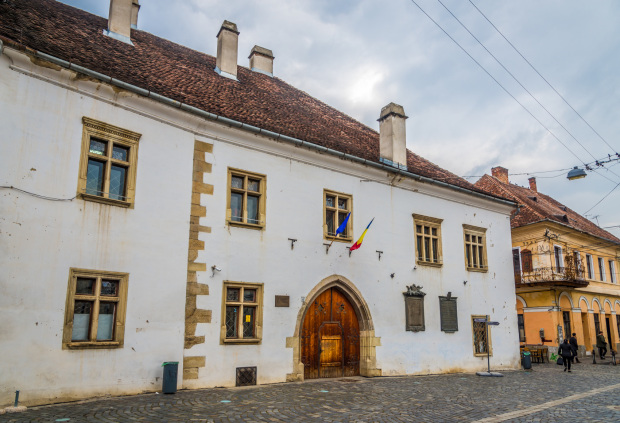
One of the best-known tourist attractions in Cluj and also the oldest, since people coming here, would want to visit it from as early as the 18 th century; the Matia House is known to be the birthplace of Matei Corvin or Matthias in Hungarian. Matthias Corvinus, also called Matthias I was King of Hungary and Croatia from 1458 to 1490.
From Central Square, as you go towards Museum Square, it’s impossible to miss it: a large, white building, with an immense, old gate, and with a commemorative plaque at its entrance.
Over the years, it has been used as an inn, a hospital, a prison, and a school. Nowadays, it belongs to the Art and Design University and although it’s so well known, it is not open to the public with the exception of the main hallway that can be visited.
Museum Square with the Franciscan Church

The most bohemian place in the city, the Museum Square of Cluj Napoca is full of various terraces, with colourful décor. Covered in cobblestones, Museum Square is the oldest square in the city, also known as Small Square (Piata Mica). Its name comes from the Museum of Transylvania which can be found on one side of it.
The Franciscan Church is located across from the museum. Built-in the 13 th century, the church is one of the oldest in the city. Its interior is bright and intensely coloured, but unfortunately, as you enter you will see the signs of time over it.
The Carolina Obelisk stands in the middle of the square and is dedicated to Empress Carolina Augusta who visited Cluj in 1817 and made considerable donations to the city. You cannot visit Cluj Napoca and not walk through Museum Square. You will enjoy here the relaxed atmosphere and a sense of youthfulness.
Visit Cluj Napoca: the Mirror Street
From Central Square, going towards Avram Iancu Square, you will walk along a famous street in Cluj, Iuliu Maniu Street, also known as “Mirror Street”. Its name comes from a few twin buildings erected on either side of the street as if they were in a mirror.
If you don’t pay attention to the details, it’s easy to walk by without noticing the similarity of the buildings, but the best place to view them from is Central Square at one end of Iuliu Maniu Street.
Instagrammable places in Cluj Napoca: The Central Park of Cluj and the Casino

Another important attraction to see in Cluj-Napoca is Simion Barnutiu Central Park. You will be attracted here by the tranquillity of the park, the lake with its pavilion or the white casino building.
The park’s history goes back more than 180 years and for a long time, the lake was used for ice skating, even having a skating pavilion built on the island (now the Chiosc restaurant). Nowadays you can enjoy a tour of the lake by rowboat or paddleboat.
The Central park of Cluj is the place that hosts every day the most important festival in Cluj: Untold.
The casino built at the end of the 19 th century was badly degraded. It was renovated with European funds and was reopened to the public a few years ago, now a centre for events and cultural activities.
Cluj Napoca sightseeing: the Elisabeth Bridge
Not having any real reason to go to this part of town, you can find the Elisabeth Bridge only by accident. During a stroll through the central park, go to check the water of the Somes River. Crossing the river you will find a secret gem in Cluj Napoca: the Elisabeth Bridge.
You will see the hundreds of locks hanging from the bridge’s rails, knowing the emotions felt as each lock would have been placed there with trembling hands which then would have proceeded to throw the key into the river below, swearing eternal love.
The Elisabeth Bridge in Cluj is the oldest functioning bridge over the Somes River and is named after Princess Sissi of Austria. It has become a spot for romantic rendezvous with the help of the city hall, which in 2011 put up hearts at each end of the bridge for lovers to hang their locks on.
This type of bridge of locks that tied couples’ hearts together can be found in other European cities, and the tradition had made its way here, so for lovers, this spot is definitely a must-see in Cluj.
Avram Iancu Square and the Orthodox Cathedral

Another imposing square in the busy city is Avram Iancu Square, known as the home of the Orthodox Cathedral, built-in 1920 after the unification of Transylvania with Romania.
Avram Iancu Square got its name in ’93, having previously been named after a Soviet marshal, a prince of Transylvania, Cuza Voda, and even after Hilter during the Second World War.
If you make it here you will see the statue of Avram Iancu and the fountain in the centre. The scene is nicer after dusk.
Hidden gems in Cluj Napoca – the Mill Canal

Another place to visit in Cluj is Andrei Saguna Street. A little bit of Venice, a little bit of old-time Bucharest, a little bit of modern Cluj, Andrei Saguna Street has it all! The Mill Canal, with its bridges that take you directly into the surrounding buildings, will remind you of Venice.
The cobblestones and the old signboards of some stores seem to be brought here from interwar Bucharest. But you will also find a few places that will bring you back to reality and show you where you really are: modern Cluj.
A coffee shop, a second-hand store, and even a sex shop are squeezed in between the older stores.
Read also the list of interesting cities in Transylvania
Does Cluj Napoca seem interesting to you? Check our tours that reach the city:
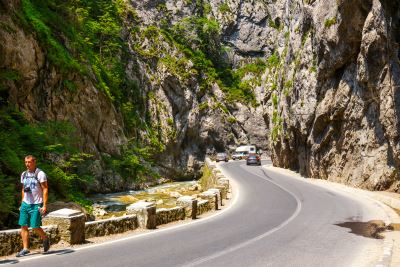
10 days in Romania itinerary

2 weeks in Romania Unesco tour

9 days in Romania – Bucovina & Maramures tour
9 days in romania - tour of bucovina & maramures.

Haunted Romania in 4 days
Cetatuia park of cluj napoca.

And if you would like to see Cluj Napoca from above, you must go to Cetatuia Park (Citadel Park). Its name comes from the old fortification that was built here in the 18 th century with the role of protecting the city after Transylvania came under Austrian rule. There are only a few ruins left from the old fortress, but Belvedere Hotel was built on this hill, along with a Cross erected to honour the martyrs of the 1848 revolution.
You can admire the view during the day, but the best one is by night when the sight will leave you speechless.
The Botanical Garden of Cluj

The best time of the year to visit the Botanical Garden of Cluj is during Spring so you can see the Japanese Garden with its red pavilions and cherry blossoms. The greenhouses are lush year-round.
If you spend more than a day in the city, there are other things to do in Cluj Napoca. A multitude of museums, restaurants, and other attractions will make you enjoy your time here.
For art lovers there is the Paintbrush Factory (Fabrica de pensule), a space for contemporary art that hosts art exhibits, artists’ workshops, and various cultural events. This centre was established in a former paintbrush factory, hence its name.
For those who want to discover Romanian traditions, Cluj Napoca has Romulus Vuia Park to offer, the first outdoor museum ever to be opened in Romania. The park is a museum of the Romanian village and showcases households from various areas of Transylvania.
Hoia Baciu haunted forest
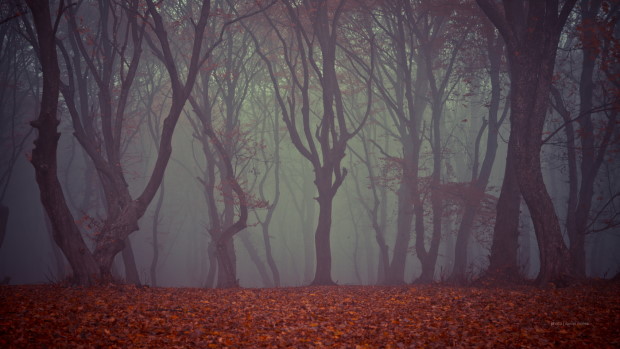
Meanwhile, for lovers of the paranormal, Cluj hides the Hoia Baciu haunted forest. Found on all international lists of the most haunted places, the Hoia Baciu forest is recognized as a place where all sorts of paranormal activities take place: ghosts, weird apparitions, trees in unusual shapes, and otherworldly occurrences have all been reported here. If you want to experience this, just go and visit the forest. You don’t need to wait for the evening!
Is Cluj Napoca worth visiting?
Being the most modern city in Romania (read also what are the most beautiful cities in Romania), Cluj Napoca is definitely a place worth visiting.
Reasons to travel to Cluj Napoca would be its museums and interesting attractions to see, but also the natural places and some unusual ones that will make you remember your trip here. Also, if you are a gourmand, you can find in Cluj Napoca some of the best restaurants in Romania.
There are also nice places to visit near Cluj Napoca, like Bontida castle .
I don’t think one day in Cluj Napoca is enough to get to know it well because it is a fascinating city! If you just want to check the main attractions in Cluj Napoca off your list, a day is enough. But don’t forget that you are in Transylvania and here, life happens at a slower pace, and Cluj is laid-back, so take your time. After all, what’s the hurry?
You may like
Username or email address *
Password *
Lost your password? Remember me
No account yet?
Privacy Overview
- Special Offers

City of Cluj - Napoca (Cluj), Transylvania
Main cities.
- Cluj - Napoca
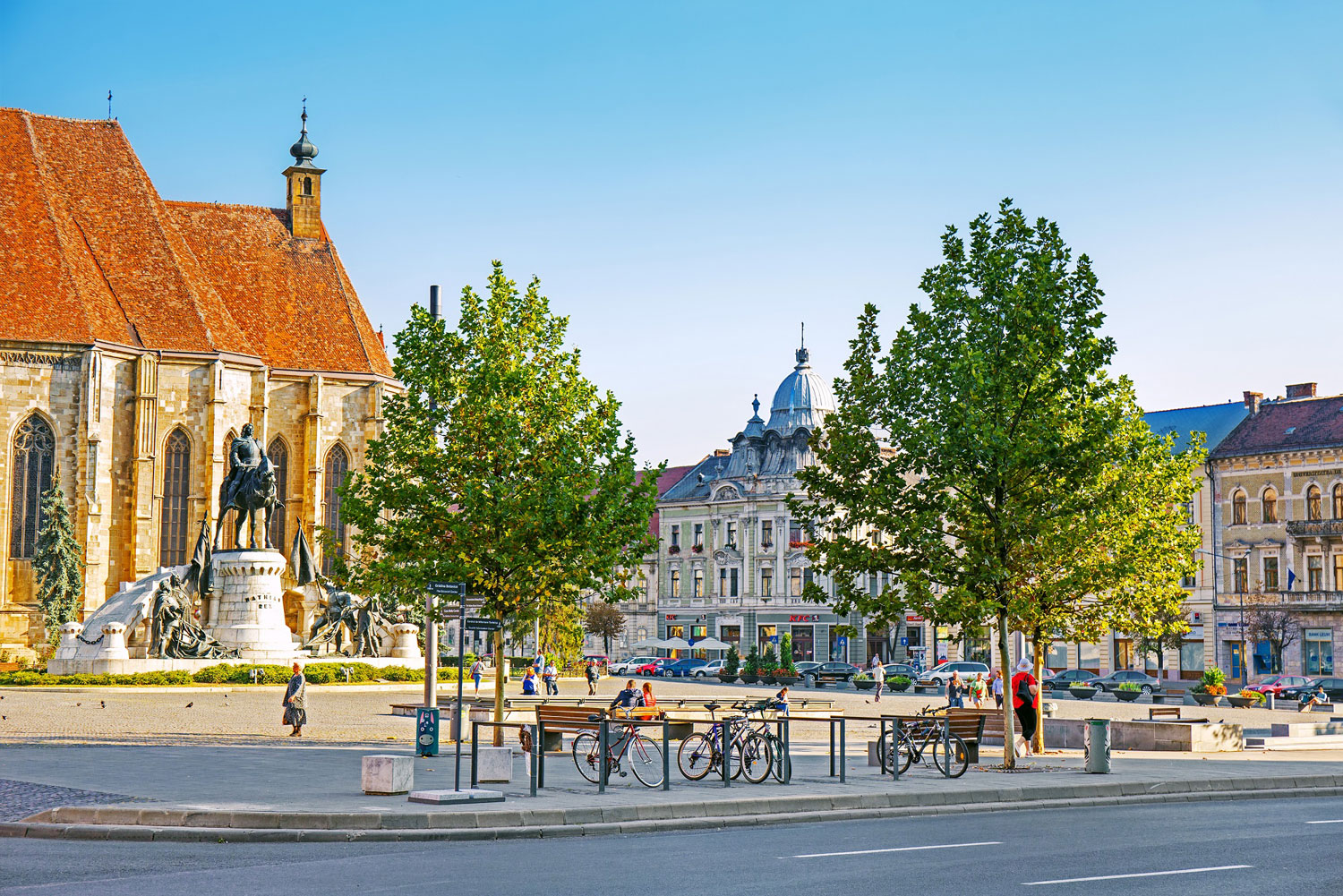
CITY OF CLUJ NAPOCA Fast Facts Sights and Landmarks Museums Performing Arts Attractions Near Cluj - Napoca Day Trips
TRIP PLANNING INFO Cluj Napoca Transportation Places to Stay Shopping Tourist info / Local Authorities Maps
Cluj Fast Facts
Location: Transylvania, Central Romania Area: 69.3 sq. miles (179.5 sq. km) Elevation: 1,181 ft. (360 meters) Population: 380,000 (metropolitan area) Inhabited since: 200 BC First documented: 1173 AD ( Clus )
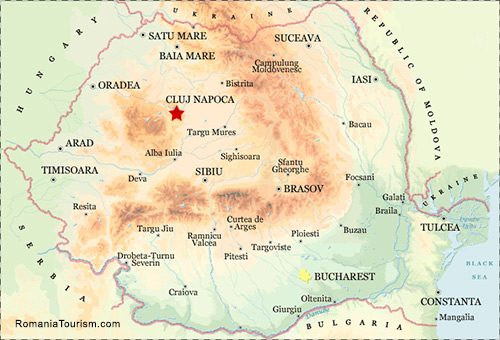
Cluj Napoca Info
Cluj - Napoca, the largest city in the region of Transylvania, traces its origins back to a Dacian settlement (called Napuca ) in the 2-nd century A.D. After the Roman take-over of Dacia, Napuca became a Roman fort "Napoca" and in 124 A.D., received the rank of "municipium". The city quickly advanced socially and economically and during Marcus Aurelius' reign Napoca received the title "colonia", the highest possible urban status in the Roman Empire. The name Cluj comes from Castrum Clus , first used in the 12-th century as the name of the citadel surrounding the city. Clus means "closed" in Latin and refers to the hills that surround the city. Known as Klausenburg to the Germans* and Kolosvar to the Hungarians, Cluj became Cluj Napoca in the 1970s, when the old Roman name of the city was added to emphasize its Dacian-Roman origin.
Cluj is a vibrant cultural and education centre with a dynamic economy. The city has the highest ratio of students to total number of residents, in Romania, due to its seven state and three private universities.
Cluj Napoca main square: Piata Unirii (Union Square), resplendent with 18th and 19th century buildings, is dominated by the 15th century St. Michael's Church, one of the finest examples of gothic architecture in Romania, and the 18-th century baroque Banffy Palace - home of the Romanian art collections of Cluj Art Museum and of the weaponry museum. Many shops and restaurants are located in or near Piata Unirii .
Cluj - Napoca is one of the seven walled citadels (Siebenbürgen*) , founded, in the Middle-Ages, and populated, until late 1960s, by the Transylvanian Saxons. The other Siebenbürgen citadels are Bistrita (Bistritz), Brasov (Kronstadt), Medias (Mediasch), Sebes (Mühlbach), Sibiu (Hermannstadt), Sighisoara (Schässburg). The ancestors of the modern Transylvanian Saxons (people of German ethnicity who have settled in Transylvania from the mid-12th century until mid-19th century) originally came from the contemporary Low Countries (more specifically the regions of Flanders, Hainaut, Brabant, Liège, or Zeeland) as well as the Moselle and Lorraine river valleys, and, very importantly, Luxembourg as well, then situated in the north-western territories of the Holy Roman Empire around the 1140s (Wikipedia).
Cluj Sights and Landmarks
Piata Unirii The St. Michael's Church dominates the Union Square, an area surrounded by Baroque, Gothic, Renaissance and NeoClassical buildings, among which the Banffy Palace - arguably Romania's most representative Transylvanian-Baroque structure. Flanking the church on the south side is a 1902 equestrian statue of the 15-th century ruler, Matei Corvin. In the southwest corner of the square stands Hotel Continental, built in 1895 in an eclectic style combining Renaissance, classical and baroque elements. During World War II, the hotel served as the German military headquarters in Transylvania. On the other side of the square is the Hintz House, former home of Cluj's first and longest-running pharmacy (1573-1949), now Pharmacy Museum of Cluj-Napoca
Biserica Sfantul Mihail Address: Piata Unirii St. Michael's Church is one of the most beautiful gothic monuments in Transylvania. It was erected between 1350 and 1487 on the site of the former St. Jacob's Chapel. The oldest part of the church is the altar, built around 1390, while the newest is the bell-tower, neo-gothic style (1860). The star-shaped vault, the stained-glass windows and the sculptures impress with their beauty and grandeur. Recent restorations revealed early 15th century murals.
Palatul Banffy Address: Strada Iuliu Maniu 30 An imposing former residence of the Austro-Hungarian governors, Banffy Palace was designed by the German architect, Johann Eberhard Blaumann, for then-governor of the city, Banffy Gyorgy. Built between 1774 and 1775, Banffy Palace is considered the most representative example of Transylvanian-Baroque. In 1951, the palace became the home of the Cluj National Art Museum .
Biserica Reformata Address: Str. Mihail Kogalniceanu 16 The building of this impressive church began in 1486 and was completed around 1516, with a pulpit added in 1646. The church, one of the largest in southeastern Europe, is a perfect illustration of the late gothic architectural style. Created in 1373 by the masters Martin and George of Cluj, the statue of St. George slaying the dragon, which stands in front of the church, was inspired by one of the world's most famous equestrian sculptures, a 14-th century statue displayed in centre of Prague. Organ concerts are frequently held in the church.
Biserica Sf. Petru si Pavel Address: Blvd. 21 Decembrie 1989, nr. 85 Named for the apostles Peter and Paul, this gothic church was built in 1711, on the foundation of a 14th-century church, and rebuilt between 1844 and 1848. An imposing portal, above church's entrance was built after the Black Death struck the town (1738-1742): statue of Saint Archangel Michael flanked on the left by John the Baptist, Saint Sebastian and Saint Charles Borromei, and on the right by Saint John the Evangelist, Saint Rocus and Saint John Nepomuc. The portal was moved here in 1899 from its former location at St. Michael's Church. A beautiful baroque work , the statue of St. Mary, by sculptor Schenbauer Antal, created in 1744 can be admired in the church's backyard.
Bastionul Croitorilor Address: Piata Baba Novac Dating from 1475, Tailors' Bastion is one of the two structures, once part of the old fortified town, still standing. The other defending tower that has survived for more than five centuries is the Firemen's Tower.
Dealul Cetatuia For the best views of the city and the surrounding landscape, climb some 200 feet up Fortress Hill. The name refers to an Austrian fortress built here in the 18-th century to ensure control, rather than defense, of the city. The fortress also served occasionally as a prison, and it was here that Stephan Ludwig Roth, the 1848 hero of the Transylvanian Saxons, was held, accused of high treason and executed at the northern gate on May 11, 1849.
Manastirea si Biserica Franciscana Address: Str. Victor Deleu 4 Open: daily 7 a.m. - 7 p.m. Free admission One of the city's oldest structures, the Franciscan Monastery was built in the 15-th century on the site of an older church dating from 1273 and handed to the Dominican order by ruler Iancu de Hunedoara in 1455. Located at the south of the monastery complex, the church was offered as a gift to the Franciscans who restored it in baroque style around the year 1728.
Catedrala Schimbarea la Fata Address: Blvd. Eroilor 10
In 1764, the church was bought by Franciscan monks living on the outskirts of Cluj. Its tower practically crumbled 15 years later, thus destroying the whole frontispiece. Restoration work began in 1783 and the church was rebuilt in baroque style. In 1924, it was donated to the Romanian Greek-Catholic Church.
Biserica Romano-Catolica Calvaria Address: Str. Manasturului 60 A powerful Benedictine abbey stood once at the western gates of the city, in the oldest quarter of the town. The abbey was known under the name Monasterium Beaae Mariae de Clus and it enjoyed outstanding rights and privileges. Benedictine monks settled in towards the end of the 11-th century. During the Tartar invasion of 1241, the abbey was pillaged and burned down. The building was restored in 1263 and the current monastery of Calvaria was built between 1470 and 1508 in gothic style. Over the years, the monastery enjoyed periods of prosperity, but also underwent times of decay. In 1787, after the war against the Turks, Bishop Alexandru Rudnai decided to have both the church and the surrounding fortifications pulled down; only the altar was spared and it was later turned into a chapel. Nothing was left of the artistic assets of the church, except for a statue of the Virgin Mary holding the infant Jesus; the statue currently stands on a pedestal, under a gothic baldachin, above the entrance door. The chapel, dating to 1831, and the belfry, designed in 1922 by the renowned Hungarian architect Karoly Koos are noteworthy.
Cluj-Napoca, the ‘capital’ of Transylvania, has a large student population and an arty vibe with excellent clubs and some of Europe’s best-loved electronic music festivals ( The Guardian - UK ).
Jewish Cluj-Napoca
Sinagoga Noua Address: Str. Horea 21 The original grand Moorish-style synagogue, better known as the Memorial Temple of the Deportees, was designed by architect Hegner Izidor and inaugurated on September 4th, 1887. 40-years later the synagogue was damaged by nationalistic Fascist organization "the Iron Guard" and, restored soon after with funding provided by the Romanian government. In 1940 northern Transylvania was occupied by Hungary and the synagogue was transformed in a storage facility. In 1942 the synagogue was damaged again following the bombing of Cluj. It was repaired three years later and completely restored in 1951.
Cluj Museums
Muzeul National de Arta Cluj Address: Piața Unirii 30 Tel: (+4) 0264 596.952 Open: Wed. - Sun.: 10 a.m. – 5 p.m. Admission charge MACluj.ro
Housed in the most representative Transylvania baroque buildings: the Banffy Palace, Cluj Art Museum displays sculptures, graphics, weapons, furniture, carpets, and paintings by Romanian artists such as Nicolae Grigorescu (1838-1907), Theodor Aman (1831-1891) and Theodor Pallady (1871-1956). Both Grigorescu and Aman were influenced by the Barbizon group and the Impressionists, while Pallady spent many years in Paris and drew inspiration from Matisse.
Institutul de Speologie Emil Racoviță Address: Strada Sextil Pușcariu 8 Tel: (+4) 0264 430.601 E-mail www.ISerCluj.com Museum is currently closed for renovations.
Cluj Speleology Museum displays a fascinating collection of over 50,000 species of subterranean fauna as well as botanical and zoological samples from areas beyond the Antarctic Circle. Most items in the museum have been gathered by Romanian biologist Emil Racoviță (1868-1947), from the over 1,400 caves he explored, in Europe and Africa, and from the Arctic. Emil Racoviță is the world's first biologist to study the arctic life, the author of an original theory of biological evolution and founder of world's first Speleology Institute (1920). He is considered, together with French entomologist René Jeannel, one of the founders of biospeleology.
Muzeul Etnografic al Transilvaniei Address: Strada Memorandumului 21 Tel: (+4) 0264 592.344 E-mail www.Muzeul-Etnografic.ro Open: Wed. - Sun. 10 a.m. – 6 p.m. Admission charge
Endowed with a collection of more than 65,000 ethnographic items, the museum offers an excellent introduction to Transylvanian folk art and traditions. Founded in 1922, it is one of the most important ethnographic museums in Romania. Its various sections, devoted to trades, lodging, food, pottery, textiles, national costumes and customs, include more than 50,000 photographs as well as open-air and international sections. Together, they paint an image of Transylvania's folk culture.
Muzeul National de Istorie al Transilvaniei Address: Strada Constantin Daicoviciu 2 Tel: (+4) 0264 595.677 Open: Tue. – Sun.: 11 a.m. – 6 p.m. (10 a.m – 5 p.m. during winter time) Admission charge www.mnit.ro
Founded in 1859, this museum illustrates the history of Transylvania from Paleolithic times to the present. The number of items on display has grown from about 24,000 in late 1870s to more than 400,000 today, including many rare and extremely valuable objects that illustrate the progress from the Neolithic and Bronze Ages to the peak of the Dacian civilization, the first century A.D. The medieval modern, contemporary history and Numismatic sections contain collections of unique decorative art, ancient books, old printings, memoirs, history and coins.
Muzeul de Istorie a Comunitatii Evreiesti - Muzeon Address: Strada Virgil Fulicea 3 Tel: (+4) 0364 100.472 Open: Tue. – Sun.: 10 a.m. – 6 p.m. Admission charge Muzeon.ro An innovative storytelling exhibition about Jewish history in Cluj
Colectia de Istorie a Farmaciei - Casa Hintz Address: Piața Unirii 28 Tel: (+4) 0264 597.567 Curently closed for renovations Admission charge Cluj Pharmacy Museum, exhibits over 2,300 pharmacy instruments and equipment. It is located in Casa Hintz the building in which Cluj's first pharmacy was open, in 1573.
Performing Arts
Cluj National Opera Opera Nationala Romana Cluj Napoca Address: Piata Stefan cel Mare 24 Tel: (+4) 0264 597.129 Aida by Giuseppe Verdi was performed at the opening night of the Cluj National Opera, in 1919.
Hungarian Theatre & Opera Teatrul si Opera Maghiare din Cluj Address: Str. Emil Isac 26-28 Tel: (+4) 0264 593.463
Cluj Philharmonic Filarmonica de Stat Transilvania Address: Piata Lucian Blaga 1 - 3 Tel: (+4) 0264 430.060 Cluj Philharmonic Concert Hall is home to five music ensembles: Cluj Symphony Orchestra, Cluj Choir, Chamber Orchestra, Transilvan Quartet and the Folk Music Orchestra. Performances are also offered in the old concert hall located at Str. Mihail Kogalniceanu 1
National Theatre Teatrul National Lucian Blaga Address: Piata Stefan cel Mare 24 Tel: (+4) 0264 592.976
Puck Puppet Theatre Teatrul de Marionete Address: Str. I.C. Bratianu 23 Tel: (+4) 0264 595.992
Visit Transylvania's largest city – Cluj Napoca – vith a local guide. When: every day, rain or shine, at 11 a.m. and 6 p.m., reservation required. Tour starts: at Piata Unirii , in front of Matthias Corvinus statue. Tour ends: at Piata Unirii Duration: two hours. Cost: Free (you can tip your tour guide if you liked the tour). More info
Parks and Gardens
Alexandru Borza Botanical Garden Gradina Botanica Alexadru Borza Address: Strada Republicii 42 Tel: (+4) 0264 592.152 Website Admission charge Cluj-Napoca Botanical Garden, one of the largest of its kind in southeastern Europe, is hometo some 10,000 plant species. Within the grounds, you can visit a museum; several greenhouses with desert and tropical plants, including huge Amazonian water lilies; a Japanese garden with a brook and a Japanese-style house, and the Roman Garden with archeological relics from the Roman colony of Napoca.
Location: 0.3 miles north of Cluj City Centre Hire a boat to row on the small lake or just enjoy a stroll in this 200-year old park.
Address: Str. Taietura Turcului Open: Wed. - Sun. 10 a.m. - 6 p.m. (April through September). Wed. - Sun. 9 a.m. - 4 p.m. (October through March). Admission charge www.Muzeul-Etnografic.ro Founded in 1929, the park exhibits some 90 Romanian, Saxon and Szekler traditional houses, sawmills, wells, potter's workshops, sheepfolds and outbuildings for grinding gold-bearing ores, sheep rearing, blacksmithing and tanning hides. The park also contains several 18th century wooden churches from the Transylvania region.
Attractions near Cluj - Napoca
Where: 5 miles west of Cluj Napoca city centre Access: car, bus, pedestrian Hoia - Baciu is a forested area ideal for nature walks and relaxation. Alleged varied paranormal phenomena occur frequently in the woods. Hoia Baciu Haunted Woods tours and more info .
Castelul Bánffy and Colectia Etnografica Zoltán Kallós Where: village Răscruci, Strada Principala 484 16 miles northeast of Cluj Napoca Access: car, bus
Salina Turda Where: 24 miles southeast of Cluj Napoca Access: car, bus, train Turda Salt Mine more info "La Salina" Wine Cellar info
Where: Village Sic - 25 miles northeast of Cluj Napoca Access: car, bus A unique village known for the beautiful traditional costumes worn by the locals, the colorful Tuesday Market, the Dance House / Museum and the nearby Sic marsh walk paths.
Where: 60 miles southeast of Cluj Napoca Access: car, bus, train Târgu Mureș more info
Where: 65 miles northeast of Cluj Napoca Access: car, bus, train Bistrița more info
Parcul National Apuseni & Ghetarul Scarisoara Where: 45 miles southwest of Cluj Napoca Access: car Cluj makes a great base for exploring the stunning Apuseni mountain range, located southwest of the city. The Apuseni Nature Park protects one of the most interesting cave systems in the country. Limestone underlies most of the park and is responsible for the area's impressive landforms and more then 400 caves, many of which can be explored. Sculptured mountain ridges, mysterious underground rivers and delicate cave formations will keep your camera busy. Rent a car in Cluj and take the scenic drive to Campeni. Explore Scarisoara Cave, a national monument and home to the second largest underground glacier in Europe. The Apuseni Motzi villages are ideal places to find the tranquility and timeless wisdom of traditional village life, vibrantly alive and intact here as perhaps, nowhere else in Europe.
Trip Planning Info
Transportation, air transportation to/ from cluj napoca.
Cluj Napoca International Airport (CLJ) Address: Str. Traian Vuia 149 Tel: (+4) 0264 416.702 AirportCluj.ro Cluj airport is located 6 miles east of the city centre.
Electric, Express Bus A1E links Cluj Airport with the city centre (Piata Mihai Viteazul). Fare ($1.50) - on board using a credit/debit card. A1E bus timetable
Visitors who need to travel from Cluj airport to the train station can take trolley-bus # 5 (route: Aeroport Nord -- Piata Garii Sud)
Taxis are another quick option to get from the airport to the city centre. (approximate fare: the equivalent of $8)
Airlines with service to Cluj Napoca include: Tarom, Air Connect, Austrian Airlines, Lufthansa, Hi Sky, WizzAir
Reaching Cluj Napoca by Car
Fastest routes from Bucharest to Cluj Napoca are: Bucharest - Pitesti - Ramnicu Valcea - Sibiu - Alba Iulia - Turda - Cluj (Highway A1 and National Road E81) and Bucharest - Brasov - Sighisoara - Targu Mures - Cluj (National Road E60
Train Travel to/ from Cluj Napoca
Cluj Napoca - main train station Gara Cluj Napoca Address: Str. Garii 1-3 Tel: (+4) 0264 592.952 or 952 There are daily direct trains from/to Cluj to most major cities in Romania as well as from/ to Budapest (Hungary). Direct trains run to Cluj from Bucharest in 8.5 hours, Brasov in 6.5, Sighisoara in 3.5. From Oradea the journey takes 2.5 hours, from Suceava 6.5 and from Timisoara 6 hours. To check train schedules and fares for domestic routes please visit RomaniaTourism domestic transportation section. For departures from/to Timisoara please select Timisoara Nord. For departures from/to Bucharest please select Bucuresti Nord.
Cluj can be reached in 8 hours by train from Budapest (Hungary) and in 11.5 from Vienna (Austria). For the list of international trains with service to/from Romania please visit RomaniaTourism.com International Transportation section.
SNCFR's advance booking office Agentia de Voiaj SNCFR Cluj-Napoca Address: Piata Mihai Viteazu 20 Tel: (+4) 0264 432.001 (domestic travel) Tel: (+4) 0264 534.009 (international travel) Open: Mon. - Fri.: 8 a.m. to 8 p.m.
Cluj Napoca SNCFR ticket office offers train information and tickets for future travel. Tickets for same-day travel can only be purchased at the train station.
Bus Travel to/ from Cluj Napoca
Cluj Napoca Bus Station # 1 Autogara Cluj Napoca Address: Str. Giordano Bruno 3-5 Tel: (+4) 0264 435.278
Daily domestic bus service from/to: Alba Iulia, Arad, Baia Mare, Bistrita, Brasov, Bucuresti, Campeni, Horezu, Hunedoara, Iasi, Oradea, Mangalia, Piatra Neamt, Reghin, Satu Mare, Sebes, Sibiu, Sighetu Marmatiei, Targu Lapus, Targu Mures, Vatra Dornei
Cluj Napoca Public Transportation
Cluj Napoca's main areas and tourist attractions are connected by numerous bus (autobuz) , tram ( tramvai ) and trolleybus ( troilebuz ) routes. The city's public transportation system is safe and reliable. All Cluj public transportation routes are operated on regular schedule Mon. through Fri., from 5 a.m. to 11 p.m. and, on limited schedule during the night, weekend and public holidays
Tickets are inexpensive (the equivalent of $0.75 / trip) and are valid for bus, tram or trolleybus. For information about Cluj Napoca public transport, including routes, schedules and fares, please visit the Website of Cluj Transportation Authority ( Compania de Transport Public Cluj Napoca )
Cluj Napoca Taxi
Cluj napoca car rental.
Nanorent Your car delivered to your door Tel: (+4) 0743 285.053 E-mail NanoRent.ro
Pont Rent a Car Tel: (+4) 0771 992.655 E-mail Rent a Car Cluj
Discount Rent A Car Tel: (+4) 0745 165.858
321 Car Rental Tel: (+4) 0743 526.653
Autorent Tel: (+4) 0740 002.000
Autonom - Cluj Airport Tel: (+4) 0264 590.588
Avis Car Rental - Cluj Airport Tel: (+4) 0264 274.113
Avis Car Rental - Cluj City Centre Tel: (+4) 0734 010.023
CarUno Tel: (+4) 0722 111.900
Enterprise – Touring Rent Auto - Cluj Airport Tel: (+4) 0720 070.590
EuroCars Romania Tel: (+4) 0727 373.799
Europcar - Cluj Airport Address: Str. Traian Vuia 149 – 151 Tel: (+4) 0740 198 577
Hertz - Cluj Airport Tel: (+4) 0364 401.722
Promotor Car Rental - Cluj Airport Tel: (+4) 0743 403.403
Sixt - Cluj Airport Tel: (+4) 0264 417.740
Tim Rent-A-Car Cluj - Cluj Airport Telephone: (+4) 0745 179.555
TOP Rent a Car - Cluj Airport Tel: (+4) 0730 511.820
Cluj Napoca Hotels
Accommodations in Cluj Napoca include:
Cluj Napoca Shopping
D R Antiques SRL Piata Unirii 11/4 Telephone: (+4) 0742 994.058 DRANTIQUESCLUJ
Galeria Quadro Address: Str. Napoca 16 Tel: (+4) 0745 341.380 GaleriaQuadro.ro
Galeria Atas Address: Str. Matei Corvin 6
Unic-Art Address: Str. Iuliu Maniu 8 Tel: (+4) 0744 539.212
Cluj Art Address: Str. Iuliu Maniu 40 Tel: (+4) 0748 534.966
O Galerie de Arta Address: Str. D. D. Rosca 14A Tel: (+4) 0745 106.816 OGaleriedeArta.ro
Galeria Uniunii Artistilor Plastici Address: Str. Iuliu Maniu 2 - 4
Tourist Info
Cluj Tourist Information Centre Centrul de Informare Turistica Address: Blvd. Eroilor 6 - 8 Telephone: (+4) 0264 452.244 E-mail VisitCluj.ro Cluj Napoca Tourist Information Centre provides maps, brochures and information on accommodations, restaurants and transportation.
Pharmacies & Hospitals
General emergency phone number: 112 Ambulance (Ambulanta) , Police (Politia) and Fire Department (Pompieri)
Cluj Napoca pharmacies (farmacie) open 24 hours a day
Ecofarmacia Address: Piața Timotei Cipariu 15 Telephone: (+4) 0264 592.484
Farmacia Europa Address: Strada Bucegi 11A Telephone: (+4) 0264 421.119
Farmacia Viafarm Address: Piața Mihai Viteazu 1 Telephone: (+4) 0264 434.182
Farmacia Cynara - Mănăștur Address: Calea Florești 75 Telephone: (+4) 0264 426.272
Farmacia Remedium - Mărăști Address: Bulevardul 21 Decembrie 1989, nr. 131 Telephone: (+4) 0264 412.901
Cluj Napoca Hospitals
Emergency Clinic Hospital Spitalul Clinic Judetean de Urgenta Cluj Address: Str. Clinicilor 3 - 5 Tel: (+4) 0264 592.771
Cluj Napoca Municipal Hospital Spitalul Clinic Municipal Cluj-Napoca Address: Str. Tăbăcarilor 11 Tel: (+4) 0735 406.258
Cluj Napoca University Hospital Spitalul Universitar Cluj-Napoca Address: Str. Republicii 16-20 Tel: (+4) 0264 599.596
Cluj Napoca Military Hospital Spitalul Militar de Urgență „Dr. Constantin Papilian” Address: Str. General Traian Moșoiu 22 Tel: (+4) 0264 598.381
Cluj-Napoca - Local Authorities
Cluj County Archives Directia Judeteana Cluj a Arhivelor Nationale Address: Str. Mihail Kogălniceanu 10 Telephone: (+4) 0264 598.979 E-mail Opening Hours
Cluj City Hall Primaria Cluj - Napoca Address: Calea Moților 3 Telephone: (+4) 0264 596.030
Consumer Protection Agency Comisariatul Judeţean pentru Protecţia Consumatorilor Cluj Address: Năvodari 2 Telephone: (+4) 0264 431.367 Website
Post offices display a postal horn symbol and the word Posta.
Main Post Office Address: Str. Regele Ferdinand 33 Open: Mon. - Fri.: 8 a.m. - 7 p.m. Sat. 9 a.m. - 1 p.m.
Telephoning Cluj Napoca from Abroad International Access Code + 4 (country code) + 0264 or 0364 (area code) + six-digit telephone number .
City Map - Harta orasului Cluj-Napoca Map of Romania - Harta Romaniei
- Cluj-Napoca
- Targu Mures

Official website of the Best Destinations in Europe.

Best destinations 2024

Christmas markets

Ski Resorts

Romantic destinations

Hidden gems

Best beaches

Best landscapes

Family destinations

Best National Parks

More inspiration

City breaks

Beach destinations
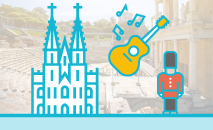
Cultural destinations

Shopping destinations

Sustainable tourism

Destinations for nature

Culinary destinations

Ski destinations

Christmas destinations
Book your flight

Compare low cost flights to Europe countries then book your airline tickets directly by clicking through to agency and airline sites.
Find your hotel

Big savings on hotels in thousands European destinations. Read hotel reviews & find the best price on hotels for all budgets.
Tours & Activities

Discover Europe’s biggest collection of things to do and guided tours. Whatever you want to do you’ll find it here. Best price guarantee !
- City Breaks
- Christmas
- Ecotourism
- Trip Finder
- Best destinations 2024
- Best beaches
- Romantic destinations
- Best hidden gems
- Best landscapes
- Best ski resorts
- Best Christmas markets
- More inspiration
- Tours & Activities

❤ Join us on :

Tourism in Cluj-Napoca
Hotels in cluj-napoca.

In the historical region of Transylvania , in a picturesque area, the city of Cluj-Napoca awaits quietly to be discovered. Cluj always got its essence through it`s people, who created a multicultural society where you’ll easily blend once you get to feel the city. Take a moment to discover and connect with Cluj-Napoca, you’ll see for yourself why it is called the Heart of Transylvania.
Cluj-Napoca has a special charm , given by the 2000 years history, the geographical location and the people, because here, time flows differently, and the people take the time to say hello to each other, to walk between the boomed trees in the Botanical Garden , to watch the reflection of the sun beams in the twin buildings on the Mirror Street, to smile and to invite you to discover the local culture and traditions.
Ancient culture and civilization center, Cluj is known from Roman times as one of the most important cities in Roman Dacia , mentioned by the geographer Ptolemaeus two millennia ago. The settlement was later raised to the rank of the municipality during Emperor Hadrian and was called Municipium Aelium Hadrianum Napoca, then to the rank of Colonia Aurelia Napoca, around the year 180, under Marcus Aurelius.
Today, Cluj-Napoca is the country’s second largest city , located in the center of Cluj County and covers an area of about 180 km2 on Someşul Mic river. Surrounded on three sides by hills with heights between 500 and 700 meters, it has the appearance of a real fortress.
Specific to the area of Transylvania, Cluj-Napoca is a multiethnic and pluriconfesional city , with a a population of 324.576 inhabitants accordind to the 2011 census. The metropolitan area has a population of 427.348 people. Another 80.000 students, as non-permanent residents, increase the population of Cluj-Napoca by coming here to study and work.
Cluj-Napoca brings together historical communities of Romanians, Hungarians, Germans, Armenians, Hebrew, Roma, as well as recent communities of Italians, French, British, Dutch, Turkish, Asians. There is an ethnic, cultural-economic and religious diversity of communities that live in peace and learn from each other.
The city earned the title of “ Capital of Transylvania ”, because of the dynamism with which it has grown to become today the most important academic, medical, business & IT, cultural, sports and scientific center in Transylvania.
Whether you want to live a fairytale, get electric, enjoy some of the best cinematography, listen to good music while wandering in the park or just want to try out some tasty food, don’t worry, we’ve got your back. Cluj-Napoca City Days, Untold Festival, Electric Castle, Jazz in the Park, Transylvania International Film Festival (TIFF), Street Food Festival are just a drop in the ocean of events this city hosts. To help this statement, you should know that Cluj was honored with the title of European Capital of Youth in 2015. This city is effervescent, let’s put it that way!
Best hotel deals
In cluj-napoca.

The Square Hotel ★★★★
The town square is 400 m away
This hotel has an excellent location score of 10

Hotel Platinia ★★★★★
The town square is 2 km away
Private parking at the hotel

Guest House 1568 ★★★
The town square is 500 m away
This property has an excellent location score of 9.8
- Cluj-Napoca
image gallery

Top things to do
The historical centre.
The city centre is the main cultural, financial, administrative and commercial area of Cluj-Napoca . It is structured on three major squares forming a triangle, Union Square, Mihai Viteazul Square and Avram Iancu Square where today is the Orthodox Cathedral and the Romanian Opera and Theatre.
Also, the Museum Square is the starting point of the fortifications of the city, and here we find the Matia Corvin House where the King of the Austro-Hungarian Empire was born, the Obelisk Carolina and the Franciscan Church. The city centre is individualized with the rest of the city through a series of architectural and historical monuments, buildings from the 17th-20th centuries.
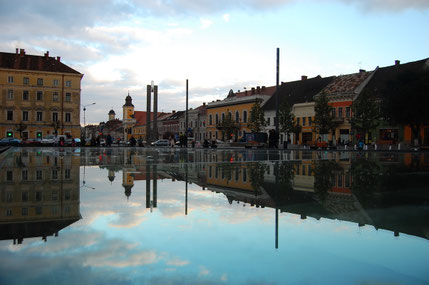
The Fortress Hill
The Fortress Hill is located north of the historical centre, at an altitude of 405 meters, and has the appearance of a plateau, on which the Habsburgs built the first Vauban style fortification in Transylvania, in the 18th century and used to house the administrative buildings, the garrison and the weapons store. Of the initial fortress, which gave the name of the hill, only part of the walls, four buildings and two gates remain.
Nowadays the Fortress Hill represents also a Panoramic Point which offers a great view over the city.

The “Alexandru Borza” Botanical Garden and the Botanical Museum
Founded in 1910, it is nowadays one of the most beautiful and complex of its kind in Southeastern Europe. The Botanical Garden , spreading more than 14 ha, holds attraction points such as the Japanese and the Roman gardens, along with the complex of greenhouses displaying equatorial and tropical plants. The Botanical Museum and the “Babeş-Bolyai” University Herbarium host 11.000 exhibits from all around the world.

The "Romulus Vuia” National Ethnographic Park
The National Ethnographic Park " Romulus Vuia ”, established in 1929, bears the name of its founder and first museum manager, Professor Romulus Vuia. The pieces exhibited are in fact old traditional buildings, grouped together according to their regional particularities, as well as folk architecture monuments, folk installations, craftsman workshops, wells, gateways, big wooden crosses and indoor textiles.

Representative festivals & traditional culture, arts
The city in the heart of Transylvania is a vibrant one, with unsual events that make you get out of the house and of your daily routine. Cluj-Napoca hosts a number of cultural festivals of various types: music, film, sport, opera, theater or food. These occur throughout the year, though are more frequent in the summer months.
The city has seen a number of important music events , including UNTOLD Festival, Electric Castle Festival, which takes place at Bánffy Castle near Cluj-Napoca, Delahoya, Jazz in the Park, Mioritmic and many others. Also the Cluj-Napoca City Days which are celebrated each year in May, the Transilvania International Film Festival, the Interferences International Theater Festival or Comedy Cluj, are very important for the citizens and tourists.
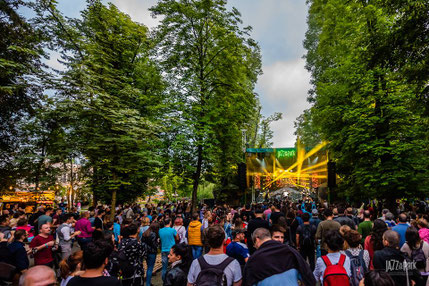
of Cluj-Napoca
- Destinations
Best in Europe
Best Destinations 2024
Best Romantic Destinations
Best ski resorts
Best Christmas markets 2024
Best beaches in Europe
Sustainable tourism in Europe
European Best Destinations
EDEN Destinations
Connect with us
Subscribe to discover latest travel inspiration, tips and deals from European Best Destinations.
My Newsletter
Best in Europe.
Your ultimate bucket list to travel in Europe

destinations 2024

Most exclusive
destinations

sustainable destinations

romantic destinations

fairy tale destinations

places to visit Netherlands

Art Nouveau destinations

places to visit in Portugal

medieval destinations
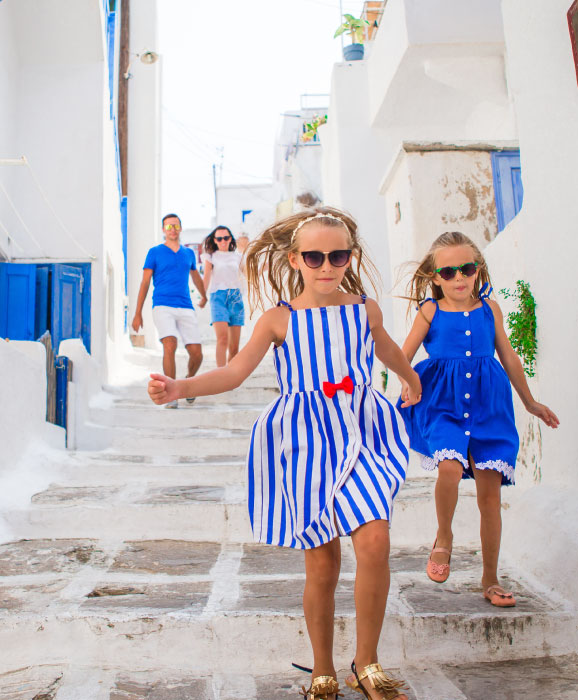
Family holiday

hidden gems

blue water destinations

for digital detox

Green Capitals

open-minded destinations

natural wonders in France

hidden gems in Italy

islands in Greece

things to do in Austria

European Best Destinations ®
- Scroll to top

- +40 264 450 410

Historical Monuments
Natural attractions, religious edifices, made in cluj, accommodation in cluj-napoca, accommodation in cluj county, transport and parkings, tourist information centers, travel agencies, 24h pharmacies, useful numbers, useful materials, discover cluj county.
Cluj county, covering an area of approximately 6.700 square kilometres, is located in the Northwestern part of Romania, within the contact area of three natural units: Apuseni Mountains, Someşan Plateau and Transilvania Plain. Preserving prominent historical legacies and specific Transylvanian influences, places here distinguish themselves by diversity and extent, remaining imprinted in the memory of all who explore them.
Cluj is among the most active counties in the cultural sector, being endowed with a valuable patrimony, an established reputation in education and culture, as well as prestigious institutions. The richness of monuments and historical spots, as well as the architectural and traditional heritage, most of all these included in the national circuit, stand for a certain and permanent tourism resource.
Furthermore, Cluj county benefits of a high touristic potential, reflected in a wide range of leisure activities: backpacking, mountain-climbing, balneary treatment, winter and summer sports or youth camps. All these attractions of Cluj county qualify it as an ideal destination which offers multiple possibilities, both for spending free time, as well as concerns business development within various areas of activity.
So, let’s start our unforgettable journey in Cluj county …
EVENTS IN CLUJ
To visit in cluj county.
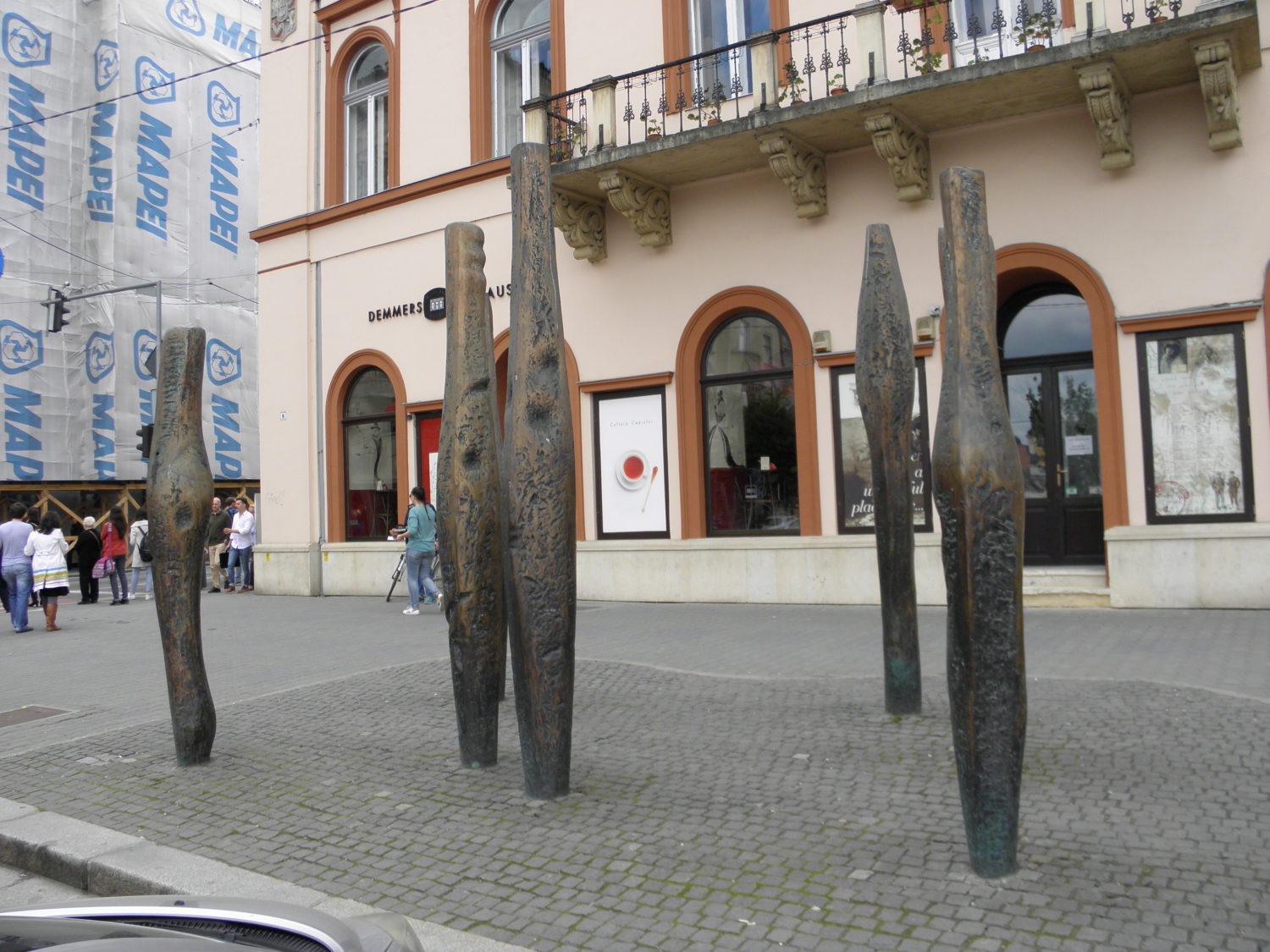
PARKS AND GARDENS

MONASTERIES

Gorges-Passes-Valleys
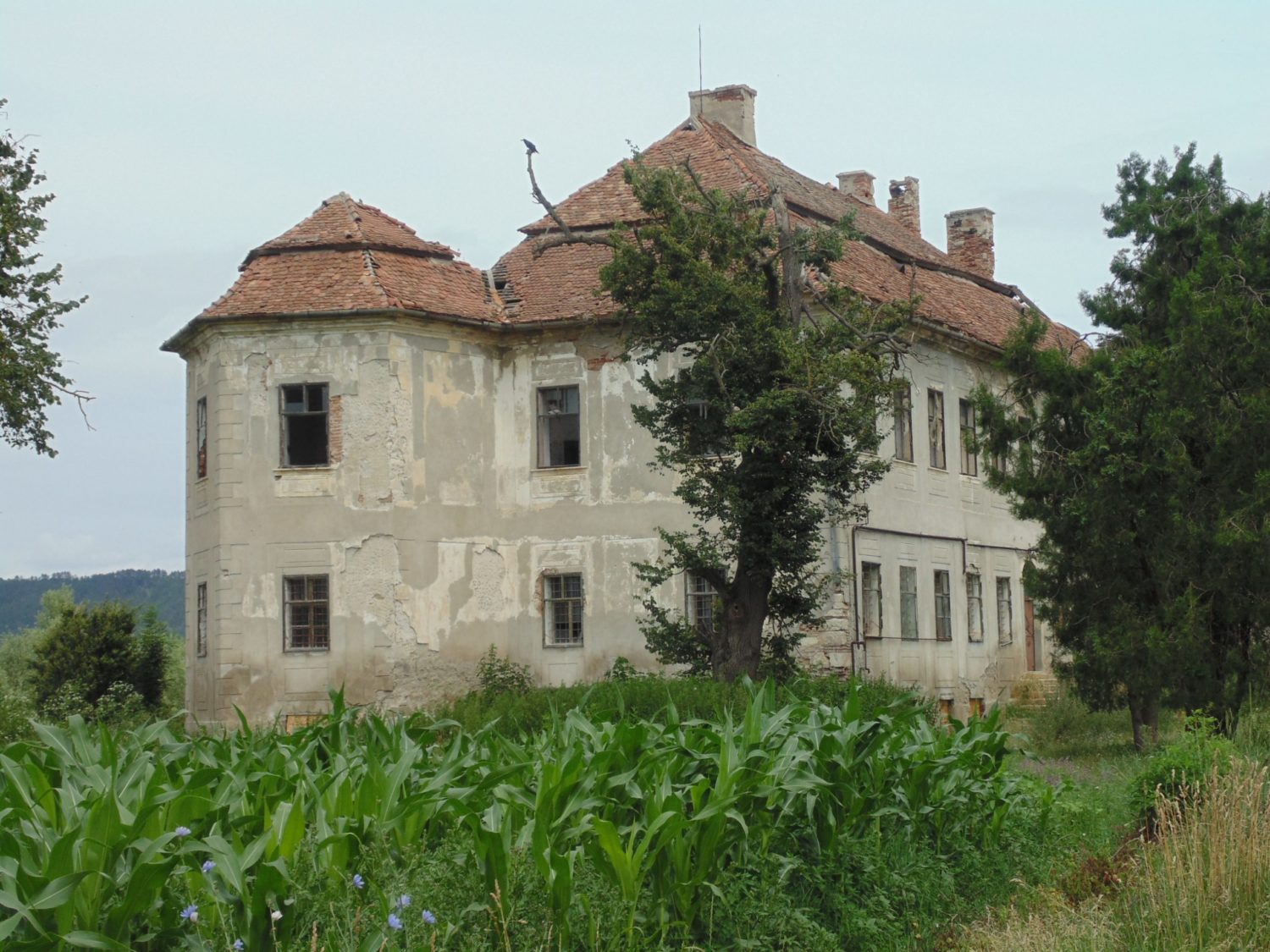
Bride’s Veil Waterfall
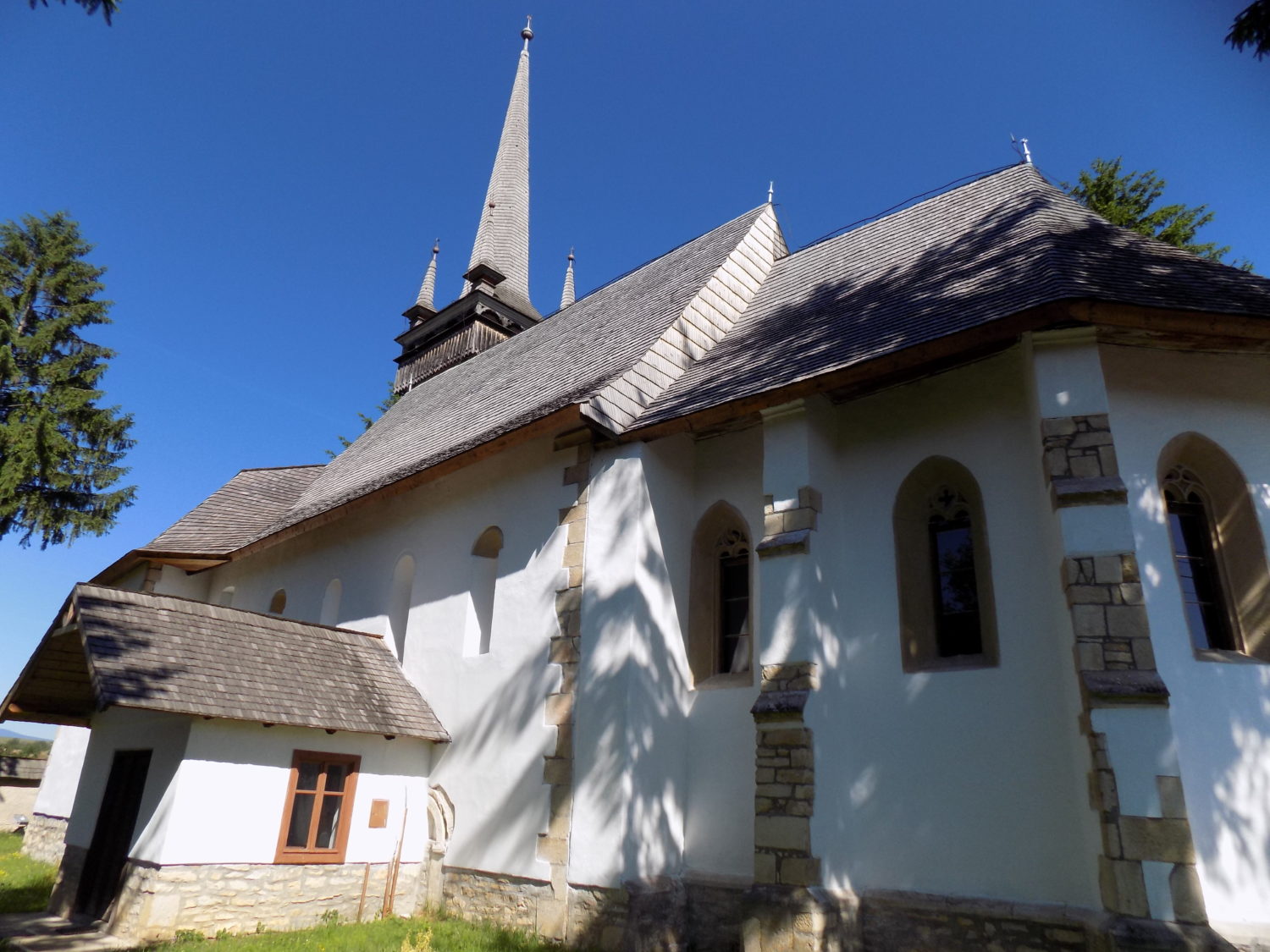
Mănăstireni Reformed-Calvinist Church
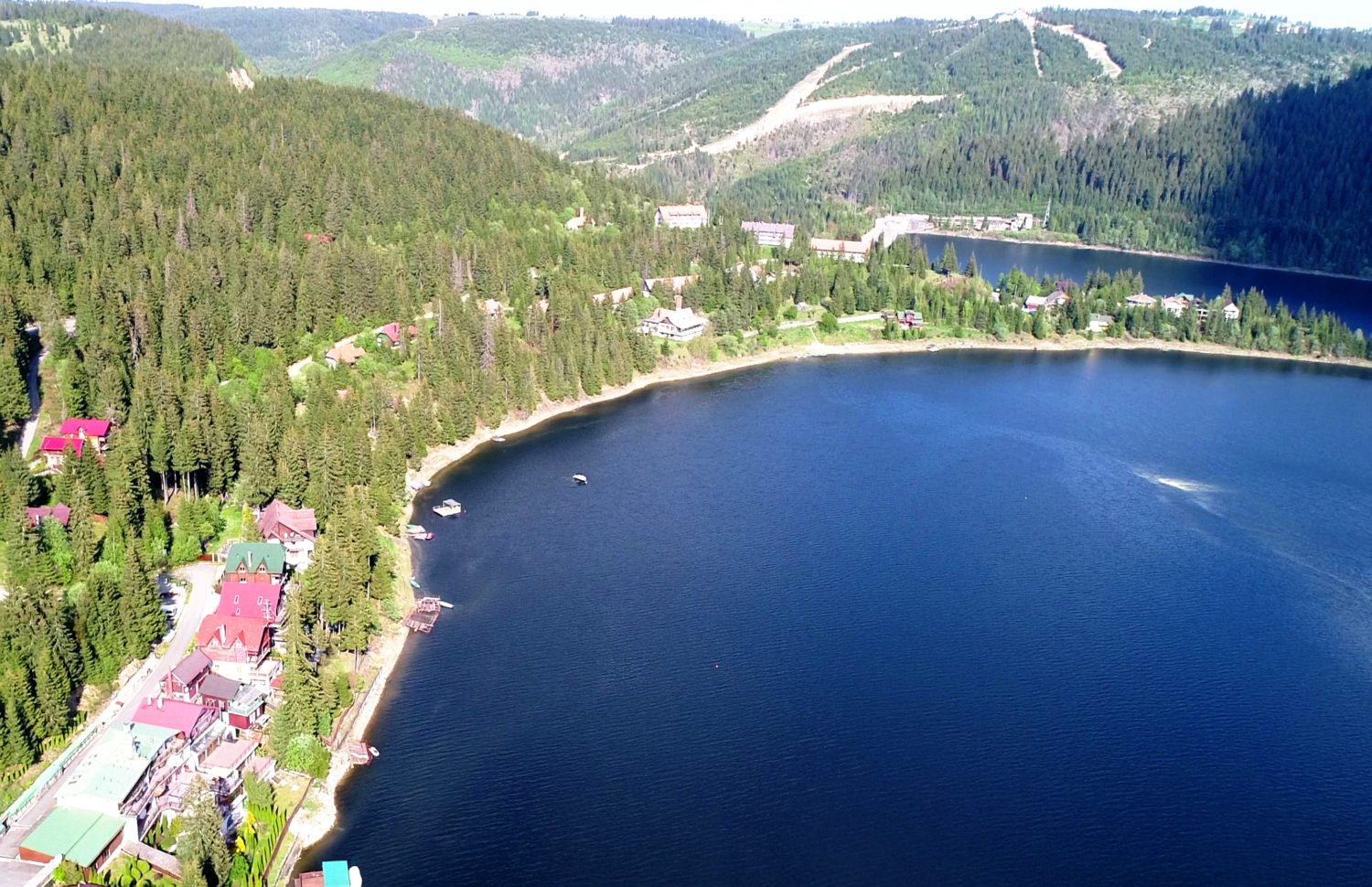
Beliş – Fântânele Lake

Cluj-Napoca Central Cemetery
To do in your free time.

RESTAURANTS

SHOPPING CENTERS

CULTURAL CENTERS

TURDA SALT MINE
To taste in cluj, restaurants.
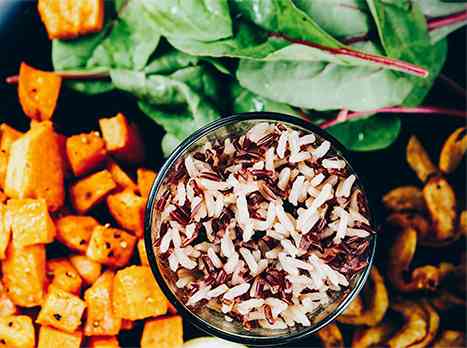
Traditional Restaurants
Follow us on instagram.


IMAGES
VIDEO
COMMENTS
per adult (price varies by group size) Retezat mountains trekking tour from Cluj-Napoca. Rail Tours. from. $1,199. per group (up to 15) Paddle and Hike A Day Trip on the Stunning Lakes of Carpathians. Kayaking Tours. from.
1. Admire the view of the entire town from Cetatuia Hill. Cetatuia is included in most top lists of things to see in Cluj for a good reason. It offers one of the most spectacular and romantic views; and it can also turn into an exciting adventure. Cetatuia Hill is, as its name claims, a 405m tall hill.
1. St Michael's Church. Cluj-Napoca's heavyweight sight is this stunning 15th-century Gothic church on Unirii Square. With three equal naves, and measuring 70 metres long and 80 metres high, few churches in Romania can match St Michael's for power as well as sheer depth of history.
Admire the architectural mix of Cluj-Napoca. 3. Take a stroll on the main street, Eroilor Boulevard. 4. Visit Union Square and its landmarks. 5. Enjoy nature in Central Park. 6. Discover the interwar architecture of Cluj and enjoy Somes River.
The top attractions to visit in Cluj-Napoca are: Cheile Turzii; Central Park Simion Bărnuțiu; Grădina Botanică "Alexandru Borza" Cetățuia Hill (Dealul Cetățuia) Rex Matia Corvin Statue; See all attractions in Cluj-Napoca on Tripadvisor
Cluj-Napoca. An encyclopedic collection of bottled, jarred and taxidermied specimens from butterflies to waterfowl. Discover the best attractions in Cluj-Napoca including Fabrica de Pensule, St Michael's Church, and Parcul Etnografic Romulus Vuia.
The best outdoor activities in Cluj-Napoca according to Tripadvisor travellers are: Cheile Turzii; Central Park Simion Bărnuțiu; Grădina Botanică "Alexandru Borza" Cetățuia Hill (Dealul Cetățuia) TransyBike - Day Tours; See all outdoor activities in Cluj-Napoca on Tripadvisor
Welcome to the social heart of Cluj Napoca! Unirii Square (or Piata Unirii) is the largest square in the city, and one of my favorite spots! Set in the Old Town, the Union Square is home to many major attractions dear to my heart, including the famous St Michael's Church, an astonishing 15th-century piece of Gothic architecture set just opposite the Matthias Corvinus Monument.
We've made a list of the top attractions in Cluj-Napoca, Romania, for you! 1. Explore Hoia-Baciu, One Of The Most Haunted Forests In The World. ... Both are among the greatest Cluj tourist attractions and come highly recommended. The indoor exhibition is located in Palais de la Redoute. Visitors will find a huge collection of items used ...
Lively old town. The historic centre around Unirii Square, the largest square in Cluj, is beautiful. Look out for the Hotel Melody Central.It opened in 1890 as a hotel but has also been a jazz ...
The Cluj-Napoca Botanical Garden spans 14 hectares in central Cluj-Napoca at Strada Republicii. It houses around 10,000 species of plants from around the world for kids to discover. Notable attractions include the Japanese Garden, greenhouse with tropical plants, rosarium and Roman Garden with a statue of the goddess Ceres.
The first Steampunk Museum and Fantasy House in Europe. See full details. 10. Iulius Mall Cluj. 115. Shopping Malls. IULIUS MALL CLUJ is the third shopping mall in the IULIUS national network, being permanently attuned to international trends by means of its portfolio of brands and the leisure options.
2. Visit the Botanical Garden. A visit to the Botanical Garden is one of the great things to do in Cluj-Napoca for a first-time visitor. One of the must-see attractions, the Botanical Garden was founded by Professor Alexandru Borza from the University of Cluj-Napoca back in 1925. It's today one of the most popular places in the city, with ...
There are many beautiful old buildings scattered across Cluj and one of the most prominent ones is Biserica Piaristă Cluj-Napoca, a beautiful Baroque-style church located in the southern part of Cluj's old town.The church was built in the mid-18th century as one of the first Catholic churches in Transylvania, featuring a stunning facade painted with an eye-catching orange color adorned with ...
The best outdoor activities in Cluj-Napoca according to Tripadvisor travellers are: Cheile Turzii; Central Park Simion Bărnuțiu; Grădina Botanică "Alexandru Borza" Cetățuia Hill (Dealul Cetățuia) TransyBike - Day Tours; See all outdoor activities in Cluj-Napoca on Tripadvisor
Things to Do in Cluj-Napoca, Romania: See Tripadvisor's 41,075 reviews & photos of 265 Cluj-Napoca attractions.
This complete travel guide to Cluj includes famous landmarks, off the beaten path attractions and things to do, where to eat recommendations, and tips. Cluj - panorama. Cluj-Napoca, or just simply Cluj, is the second city after the capital, Bucharest, with regards to population and the unofficial capital of the region commonly known as ...
If you agree with us, these are best attractions in Cluj Napoca when talking about shopping: 1. Iulius Mall Cluj Napoca. Shopping: over 60, amongst which ZARA, The Body Shop, Sephora, Massimo Dutti, Guess. Dining: over 30, amongst which Dashi Japanese, Cartofiserie, Salad Box, Chopsticks.
2 The best things to do in Cluj! 2.1 Take in the views from Parcul Cetátuia. 2.2 Admire the National Opera House. 2.3 People-watch in Piata Unirii Square. 2.4 Visit St. Michael's Church and the statue of Matthias Corvinus. 2.5 Check out the stunning Dormition of the Theotokos Cathedral.
Thing to see in Cluj Napoca: Matei Corvin's House. One of the best-known tourist attractions in Cluj and also the oldest, since people coming here, would want to visit it from as early as the 18 th century; the Matia House is known to be the birthplace of Matei Corvin or Matthias in Hungarian.
Tel: (+4) 0264 595.992. Free walking tour of Cluj Napoca with a local guide. Visit Transylvania's largest city - Cluj Napoca - vith a local guide. When: every day, rain or shine, at 11 a.m. and 6 p.m., reservation required. Tour starts: at Piata Unirii, in front of Matthias Corvinus statue.
Discover Cluj-Napoca, one of the best destinations to visit in Europe. Cluj-Napoca has a special charm, given by the 2000 years history, the geographical location and the people, because here, time flows differently, and the people take the time to say hello to each other, to walk between the boomed trees in the Botanical Garden, to watch the reflection of the sun beams in the twin buildings ...
Furthermore, Cluj county benefits of a high touristic potential, reflected in a wide range of leisure activities: backpacking, mountain-climbing, balneary treatment, winter and summer sports or youth camps. All these attractions of Cluj county qualify it as an ideal destination which offers multiple possibilities, both for spending free time ...